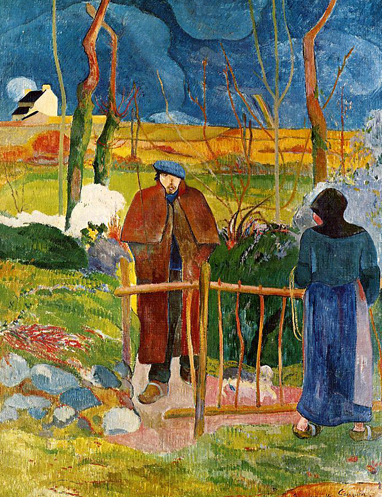
Paul Gauguin
French Post-Impressionist Artist
1848 - 1903

Bonjour, Monsieur Gauguin: 1889
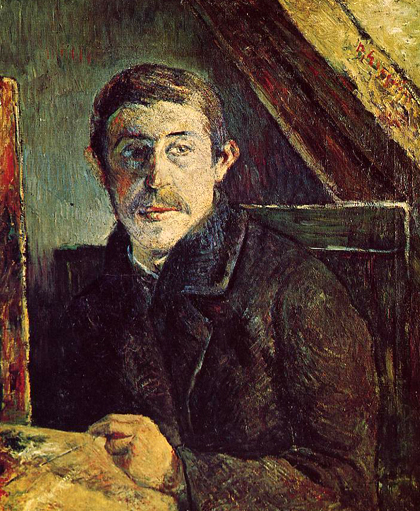
Gauguin at His Easel: 1885
Eugène Henri Paul Gauguin was a leading French Post-Impressionist artist. He was an important figure in the Symbolist Movement as a painter, sculptor, print-maker, ceramist, and writer. His bold experimentation with coloring led directly to the Synthetist Style of modern art while his expression of the inherent meaning of the subjects in his paintings, under the influence of the cloisonné's style, paved the way to Primitivism and the return to the pastoral. He was also an influential proponent of wood engraving and woodcuts as art forms.
Paul Gauguin was born in Paris, France to journalist Clovis Gauguin and Alina Maria Chazal, daughter of the half-Peruvian proto-socialist leader Flora Tristan, a feminist precursor. In 1851 the family left Paris for Peru, motivated by the political climate of the period. Clovis died on the voyage, leaving three-year old Paul, his mother and sister to fend for themselves. They lived for four years in Lima with Paul's uncle and his family. The imagery of Peru would later influence Gauguin in his art.
At the age of seven, Gauguin and his family returned to France. They moved to Orléans to live with his grandfather. He soon learned French and excelled in his studies. At seventeen, Gauguin signed on as a pilot's assistant in the merchant marine to fulfill his required military service. Three years later, he joined the French navy where he stayed for two years. In 1871, Gauguin returned to Paris where he secured a job as a stockbroker. In 1873, he married a Danish woman, Mette-Sophie Gad. They had five children over the next ten years.

Madame Mette Gauguin in an Evening Dress: 1884
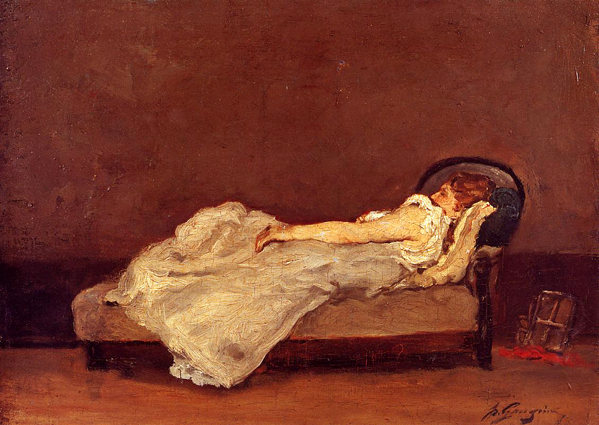
Mette Asleep on a Sova: 1875
By 1884 Gauguin had moved with his family to Copenhagen, Denmark, where he pursued a business career as a stockbroker. Driven to paint full-time, he returned to Paris in 1885, after his wife and her family asked him to leave. Gauguin outlived two of his children. Like his friend Vincent van Gogh, with whom in 1888 he spent nine weeks painting in Arles, Paul Gauguin experienced bouts of depression and at one time attempted suicide. He made several attempts to find a tropical paradise where he could 'live on fish and fruit' and paint in his increasingly primitive style, including short stays in Martinique and as a laborer on the Panama Canal Construction; however, he was dismissed from his job after only two weeks. In 1891, Gauguin, frustrated by lack of recognition at home and financially destitute, sailed to the tropics to escape European civilization and "everything that is artificial and conventional". His time there, particularly in Tahiti and the Marquesas Islands, was the subject of much interest both then and in modern times due to his alleged sexual exploits. He was known to have had trysts with several prepubescent native girls, some of whom appear as subjects of his paintings.

Mango Pickers, Martinique: 1887

Marahi Metua no Tehamana
(aka Tehamana Has Many Ancestors): 1893
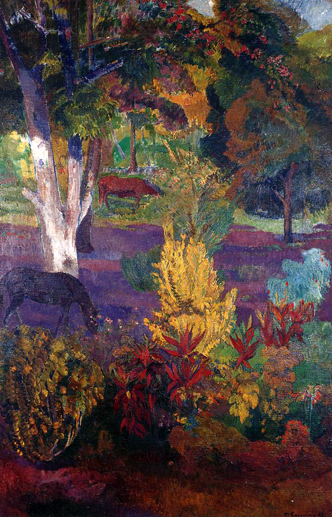
Marquesan Landscape with a Horse: 1901
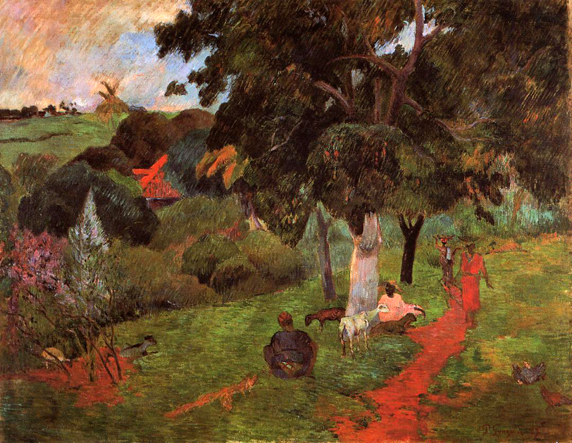
Martinique Landscape
(aka Comings and Goings): 1887
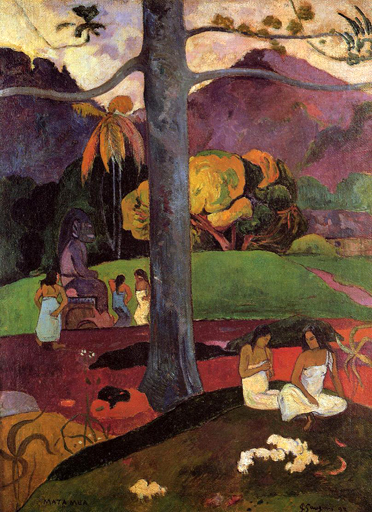
Mata Mua
(aka In Olden Times): 1892
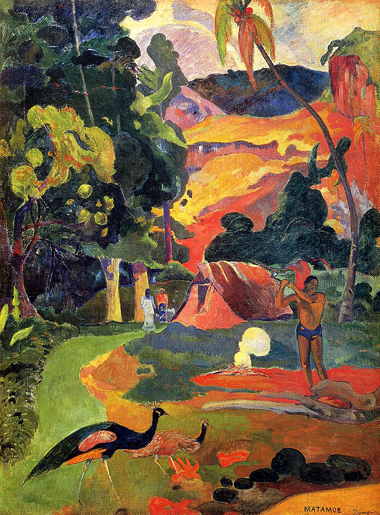
Matamoe
(aka Landscape with Peacocks): 1892
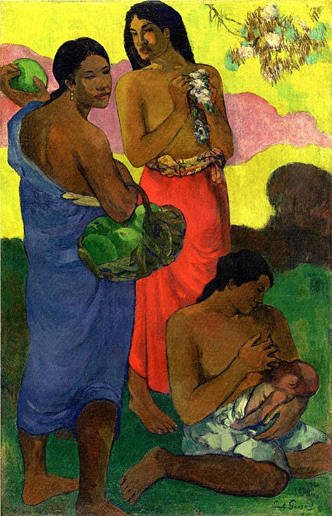
Maternite II: 1899

Maternity
(aka Three Woman on the Seashore): 1899

Mau Taporo
(aka The Lemon Picker): 1891
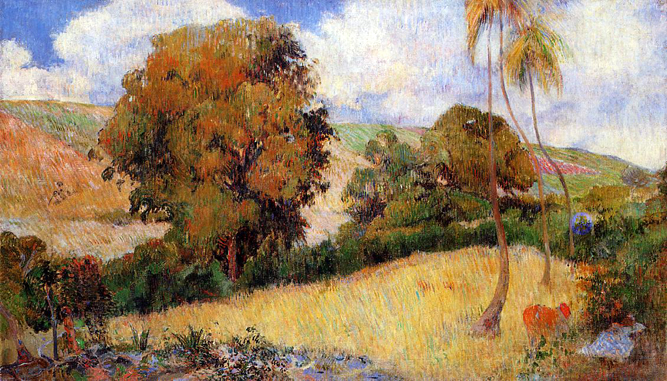
Meadow in Martinique: 1887

Meu Taporo
(aka Picking Lemons): 1892
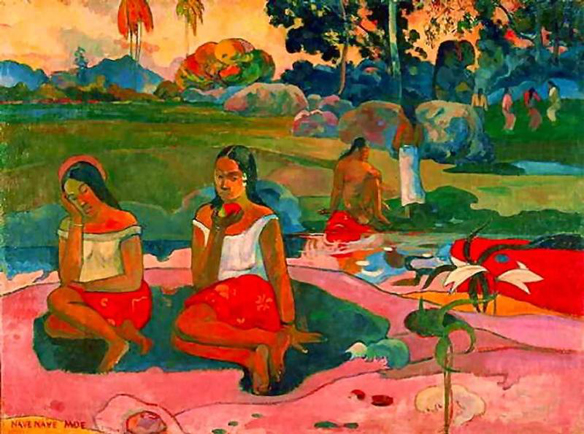
Miraculous Source: 1894

Mountains in Tahiti: ca 1891

Musique barbare: ca 1891-93
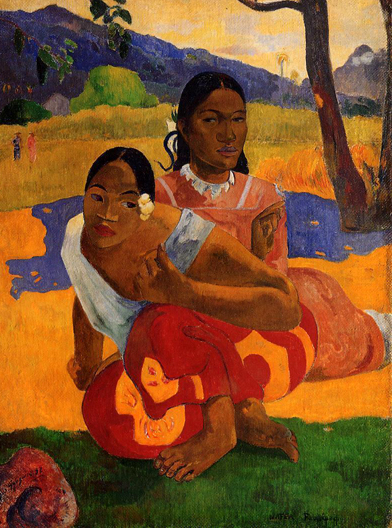
Nafeaffaa Ipolpo
(aka When Will You Marry?): 1892
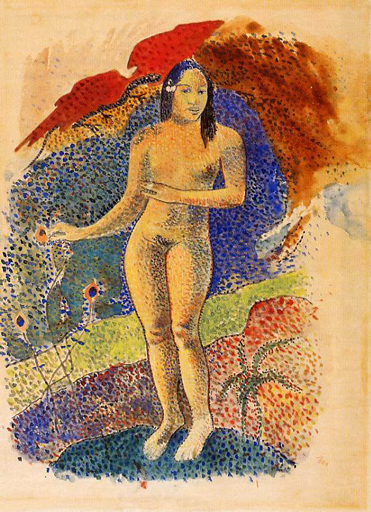
Nave nave feuna L'EveTahitienne
(aka Beautiful Land, Tahitian Eve): 1892
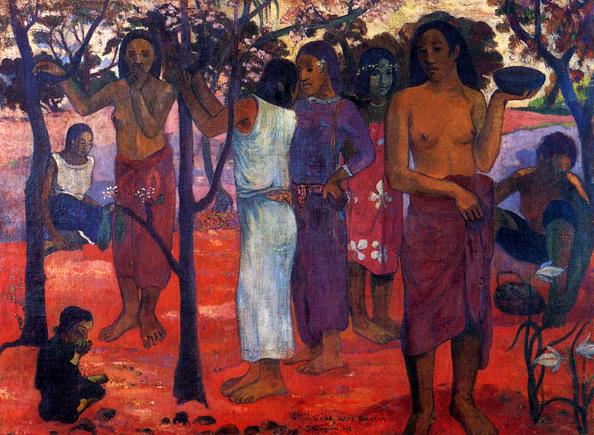
Nave Nave Mahana
(aka Delightful Day): 1896

Nave Nave Moe
(aka Delightful Drowsiness): 1894
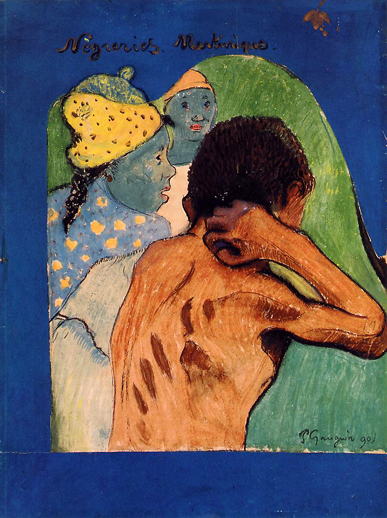
Negreries Martinique: 1890
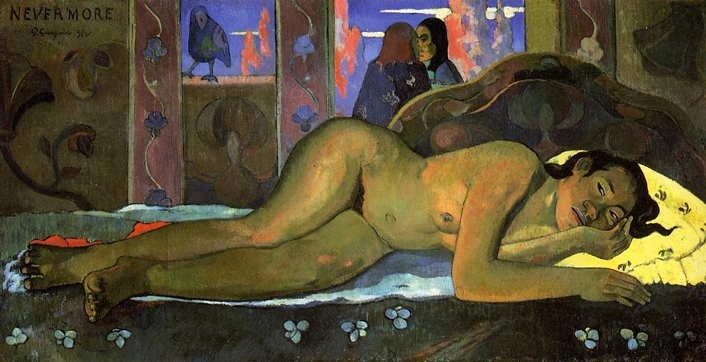
Nevermore, Oh Tahiti: 1897
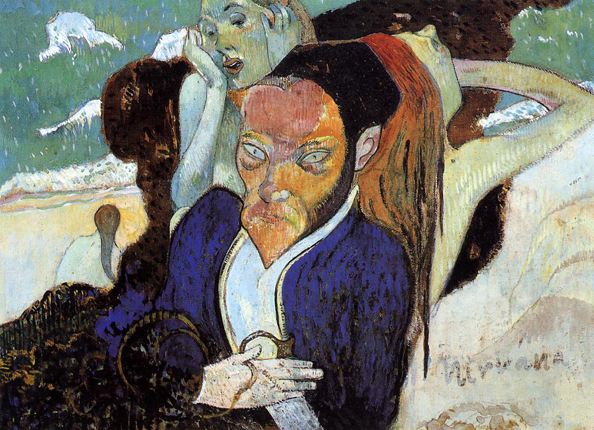
Nirvana
(aka Portrait of Meyer de Hasn): ca 1890
Jacob Meyer de Haan, Dutch painter, student and close friend of Gauguin. In summer of 1889 they stayed together at an inn in Le Pouldu, near Pont Aven in Brittany. Meyer de Haan paid Gauguin's bills in return for painting lessons, and they both decorated the inn's dining room with paintings. The innkeeper Marie Henry, had a daughter by de Haan, and later played a negative role in Gauguin's life: she refused to return his works, which he had to keep in her inn for some time.
Quoted From: Paul Gauguin - Nirvana, Portrait of Meyer de Haan

No te aha oe Riri
(aka Why are You Angry?): 1896
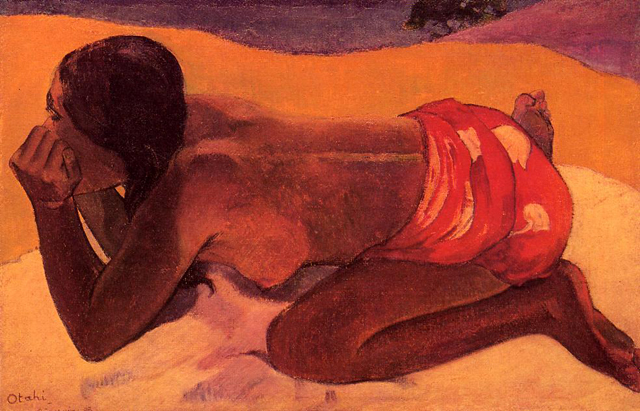
Otahi
(aka Alone): 1893
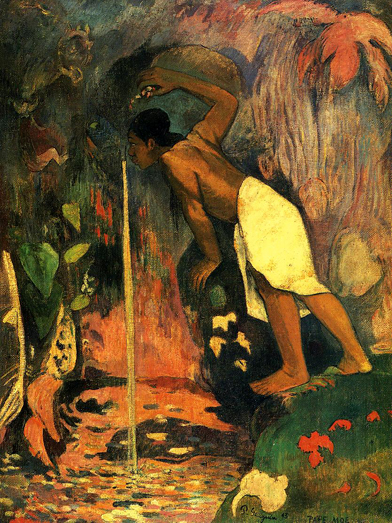
Pape Moe
(aka Mysterious Water): 1893
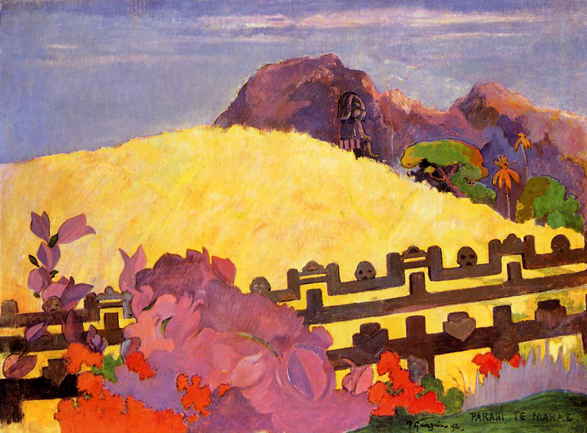
Parahi te Marae
(aka There Lies the Temple): 1892
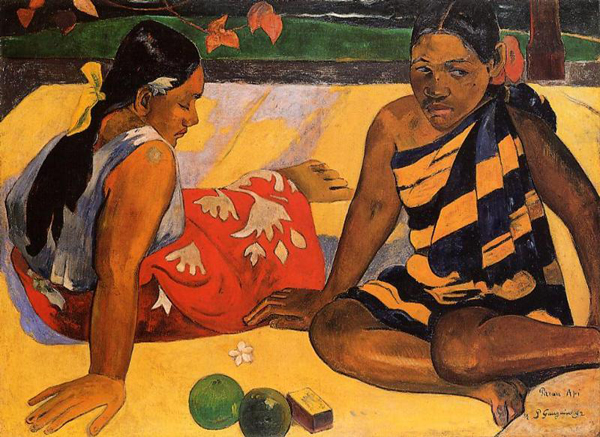
Parau api (aka What News?): 1892
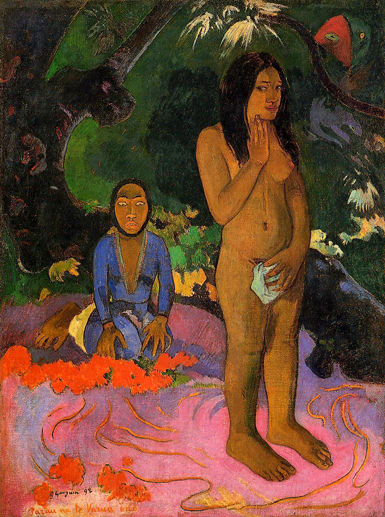
Parau na te varua ino
(aka Words of the Devil): 1892
It is unlikely that anyone who saw this painting when it was exhibited in Paris in 1893 would have understood the Tahitian legend Gauguin inscribed on it. Its symbolism remains complex. The masked kneeling figure is the varua ino of the title, a malevolent spirit who materializes as strange and frightening humanoid forms. The standing woman, on the other hand, is associated through her gestures evoking modesty and shame with western images of Eve after the fall. When Gauguin traveled to Polynesia, he took with him a collection of photographs-of Renaissance paintings, the Parthenon, the Buddhist temple of Borobudur-and often incorporated these images in his Tahitian painting.
Yet this is not simply a western theme in Polynesian guise. Among the women of Tahiti, Gauguin discovered profound spiritual forces at work. In this Polynesian Eve, he envisioned a channel through which spiritual energy entered the everyday world. Probably she represented knowledge of good and evil, of life and human morality-part of Gauguin's long fascination with life and death. At the upper right, under the curiously serpentine red and green face, Gauguin inserts himself into the scene with the depiction of a sketchy hand, an emblem he used also in self-portraits.
Quoted From: (NGA) - Parau na te Varua ino (Words of the Devil), 1892
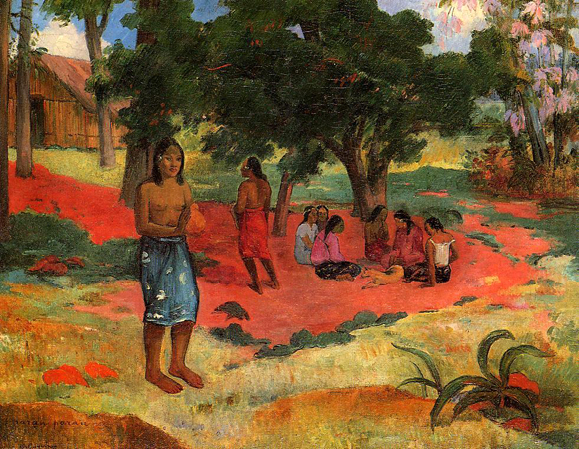
Paru Paru
(aka Whispered Words II): 1892
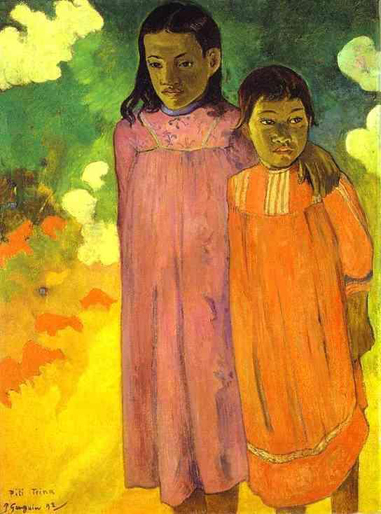
Piti teina
(aka Two Sisters): 1892

Rave te htit aamy
(aka The Idol): 1898

Riders on the Beach: 1902

River under the Trees, Martinique: 1887
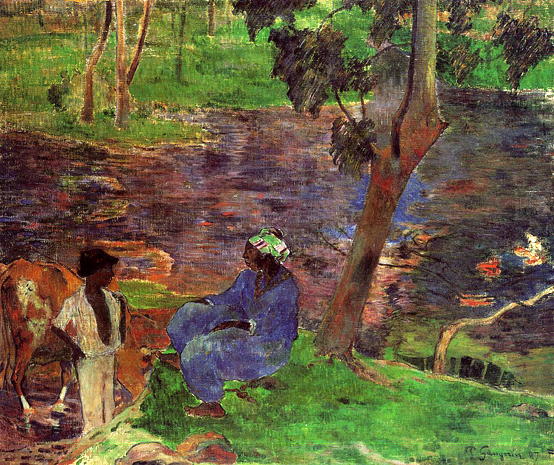
Riverside: 1887
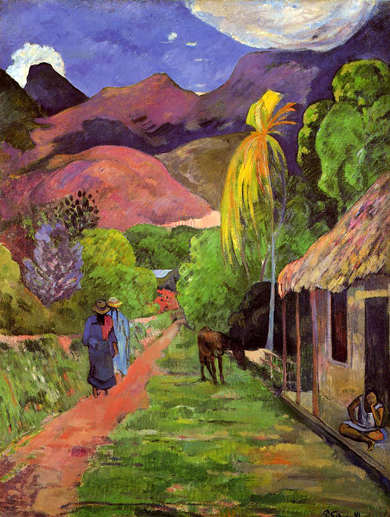
Road in Tahiti: 1891

Savage Poems: 1896
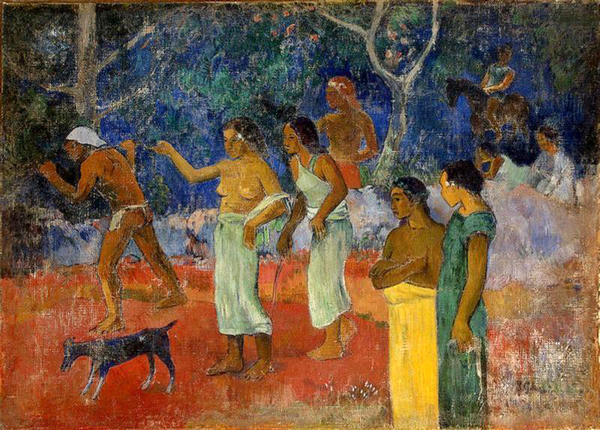
Scenes from Tahitian Live: 1895

Seashore, Martinique: 1887
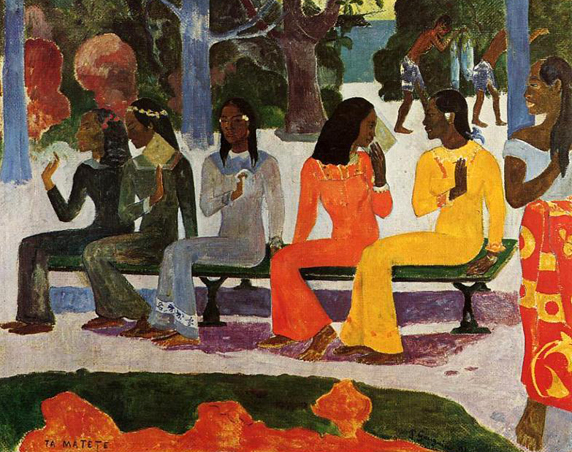
a Matete
(aka The Market): 1892

Tahitian Landscape: 1893
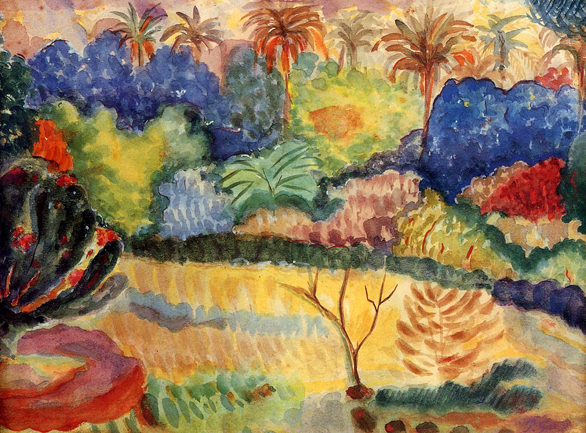
Tahitian Landscape: ca 1897

Tahitian Man with His Arms Raised: 1897
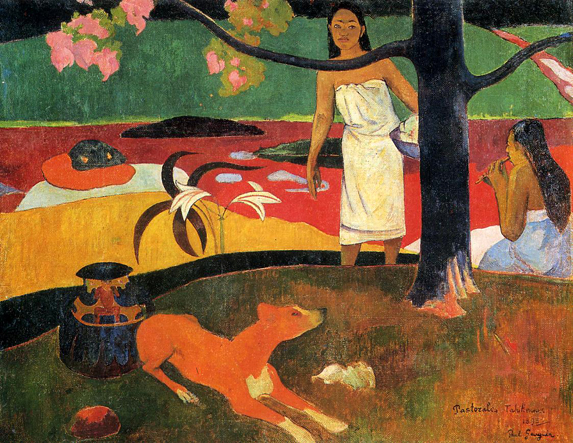
Tahitian Pastorals: 1893

Tahitian Scene: 1891-93

Tahitian Village: 1892
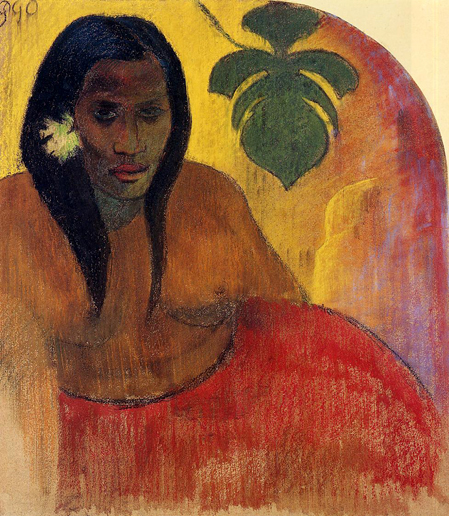
Tahitian Woman: 1893-94
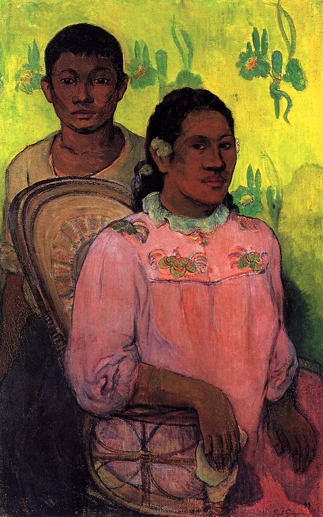
Tahitian Woman and Boy: 1899
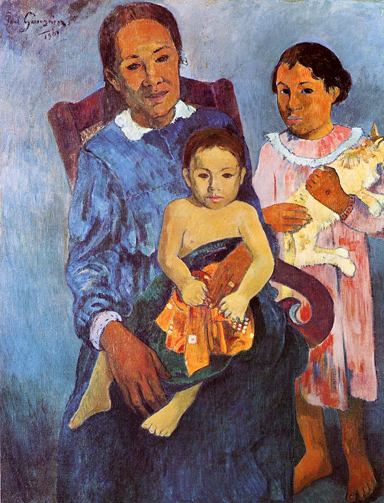
Tahitian Woman and Two Children: 1901
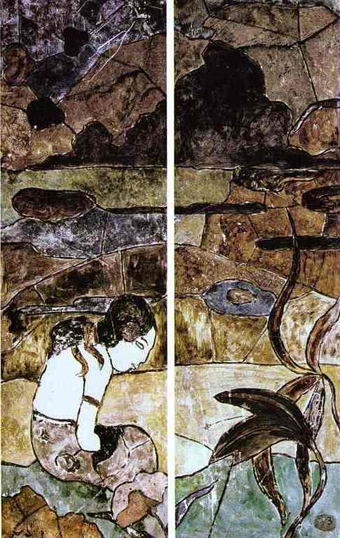
Tahitian Woman in a Landscape: 1893
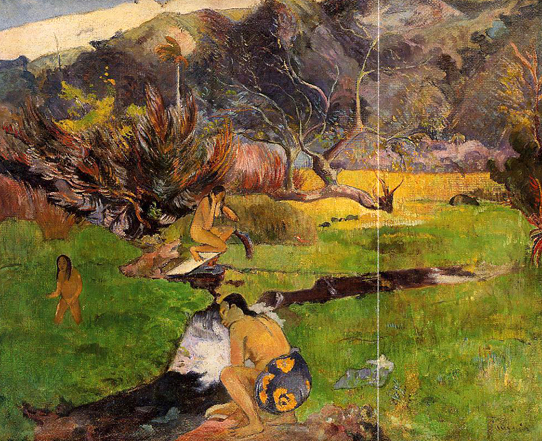
Tahitian Woman near a River: 1893
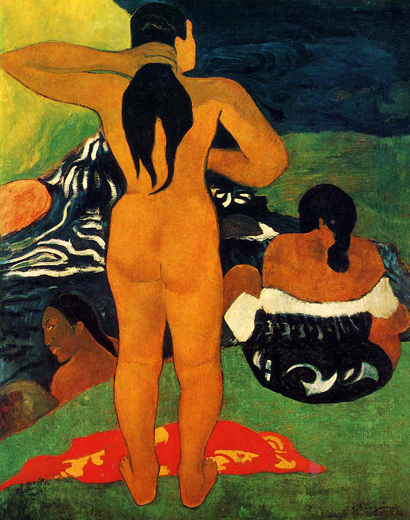
Tahitian Women Bathing: 1892
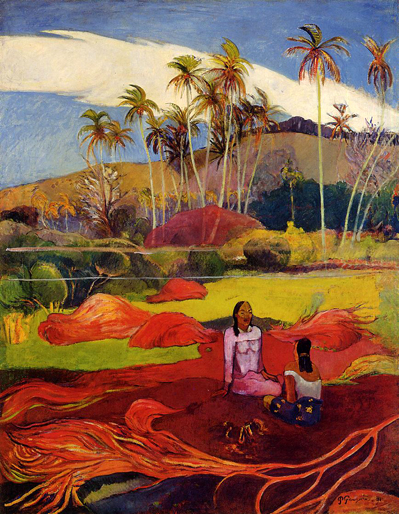
Tahitian Women under the Palms: 1892
_1891.jpg)
Tahitians at Rest (unfinished): 1891

Taperaa Mahana: 1892

Te Aa No Areois
(aka The Seed of Areoi): 1892
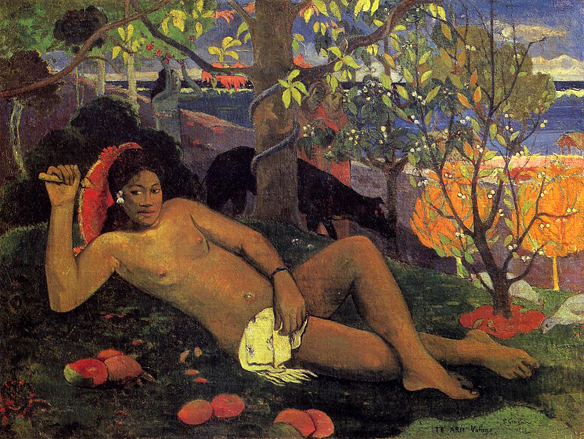
Te Arii Vahine
(aka The King's Wife): 1896
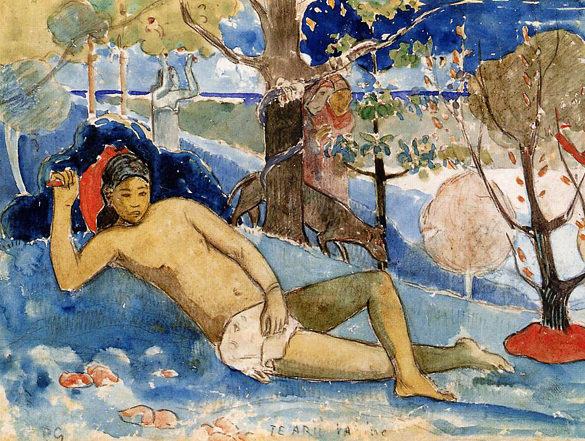
Te Arii Vahine
(aka The Queen of Beauty): ca 1896-97
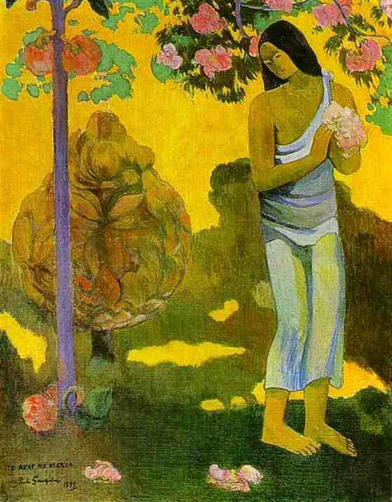
Te Avae No Maria (aka Month of Mary): 1899
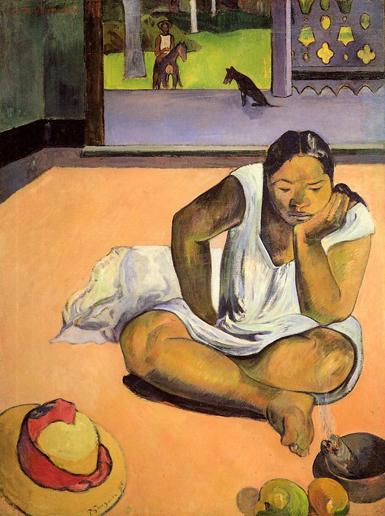
Te Faaturuma
(aka The Brooding Woman): 1891

Te faruru
(aka The Encounter): 1892
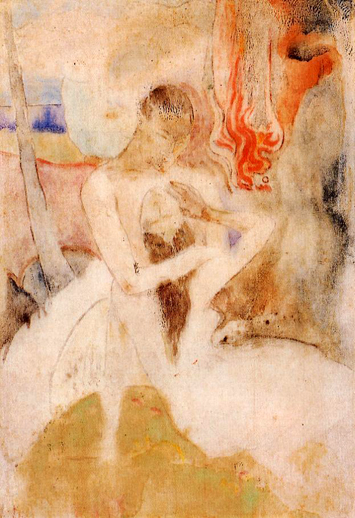
Te Faruru: ca 1894

Te papa nave nave
(aka Delectable Waters): 1898
In 1898, Gauguin sent a group of works from Tahiti for exhibition in Paris. The centerpiece was a painting more than twelve-feet long on hemp sacking material with the French inscription, "Where do we come from? What are we? Where are we going?" (Museum of Fine Arts, Boston). Intended to be seen with it were eight smaller works based on motifs excerpted from Where are we going? These were not preparatory studies but variations painted after the larger work was completed. They represented a kind of rethinking or perhaps summing up by the artist. This painting is one of these smaller works.
One figure that recurs from the larger work is the blue goddess. She is the deity Hina, prominent in an ancient Polynesian creation myth, whom Gauguin represented in sculpture and painting repeatedly. Gauguin's interpretation of her appearance is based upon a variety of sources from Hindu and South Asian art and culture. Gauguin described Hina as an emblem of the "hereafter," alluding to both the cycles of life represented in the work (by the infant and old woman) and his stated intention that the grouping of work would be his final artistic statement. Experiencing numerous maladies, financial problems, and depression, he intended to commit suicide when the work was finished (he died several years later at age 54 from a variety of diseases he had contracted). Despite these seemingly explicit biographical interpretations, this painting and related canvases, like much of Gauguin's work, retain a sense of mystery. "Known symbols would congeal the canvas into a melancholy reality," he wrote, "and the problem indicated would no longer be a poem."
Quoted From: (NGA) - Te Pape Nave Nave (Delectable Waters), 1898
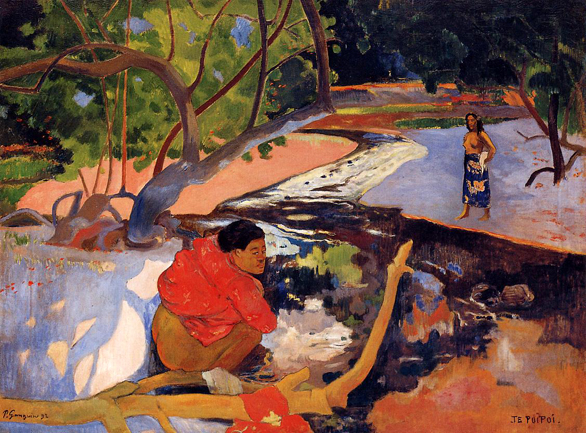
Te Poipoi: 1892
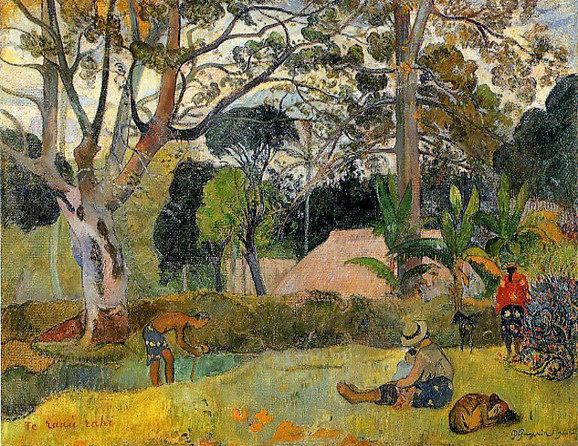
Te raau rahi
(aka The Big Tree): 1891
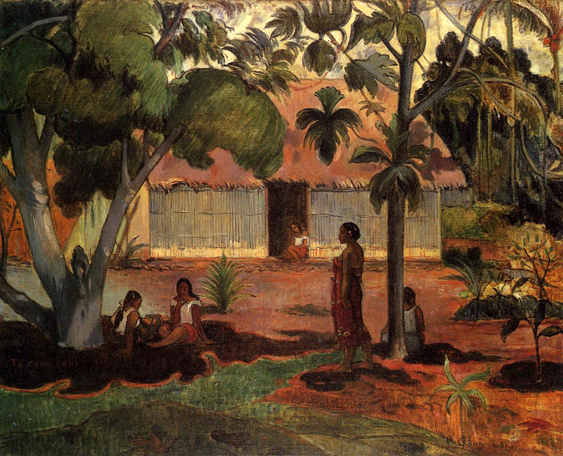
Te Ra-au Rahi
(aka The Large Tree): 1891
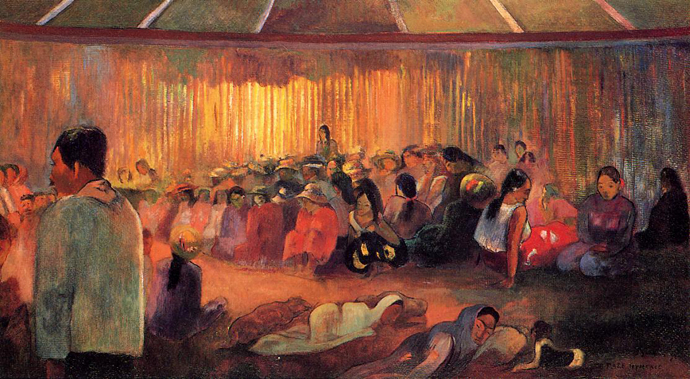
Te Rare Hymenee
(aka The House of Hymns): 1892
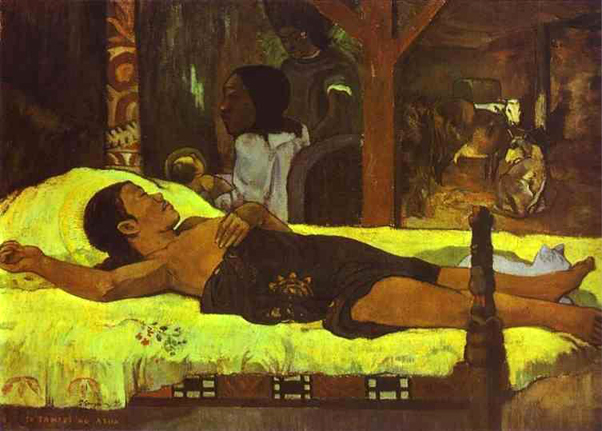
Te tamari no atua
(aka Nativity): 1896
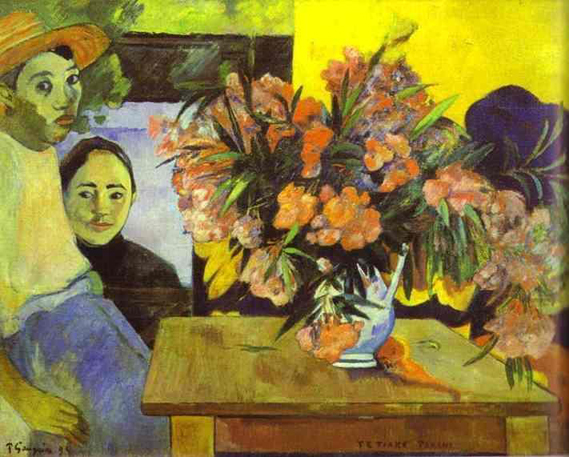
Te tiare farani
(aka Bouquet of Flowers): 1893

Thatched Hut under Palm Trees: ca 1896-97
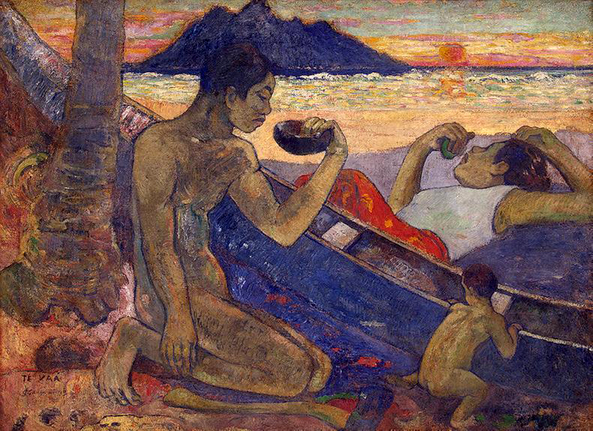
The Canoe, A Tahitian Family): 1896
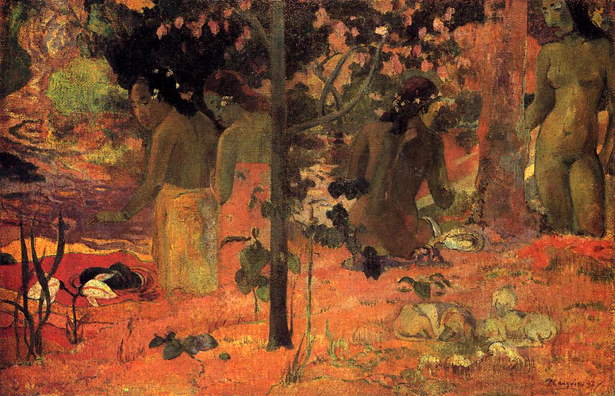
The Bathers: 1897
Like Te Pape Nave Nave, this work was painted after Gauguin's return to Tahiti from Paris. Notice how the colors of these later pictures are nuanced, more blended than the flatter, more intense hues found in the two earlier ones. He has still outlined many of his shapes, yet they nonetheless appear softer, and the large areas of colors are neither so bold nor so distinct. Here, especially, the coarse texture and heavy weave of the canvas add a tapestry like effect. Whereas the earlier works from Tahiti are vivid and direct, those painted during this second trip have a more dreamlike appearance and spiritual intensity. The figures are more monumental, with an aura of timelessness and dignity. And their color is more expressive.
Gauguin had always been preoccupied with the role of color, calling it a "profound and mysterious language, a language of the dream." He described its effects as akin to music and its relationships to musical harmonies. The gentle tones here-the soft mat of pinks that carpets the foreground, the swirls of lavender water-seem to be scented with the sweet perfumes of paradise. This is one of the most sumptuous of all Gauguin's paintings. The Bathers probably once belonged to Edgar Degas, who owned several works by Gauguin.
Quoted From: (NGA) - The Bathers, 1897
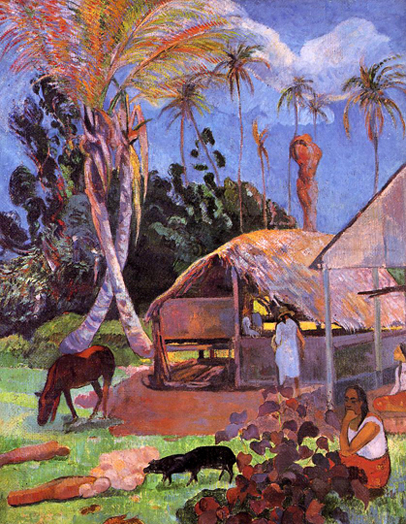
The Black Pigs: 1891
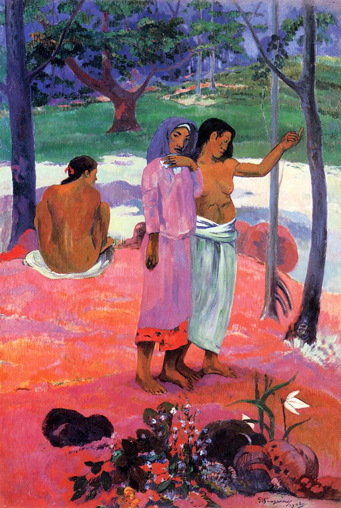
The Call: 1902
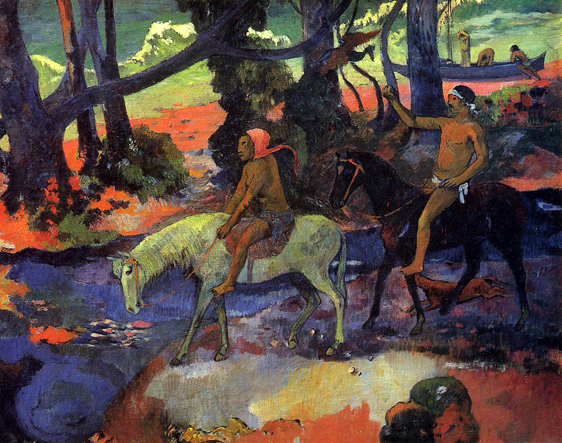
The Ford (aka Flight): 1901

The Great Buddah: 1897

The Loss of Virginity
(aka The Awakening of Spring): 1891
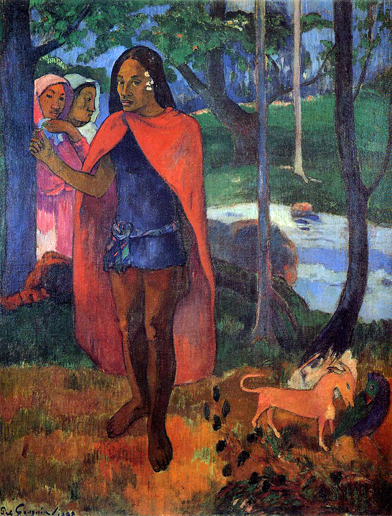
The Magician of Hivaoa: 1902
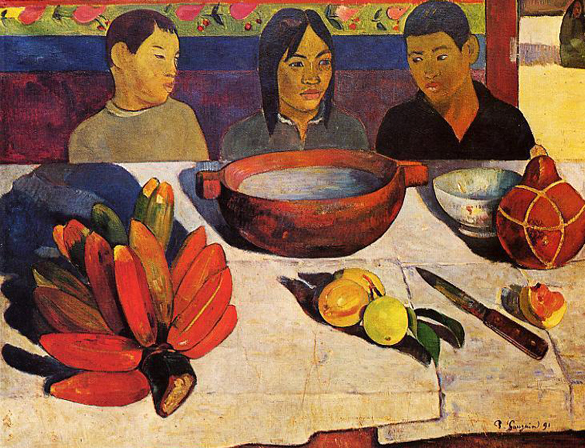
The Meal (aka The Bananas): 1891
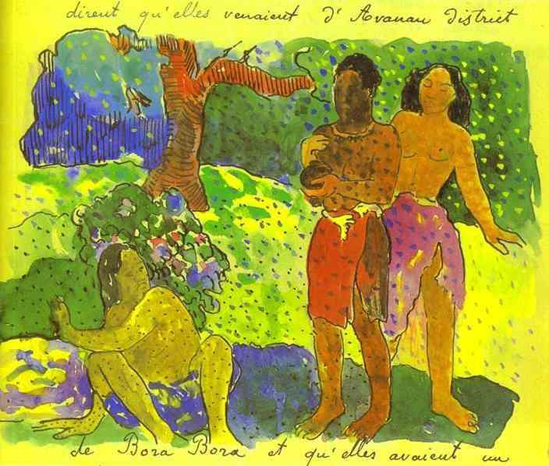
The Messengers of Oro: 1893
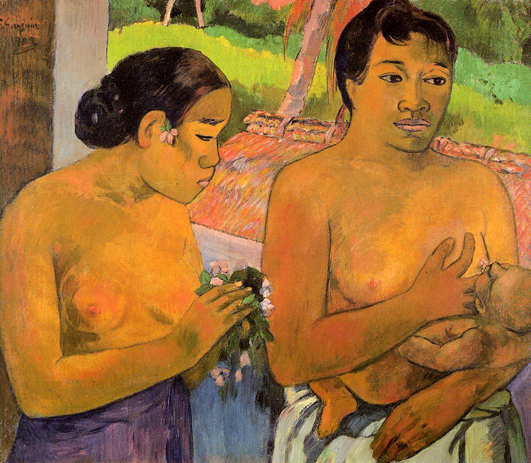
The Offering: 1902
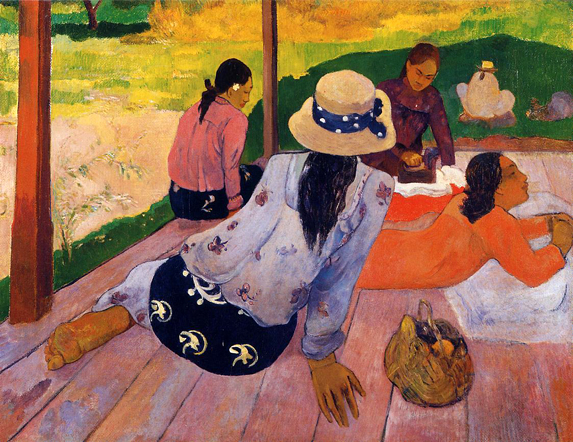
The Siesta: 1891-92
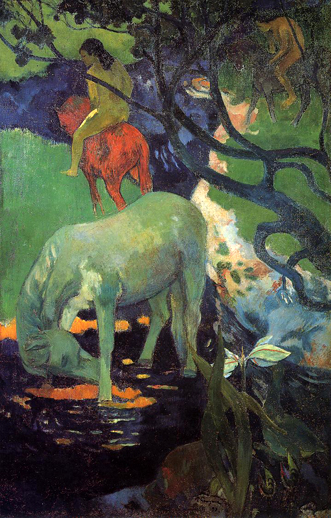
The White Horse: 1898
Although Gauguin was settled in Tahiti when he painted this superb picture, it does not primarily suggest a local connection but rather a final outcome of the sense of newly tapped powers in color and new sensations to be derived from it that had been the preoccupation of a whole half-century. T he seed of Impressionism, it might be said, expanded here into a marvelous exotic bloom. The color, however, is no longer descriptive or atmospheric but makes an impact on the senses akin to that of music. The White Horse itself suggests some creature of heroic fable, yet while it shares this appearance of belonging to an imaginary world with the riders in the background, the picture had its basis in Polynesian reality. The inhabitants used horses as a means of transport in the absence of roads and bridges. Bengt Danielsson, the anthropologist and historian, in his book Gauguin in the South Seas, makes this remark with special reference to the Marquesas where `everyone still rides a horse from the bishop down to the smallest native boy'. Gauguin did not move to the Marquesas until 1901 but as this picture shows the native horsemanship had already caught his attention.
Quoted From: WebMuseum - The White Horse

Three Huts, Tahiti: 1891-92
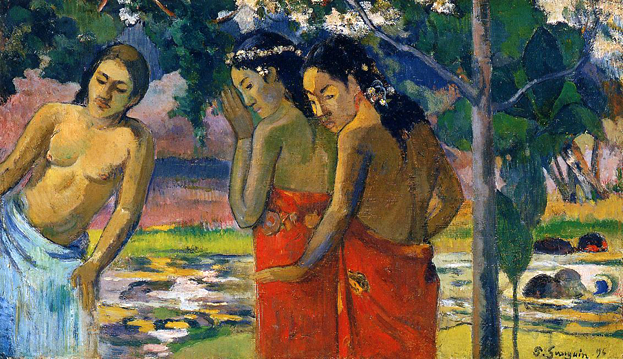
Three Tahitian Women: 1896
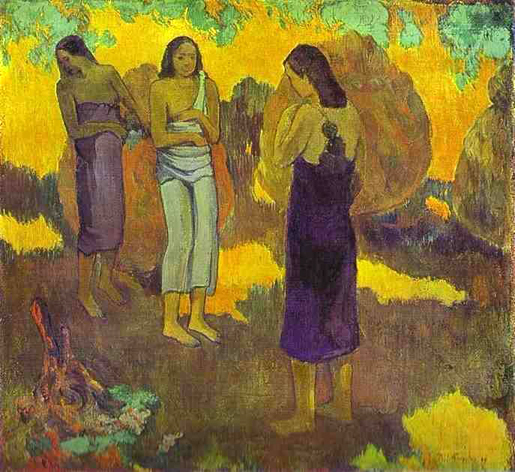
Three Tahitian Women against a Yellow Background: 1899
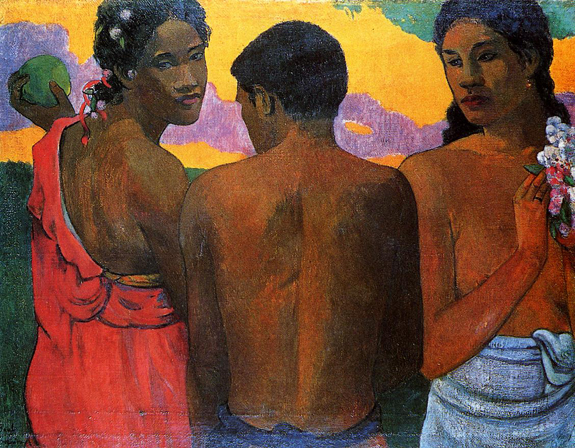
Three Tahitians: 1898
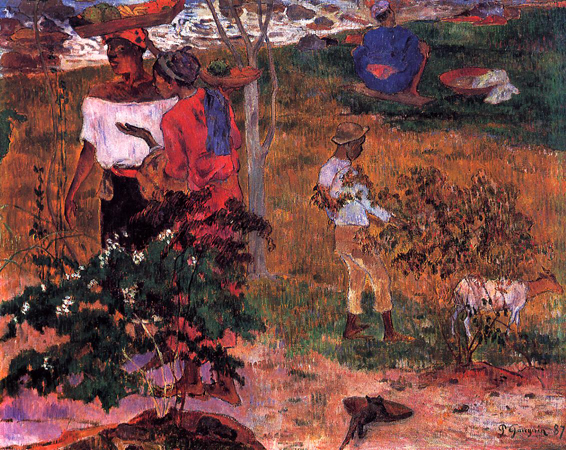
Tropical Conversation: 1887
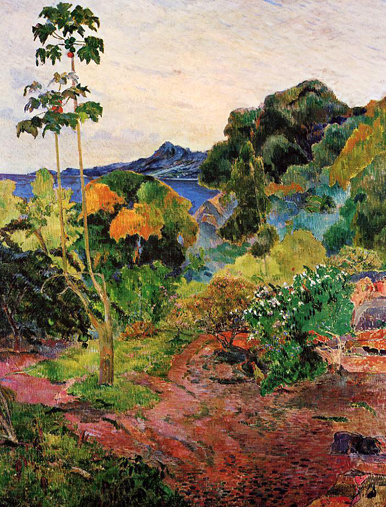
Tropical Vegetation: 1887
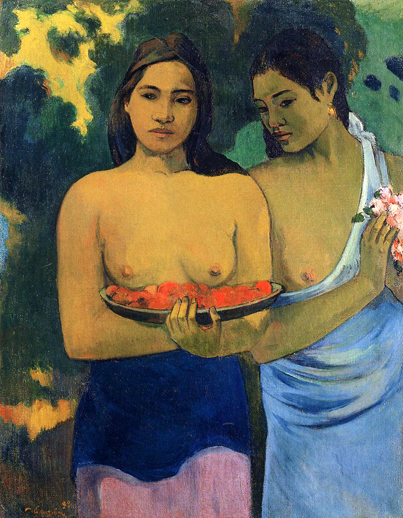
Two Tahitian Women: 1899
Before Gauguin brought his work in Tahiti to a close, he shifted from his symbolist pictorial agenda in order to focus on the beauty and serene virtues of the native women. In this painting, he depended on sculpturally modeled forms, gesture, and facial expression to vivify the sentiments he had used to describe the "Tahitian Eve": "very subtle, very knowing in her naïveté" and at the same time "still capable of walking around naked without shame." These two figures first appear in the artist's monumental frieze Faa Iheihe (Tahitian Pastoral) of 1898 (Tate, London) and again in the even larger Rupe, Rupe of 1899 (Pushkin Museum of Fine Arts, Moscow), which he composed for the upcoming Exposition Universelle of 1900.
Quoted From: Paul Gauguin: Two Tahitian Women - Heilbrunn Timeline of Art History - The Metropolitan Museum of Art

Two Women
(aka Flowered Hair): 1902
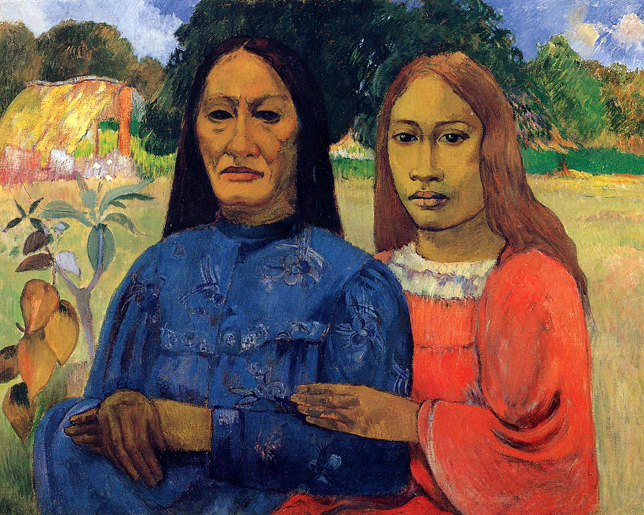
Two Women
(aka Mother and Daughter): 1901-02
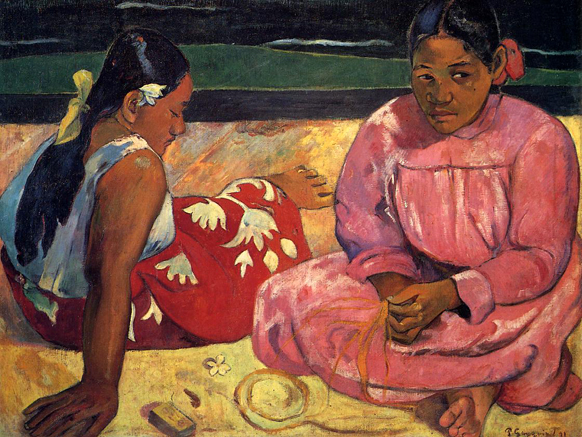
Two Women on the Beach: 1891
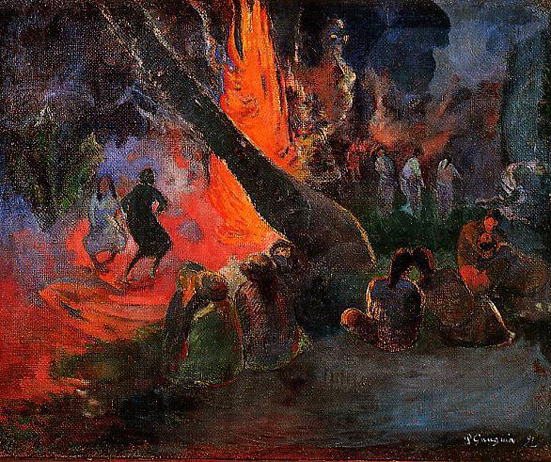
Upaupa
(aka Fire Dance): 1891
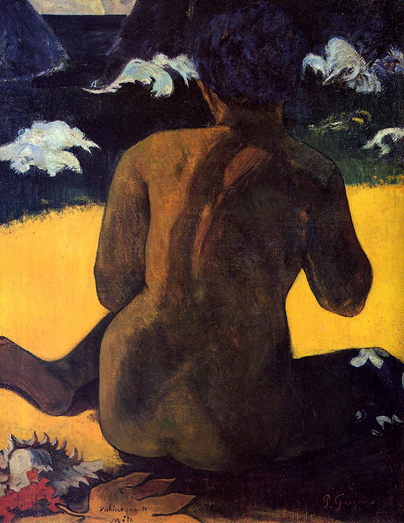
Vahine no te Miti
(aka Woman by the Sea): 1892

Vahine no te Tiare
(aka Woman with a Flower): 1891
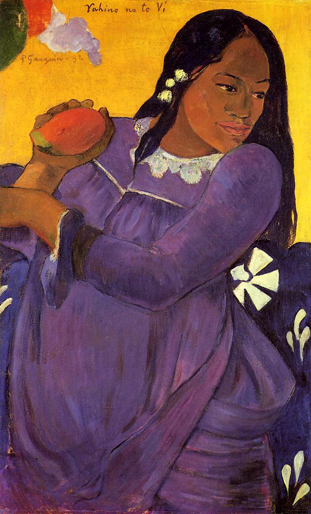
Vahine no te vi
(aka Woman with a Mango): 1892
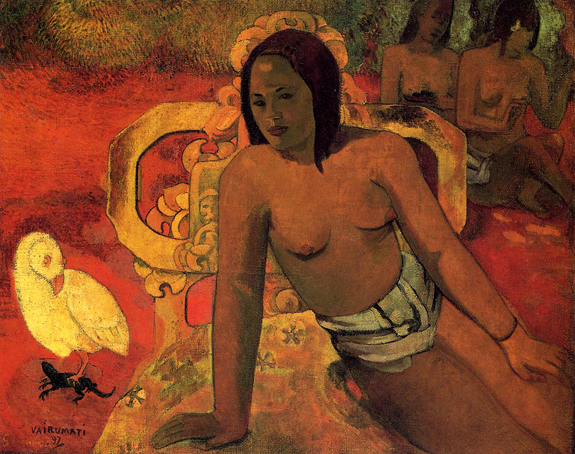
Vairumati: 1897

Viaraumati Tei Oa
(aka Her Name is Viaraumati): 1892
Vairaumati, Gauguin misspelled it, is a name of a mythic earth mother of Tahitian legend. With the god Oro as father, she was the Tahitian Eve, who gave birth for the entire island race.
Quoted From: Paul Gauguin - Vaïraumati tei oa - Her Name is Vairaumati

View of the Beach at Bellangenay: 1889

Woman on the Banks of the River: 1892
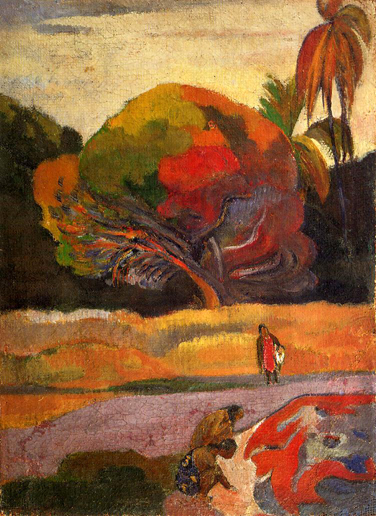
Women at the Riverside: 1892
In 1903, due to a problem with the church and the government, he was sentenced to three months in prison and fined. At that time he was being supported by the art dealer Ambroise Vollard. He died of syphilis before he could start the prison sentence. His body had been weakened by alcohol and a dissipated life. He was 54 years old.
Gauguin died on 8 May 1903 and is buried in Calvary Cemetery (Cimetière Calvaire), Atuona, Hiva 'Oa, Marquesas Islands, French Polynesia.
Gauguin began painting in his free time. He also visited galleries frequently and purchased work by emerging artists. Gauguin formed a friendship with artist Camille Pissarro, who introduced him to various other artists. As he progressed in his art, Gauguin rented a studio, and showed paintings in Impressionist Exhibitions held in 1881 and 1882. Over two summer holidays, he painted with Pissarro and occasionally Paul Cézanne.
In 1887, after visiting Panama, he spent several months near Saint Pierre in Martinique, in the company of his friend the artist Charles Laval. At first, the 'negro hut' in which they lived suited him, and he enjoyed watching people in their daily activities. However, the weather in the summer was hot and the hut leaked in the rain. He also suffered dysentery and marsh fever. While in Martinique, he produced between ten and twenty works (twelve being the most common estimate) and traveled widely and apparently came into contact with a small community of Indian immigrants, a contact that would later influence his art through the incorporation of Indian symbols. Gauguin, along with Émile Bernard, Charles Laval, Émile Schuffenecker and many others frequently visited the artist colony of Pont-Aven in Brittany. By the bold use of pure color and Symbolist choice of subject matter the group is now considered a Pont-Aven School. Disappointed with Impressionism, he felt that traditional European painting had become too imitative and lacked symbolic depth. By contrast, the art of Africa and Asia seemed to him full of mystic symbolism and vigor. There was a vogue in Europe at the time for the art of other cultures, especially that of Japan. He was invited to participate in the 1889 exhibition organized by Les XX.
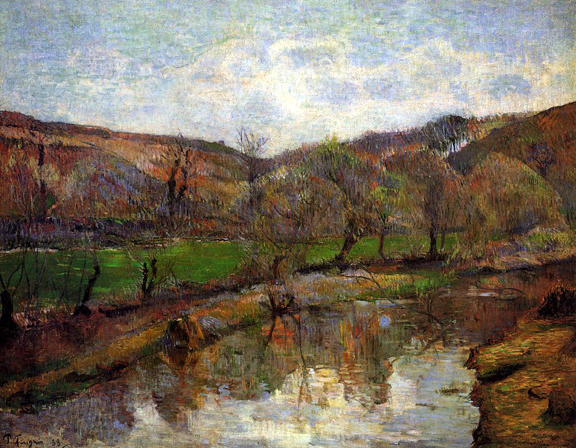
Aven Valley, Upstream of Pont Aven: 1888
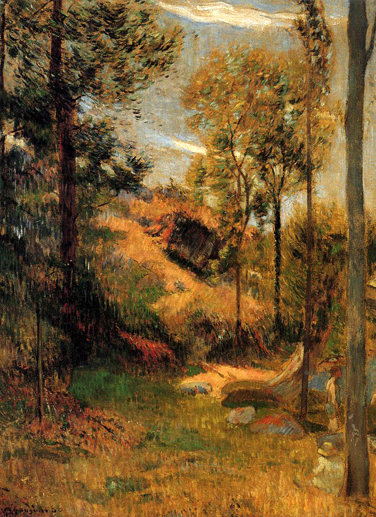
Bathing Place, Pont Aven Port: 1886
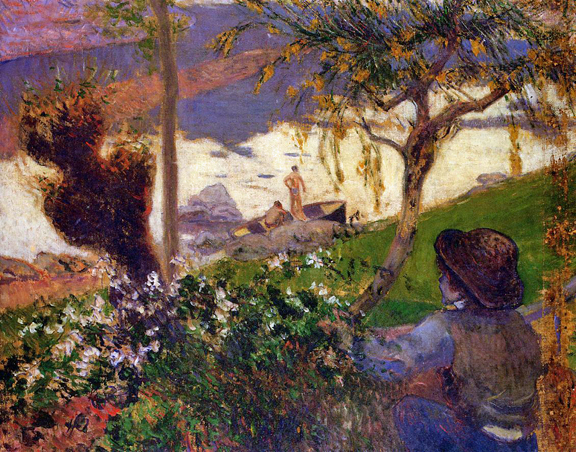
Breton Boy by the Aven River: 1888
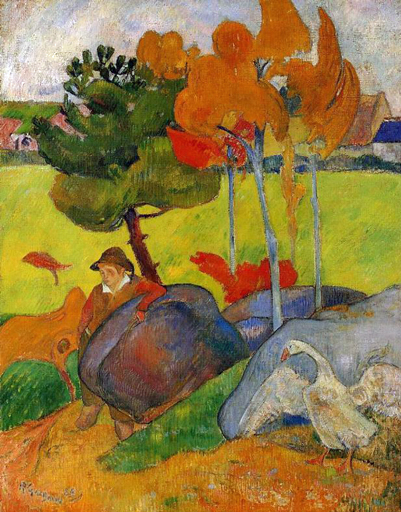
Breton Boy in a Landscape: 1889
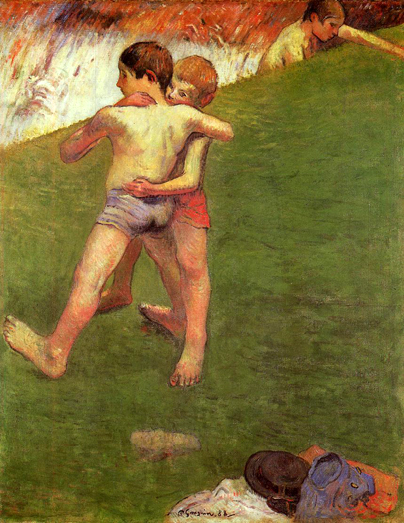
Breton Boys Wrestling: 1888
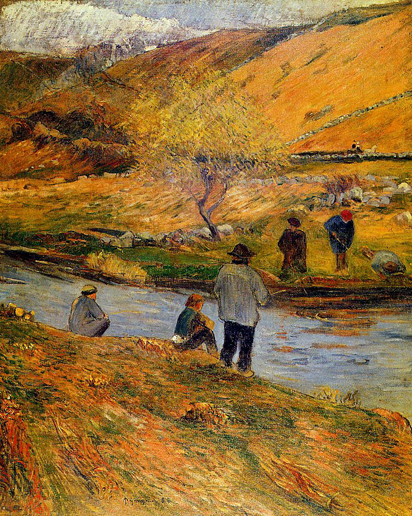
Breton Fishermen: 1888
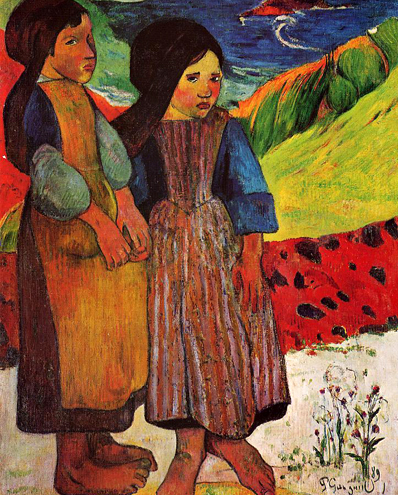
Breton Girls by the Sea: 1889

Breton Girls Dancing
(aka Dancing around in the Haystacks): 1888
Gauguin wrote to art dealer Theo van Gogh (brother of Vincent), "I am doing a gavotte bretonne: three little girls dancing in a hayfield. . . . The painting seems original to me, and I am quite pleased with the composition." The subject itself was a familiar one; Breton dances, religious processions, and other peasant scenes by academic painters were shown with some frequency at the Salon. Parisian audiences would have recognized the girls' triangular bonnets, broad collars, and wooden shoes immediately.
But Gauguin's aim was not to present an anecdotal view of life in Brittany. The somnolent, ritualistic quality of the girls' dance conveys ambiguity. His dancers loom overlarge in front of a stone wall, their size emphasized by small heaps of grain. Gauguin's eye was also trained on concerns of color and form. The girls' linked arms create a sinuous chain of zigzags that seems to fence them into a narrow space. This effect is enhanced by strong contrasts of color: the dark dresses and white collars, the brilliant poppies attached to their smocks, and the green of new hay.
The town of Pont-Aven and its church spire can be recognized in the background of this scene. In 1886, the year after he painted his gavotte, Gauguin found the place overcrowded with artists. Seeking a more isolated-and less expensive-environment, he and several colleagues took up residence in Le Pouldu, a small hamlet nine kilometers distant.
Quoted From: (NGA) - Breton Girls Dancing, Pont-Aven
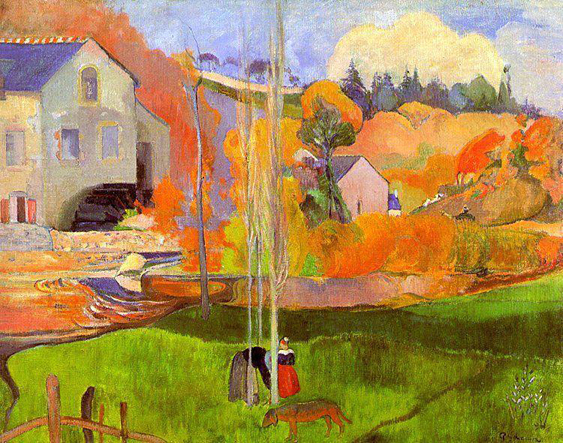
Breton Landscape: 1894
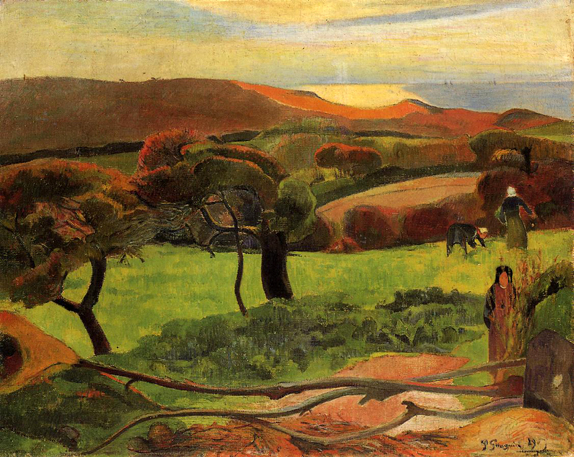
Breton Landscape, Fields by the Sea
aka Le Pouldu: 1889
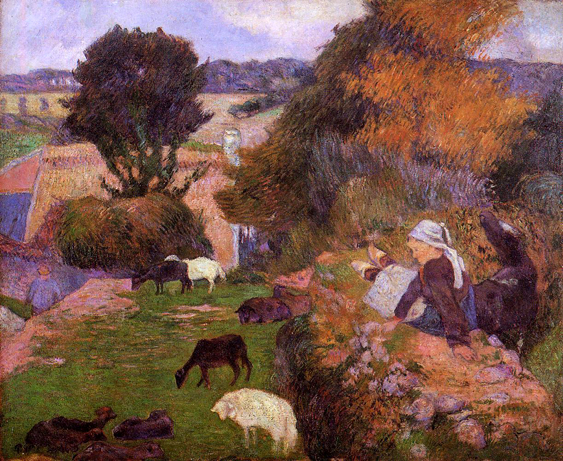
Breton Shepherdess: 1886
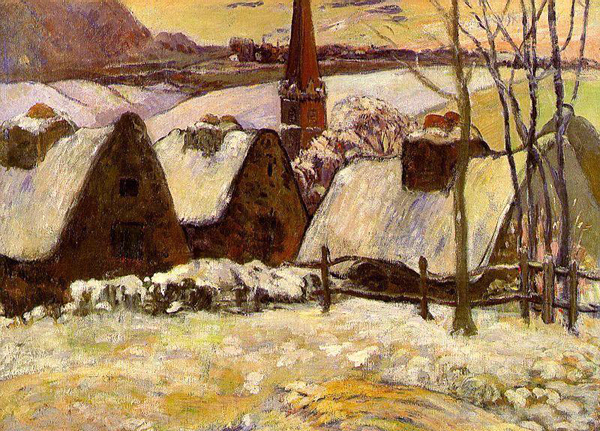
Breton Village in the Snow: 1894
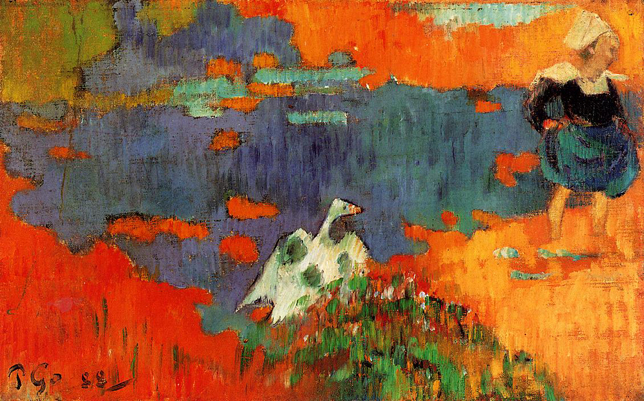
Breton Woman and Goose by the Water: 1888
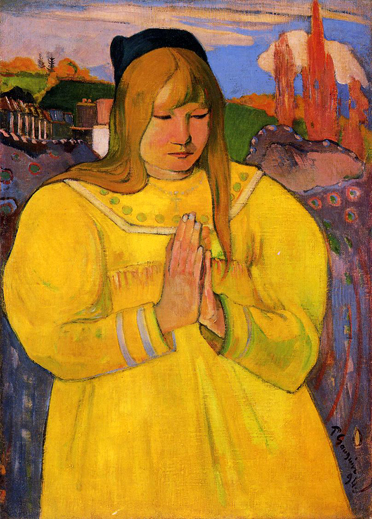
Breton Woman in Prayer: 1894
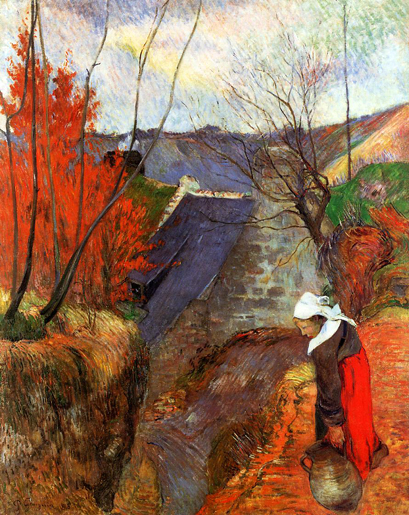
Breton Woman with Pitcher: 1888
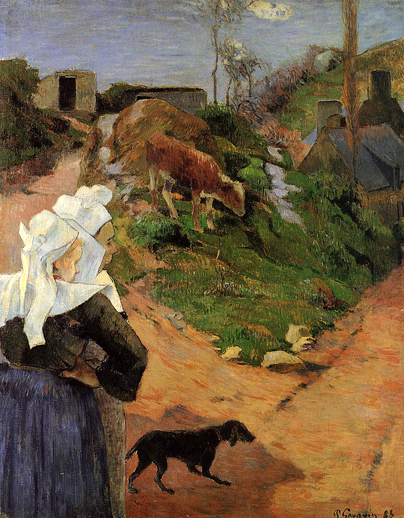
Breton Women at the Turn: 1888
_ca_1889.jpg)
Bretons and Cows (sketch): ca 1889
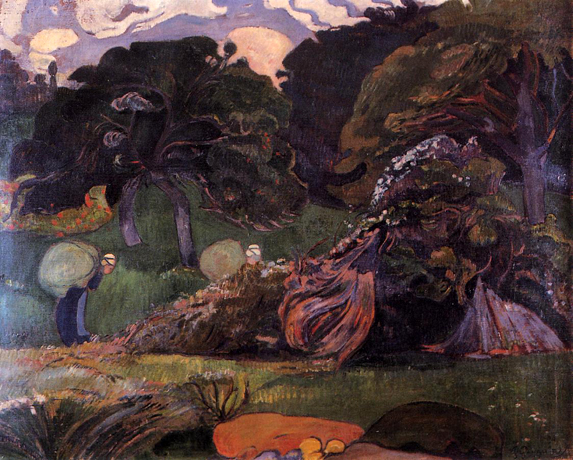
Brittany Landscape: ca 1889
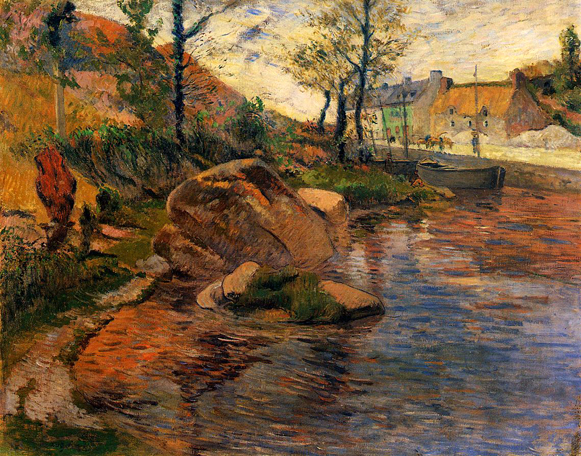
Cove opposite Pont-Aven Harbor: 1888
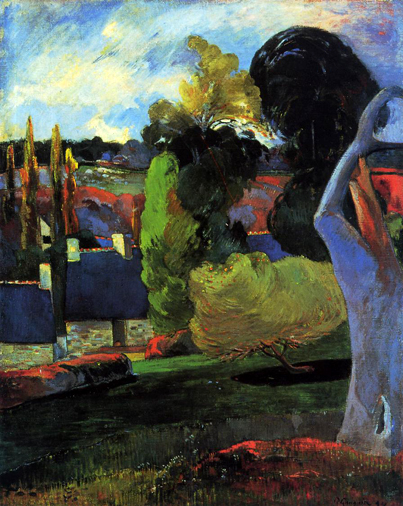
Farm in Brittany: 1894

Farm in Brittany: 1896
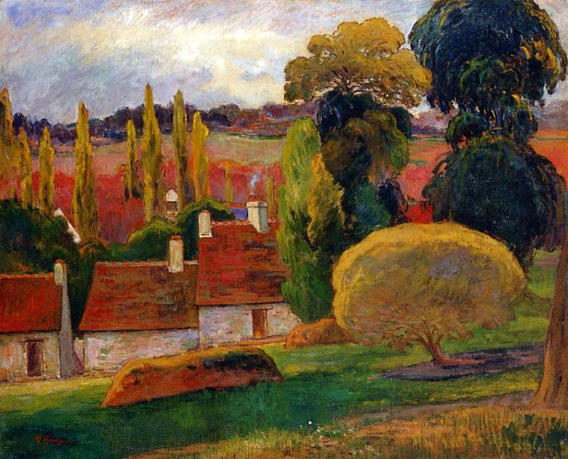
Farm in Brittany: ca 1894
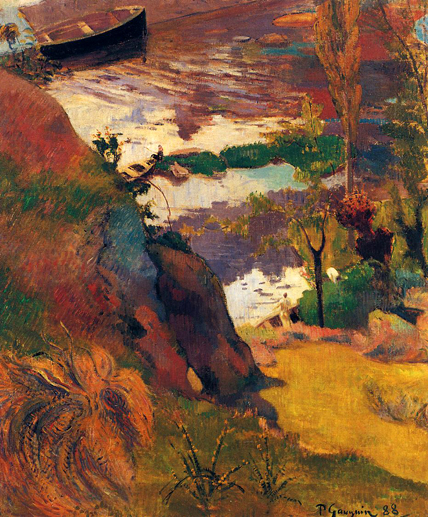
Fishermen and Bathers on the Aven: 1888
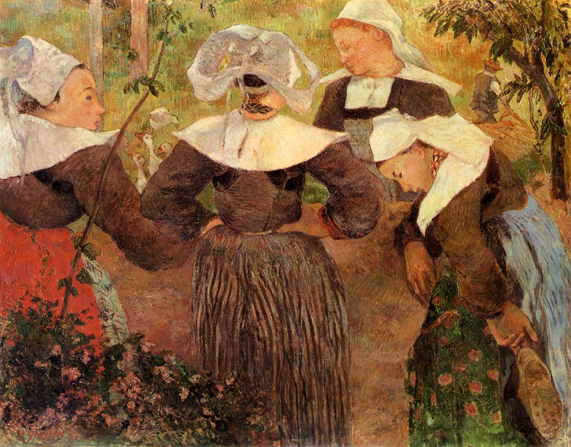
Four Breton Women: 1886

Green Christ
(aka Breton Calvary): 1889

Haymaking in Brittany: 1889
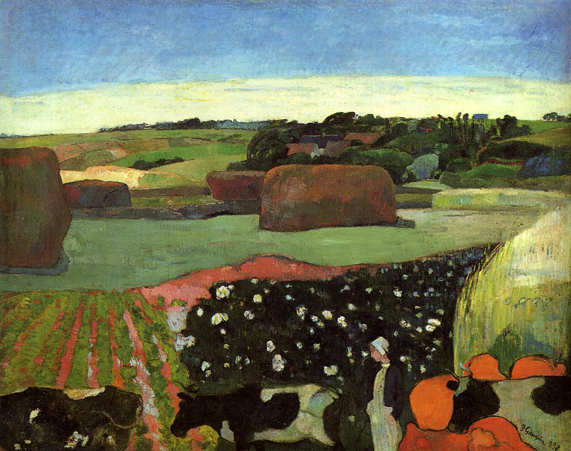
Haystacks in Britanny
(aka The Potato Field): 1890
This stylized view of fields and farm buildings near Le Pouldu is typical of the so-called synthétiste works that Gauguin painted in Brittany in 1890. Its forms are simplified, abstracted to their essence. In 1888, Gauguin had defined his goal as " . . . synthesis of form and color derived from the observation of only the dominant element."
The friezelike procession of cows and cowherd in the foreground coaxes our eye to move horizontally, and we find that the entire composition is arranged into bands, layered one on the other. Even the sky is stratified. Strong contrasts of dark and light-exploited especially in the black-and-white cows and the flowering crops-flatten forms, rendering them more decorative than descriptive. The vivid and unexpected oranges in the foreground do not mimic nature but cast it according to the artist's imagination. Notice how the silhouette of the cow at right is outlined against the orange with dark blue. In many places similar outlines compartmentalize colors, in the manner of cloisonné enamels or stained glass. This was a style Gauguin had evolved with fellow artist Emile Bernard. It grew out of Bernard's interest in medieval art and Gauguin's own fascination with Japanese prints.
Quoted From: (NGA) - Haystacks in Brittany, 1890
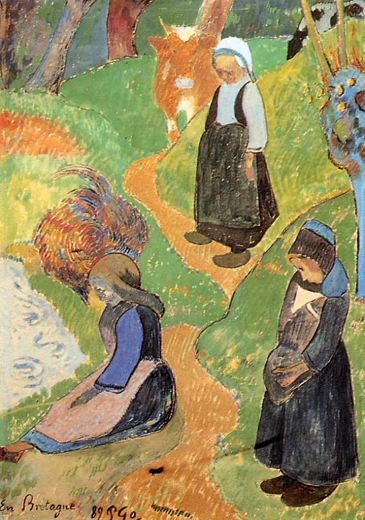
In Brittany: 1889

La Belle Angele
(aka Madame Angele Satre, the Inkeeper at Pont-Aven): 1889
Angelle Satre, wife of Frederic Satre, owners of a small café in Pont-Aven. They gave Gauguin credit and he, in gratitude, painted Angelle's portrait. Angelle was thought the most attractive woman in Pont-Aven and hoped her beauty would be preserved forever. But the couple was so aghast and disappointed with the work that they refused to accept the portrait.
Quoted From: Paul Gauguin - La Belle Angèle - Portrait of Madame Satre

Little Breton Bather: 1888

Little Breton Shepherd: 1888
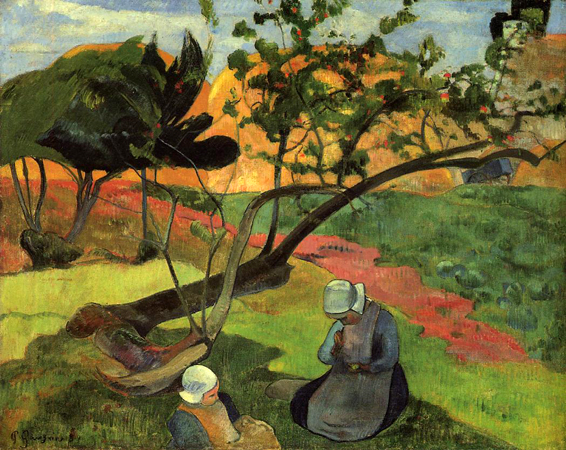
Little Girls
(aka Landscape with Two Breton Girls): 1889
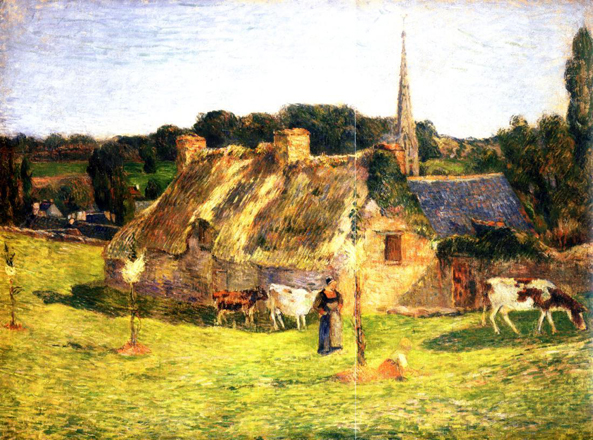
Lollichon Field and Pont-Aven Church: 1886
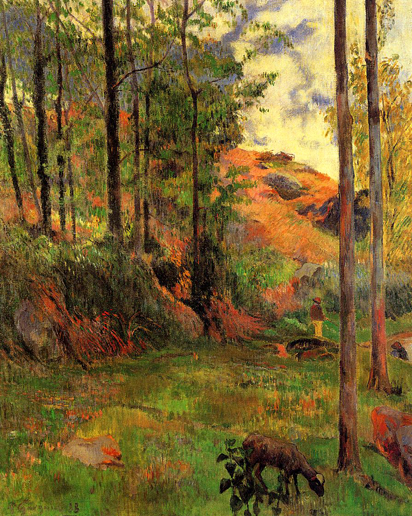
Path down to the Aven: 1888
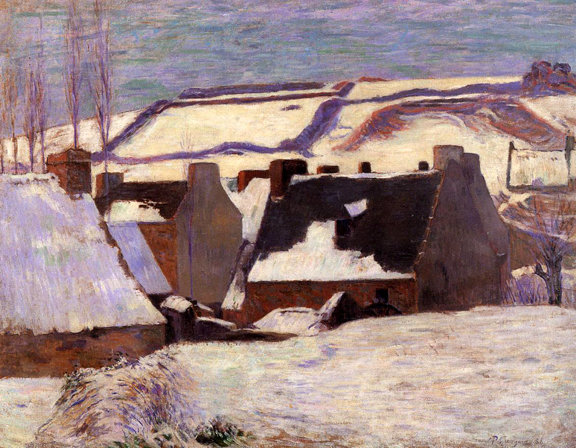
Pont-Aven in the Snow: 1888

Pont-Aven Woman and Child: 1886
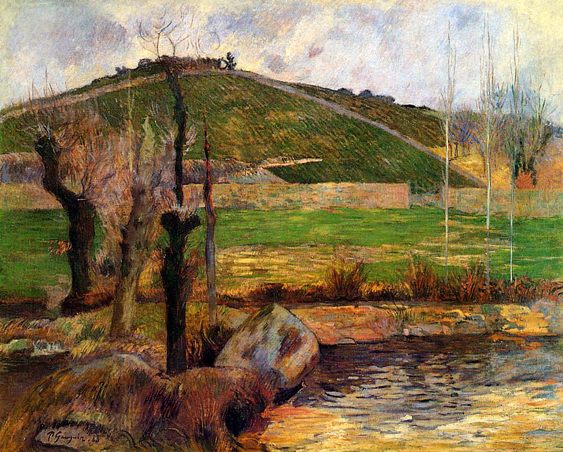
River Aven below Mount Sainte-Marguerite: 1888

Riverside
(aka Breton Landscape): 1879
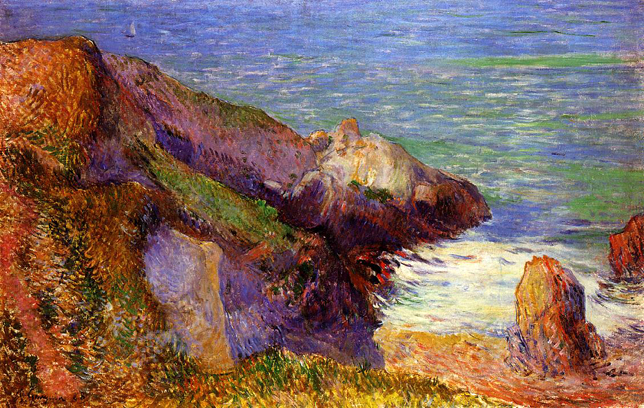
Rocks on the Breton Coast: 1888

Seated Breton Girl: 1899
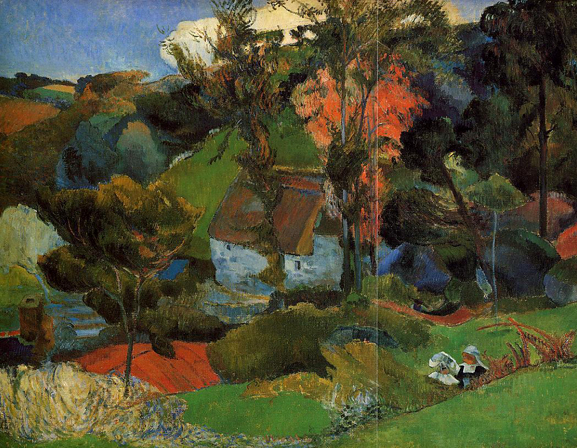
The Aven Running through Pont-Aven: 1888

Turkeys
(aka Pont-Aven Landscape): 1888
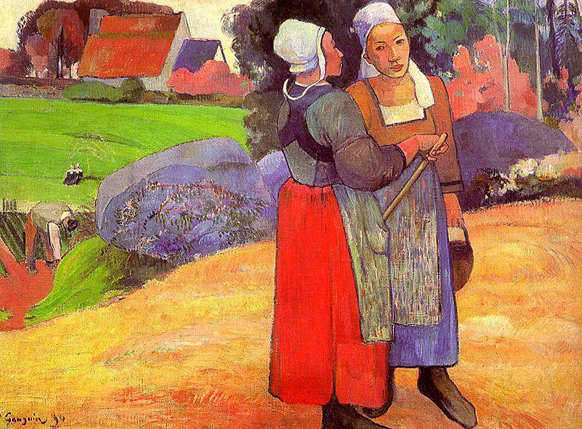
Two Breton Peasants on the Road: 1894
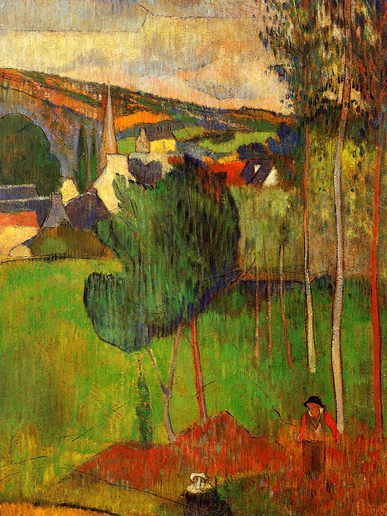
View of Pont-Aven from Lezaven: 1888
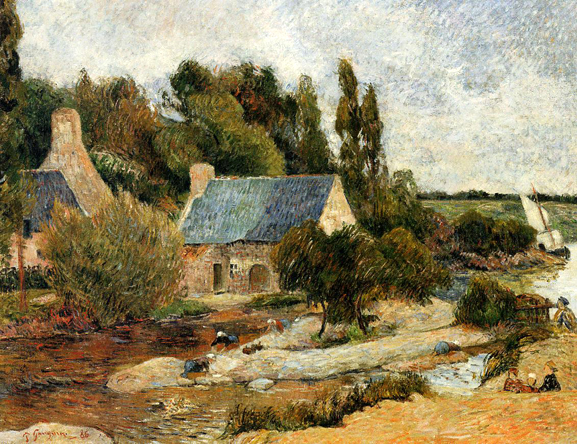
Washerwoman at Simonou Mill Pont-Aven: 1886
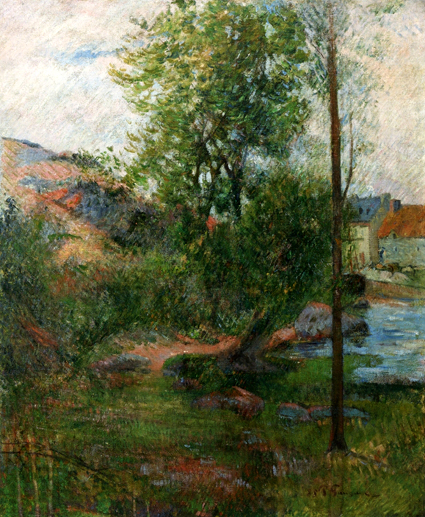
Willow by the Aven: 1888
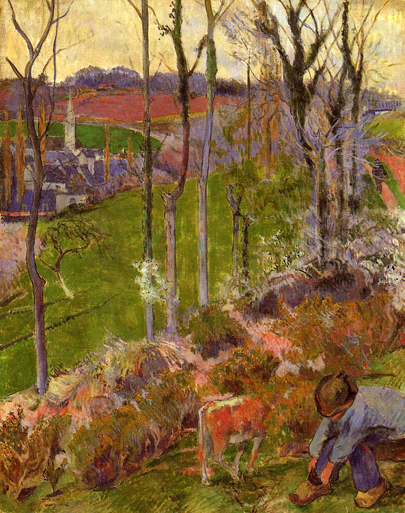
Winter
(aka Young Breton Boy Adjusting His Clog): 1888
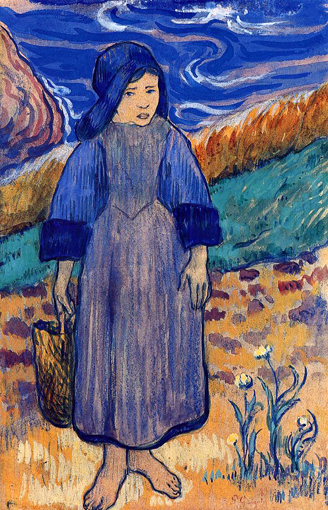
Young Breton by the Sea: 1889
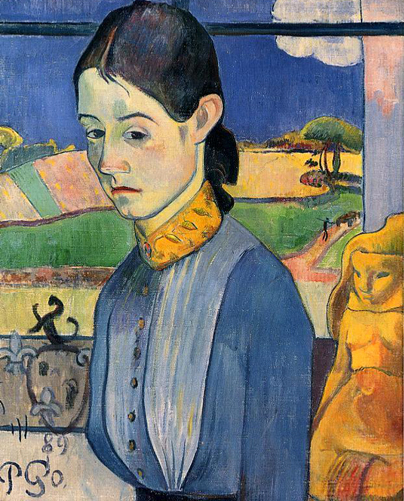
Young Breton Woman: 1889
Under the influence of folk art and Japanese prints, Gauguin evolved towards Cloisonnism, a style given its name by the critic Édouard Dujardin in response to Émile Bernard's method of painting with flat areas of color and bold outlines, which reminded Dujardin of the Medieval cloisonné enameling technique. Gauguin was very appreciative of Bernard's art and of his daring with the employment of a style which suited Gauguin in his quest to express the essence of the objects in his art.
In The Yellow Christ (1889), often cited as a quintessential Cloisonnist work, the image was reduced to areas of pure colour separated by heavy black outlines. In such works Gauguin paid little attention to classical perspective and boldly eliminated subtle gradations of colour, thereby dispensing with the two most characteristic principles of post-Renaissance painting. His painting later evolved towards Synthetism in which neither form nor colour predominate but each has an equal role.
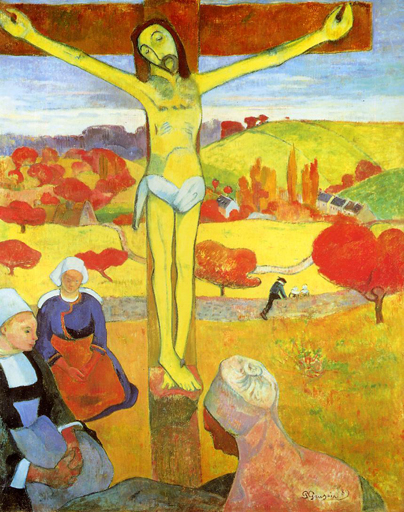
Yellow Christ: 1889
Living in Mataiea Village in Tahiti, he painted "Fatata te Miti" ("By the Sea"), "Ia Orana Maria" (Ave Maria) and other depictions of Tahitian life. He moved to Punaauia in 1897, where he created the masterpiece painting "Where Do We Come From? What Are We? Where Are We Going?" and then lived the rest of his life in the Marquesas Islands, returning to France only once, when he painted at Pont-Aven.
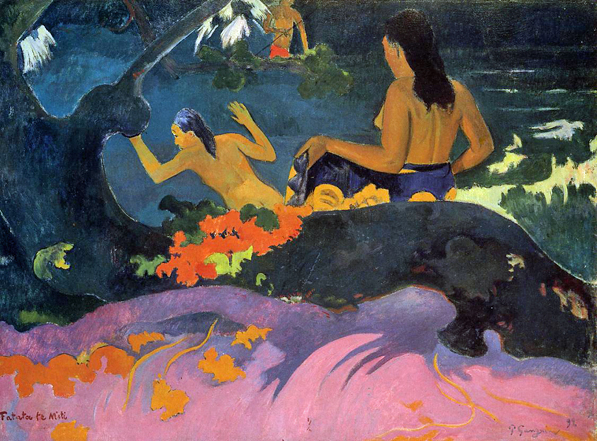
Fatata te Miti
aka By the Sea: 1892
Like Parau na te Varua ino, Fatata te Miti was painted during Gauguin's first trip to Tahiti. Its setting, in fact, is quite similar. The two paintings share brilliant pink sands and vividly colored accents, the brilliant fringed blossoms of the phosphorescing hutu, and on the left the same unusually shaped tree. These similarities point to Gauguin's use of "documents," the term he used for sketches and working drawings that he would incorporate into many paintings and prints.
Their similarities invite us to compare the two works, and in other respects we find they are quite different. Where Parau na te Varua ino is densely symbolic, this painting is a more straight-forward depiction of life on the island. One woman removes her pareo to join a companion already plunging into the sea for a swim. Nearby a man fishes with a spear. The intense, tropical colors-hot oranges and cool blues-convey sensual delight. This is the effortless and uninhibited paradise that Gauguin had hoped to find in the South Seas. Little remained of this life, however, by the time Gauguin reached Tahiti. Polynesian culture had been transformed by western missionaries and colonialism, and the ancient religion replaced by Christianity. Gauguin wrote and illustrated a manuscript about Polynesian mythology, but most of what he knew about the island gods came from previously published sources.
Quoted From: (NGA) - Fatata te Miti (By the Sea), 1892

Ia Orana Maria
aka Hail Mary: 1891
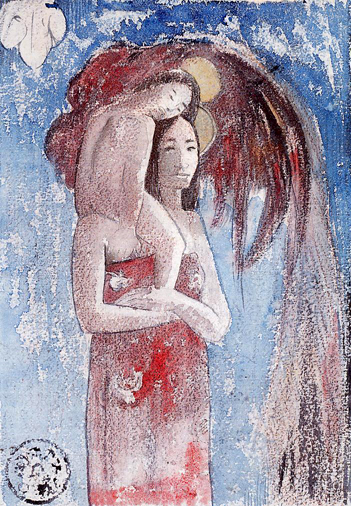
Ia Orana Maria
aka Hail Maria: ca 1894

Where do We Come From? What are We Doing? Where are We Going? - 1897
His works of that period are full of quasi-religious symbolism and an exoticized view of the inhabitants of Polynesia. In Polynesia, he sided with the native peoples, clashing often with the colonial authorities and with the Catholic Church. During this period he also wrote the book Avant et après (before and after), a fragmented collection of observations about life in Polynesia, memories from his life and comments on literature and paintings.
Primitivism was an art movement of late 19th century painting and sculpture; characterized by exaggerated body proportions, animal totems, geometric designs and stark contrasts. The first artist to systematically use these effects and achieve broad public success was Paul Gauguin. The European cultural elite discovering the art of Africa, Micronesia, and Native Americans for the first time were fascinated, intrigued and educated by the newness, wildness and the stark power embodied in the art of those faraway places. Like Pablo Picasso in the early days of the 20th century, Gauguin was inspired and motivated by the raw power and simplicity of the so-called Primitive art of those foreign cultures.
Gauguin is also considered a Post-Impressionist painter. His bold, colorful and design oriented paintings significantly influenced Modern art. Gauguin's influence on artists and movements in the early 20th century include Vincent van Gogh, Henri Matisse, Pablo Picasso, Georges Braque, André Derain, Fauvism, Cubism and Orphism, among others. Later he influenced Arthur Frank Mathews and the American Arts and Crafts Movement.
John Rewald, an art historian focused on the birth of Modern art, wrote a series of books about the Post-Impressionist period, including Post-Impressionism: From Van Gogh to Gauguin (1956) and an essay, Paul Gauguin: Letters to Ambroise Vollard and André Fontainas (included in Rewald's Studies in Post-Impressionism, 1986), discusses Gauguin's years in Tahiti, and the struggles of his survival as seen through correspondence with the art dealer Vollard and others.
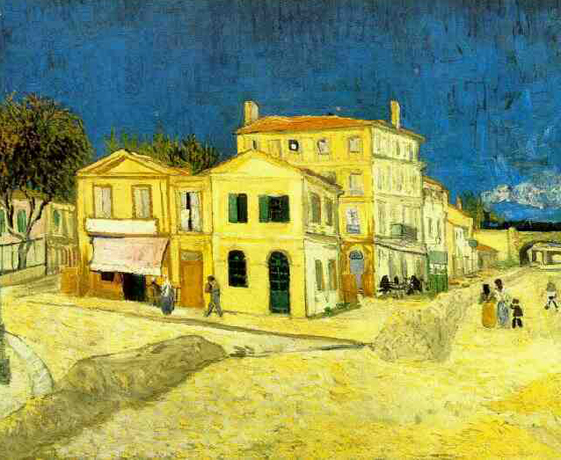
The Yellow House of Vincent van Gogh
Gauguin's relationship with van Gogh was rocky. Gauguin had shown an early interest in Impressionism, and the two shared bouts of depression and suicidal tendencies. In 1888, Gauguin and van Gogh spent nine weeks together, painting in the latter's Yellow House in Arles. During this time, Gauguin became increasingly disillusioned with Impressionism, and the two quarreled. On the evening of December 23, 1888, frustrated and ill, van Gogh confronted Gauguin with a razor blade. In a panic, van Gogh fled to a local brothel. While there, he cut off the lower part of his left ear lobe. He wrapped the severed tissue in newspaper and handed it to a prostitute named Rachel, asking her to "keep this object carefully". Gauguin left Arles, and a few days later van Gogh was hospitalized. They never saw each other again, but they continued to correspond and in 1890 Gauguin proposed they form an artist studio in Antwerp
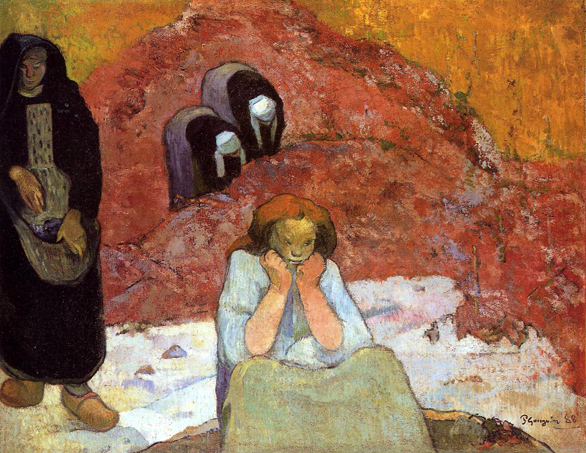
Grape Harvest in Arles
(aka Human Misery): 1888
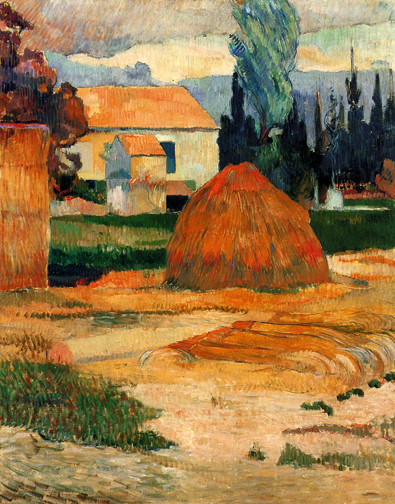
Haystack, near Arles: 1888
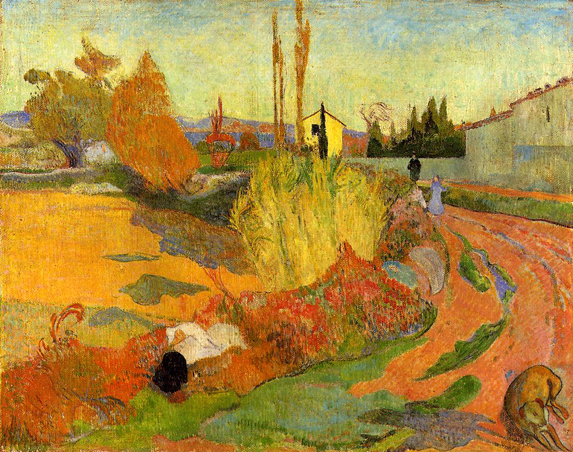
Landscape, Farmhouse in Arles: 1888
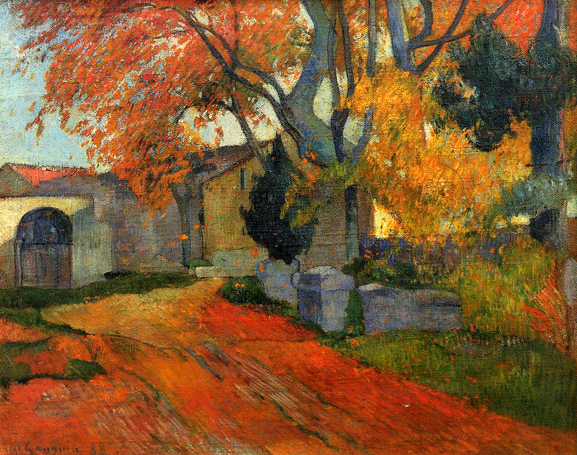
Lane at Alchamps, Arles: 1888
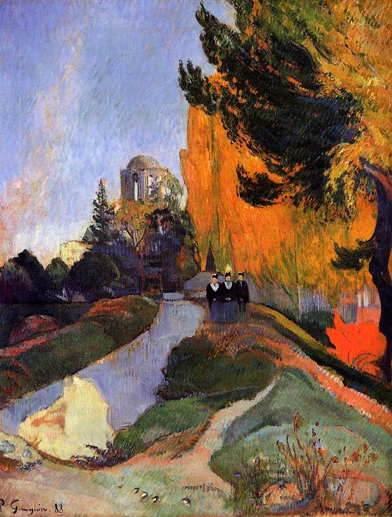
Les Alychamps: 1888
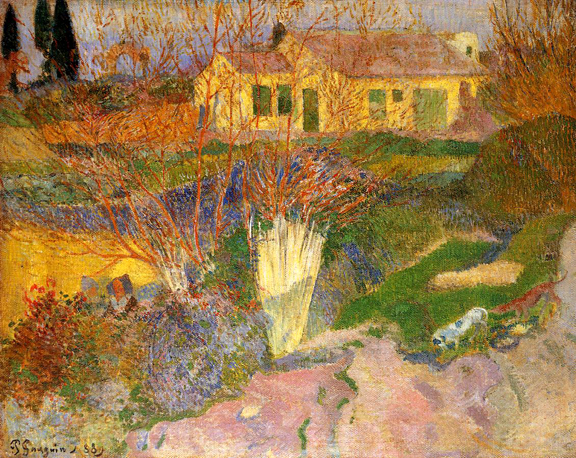
Mas, near Arles: 1888
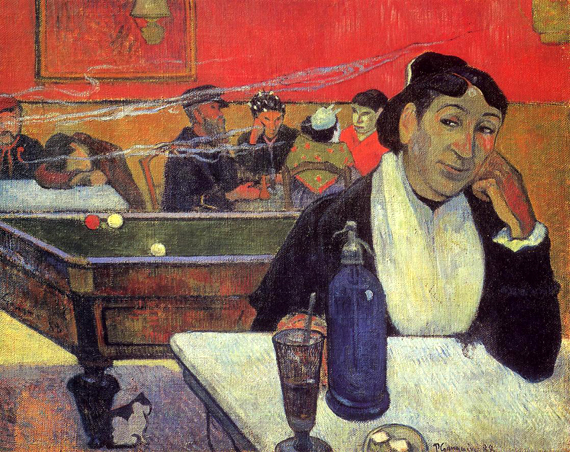
Night Cafe at Arles: 1888

Old Women at Arles
(aka Women from Arles in the Public Gardens, The Mistral): 1888
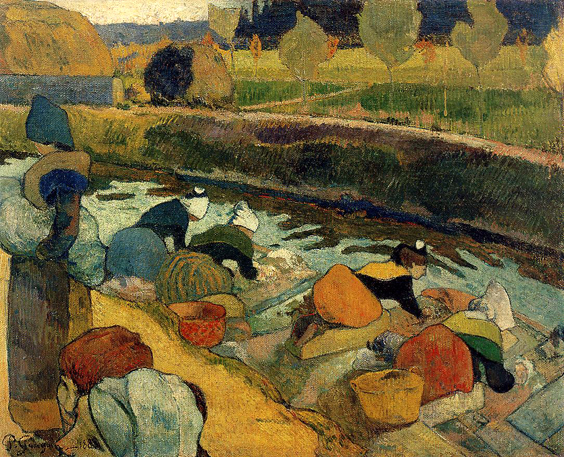
Washerwomen at the Roubine du Roi, Arles: 1888
The vogue for Gauguin's work started soon after his death. Many of his later paintings were acquired by the Russian collector Sergei Shchukin. A substantial part of his collection is displayed in the Pushkin Museum and the Hermitage. Gauguin paintings are rarely offered for sale; their price may be as high as $39.2 million US dollars.
Gauguin's posthumous retrospective exhibitions at the Salon d'Automne in Paris in 1903 and an even larger one in 1906 had a stunning and powerful influence on the French avant-garde and in particular Pablo Picasso's paintings. In the autumn of 1906, Picasso made paintings of oversized nude women, and monumental sculptural figures that recalled the work of Paul Gauguin and showed his interest in primitive art. Picasso's paintings of massive figures from 1906 were directly influenced by Gauguin's sculpture, painting and his writing as well. The power evoked by Gauguin's work lead directly to Les Demoiselles d'Avignon in 1907.
According to Gauguin biographer David Sweetman, Picasso as early as 1902 became an aficionado of Gauguin's work when he met and befriended the expatriate Spanish sculptor and ceramist Paco Durrio (1875-1940), in Paris. Durrio had several of Gauguin's works on hand because he was a friend of Gauguin's and an unpaid agent of his work. Durrio tried to help his poverty-stricken friend in Tahiti by promoting his oeuvre in Paris. After they met Durrio introduced Picasso to Gauguin's stoneware, helped Picasso make some ceramic pieces and gave Picasso a first La Plume edition of Noa Noa: The Tahiti Journal of Paul Gauguin. In addition to seeing Gauguin's work at Durrio's Picasso also saw the work at Ambroise Vollard's gallery where both he and Gauguin were represented.
Concerning Gauguin's impact on Picasso John Richardson wrote:
The 1906 exhibition of Gauguin's work left Picasso more than ever in this artist's thrall. Gauguin demonstrated the most disparate types of art-not to speak of elements from metaphysics, ethnology, symbolism, the Bible, classical myths, and much else besides-could be combined into a synthesis that was of its time yet timeless. An artist could also confound conventional notions of beauty, he demonstrated, by harnessing his demons to the dark gods (not necessarily Tahitian ones) and tapping a new source of divine energy. If in later years Picasso played down his debt to Gauguin, there is no doubt that between 1905 and 1907 he felt a very close kinship with this other Paul, who prided himself on Spanish genes inherited from his Peruvian grandmother. Had not Picasso signed himself 'Paul' in Gauguin's honor.
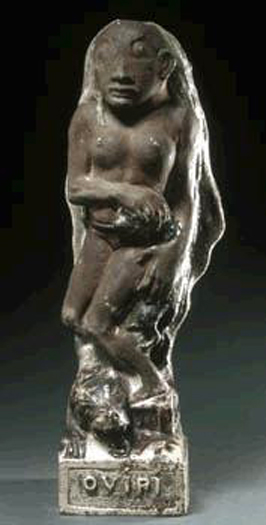
Oviri by Gauguin
Both David Sweetman and John Richardson point to the Gauguin sculpture called Oviri (literally meaning 'savage'), the gruesome phallic figure of the Tahitian goddess of life and death that was intended for Gauguin's grave, exhibited in the 1906 retrospective exhibition that even more directly led to Les Demoiselles. Sweetman writes, "Gauguin's statue Oviri, which was prominently displayed in 1906, was to stimulate Picasso's interest in both sculpture and ceramics, while the woodcuts would reinforce his interest in print-making, though it was the element of the primitive in all of them which most conditioned the direction that Picasso's art would take. This interest would culminate in the seminal Les Demoiselles d'Avignon."

Les Demoiselles d'Avignon by Picasso - 1907
According to Richardson:
Picasso's interest in stoneware was further stimulated by the examples he saw at the 1906 Gauguin retrospective at the Salon d'Automne. The most disturbing of those ceramics (one that Picasso might have already seen at Vollard's) was the gruesome Oviri. Until 1987, when the Musée d'Orsay acquired this little-known work (exhibited only once since 1906) it had never been recognized as the masterpiece it is, let alone recognized for its relevance to the works leading up to the Demoiselles. Although just under 30 inches high , Oviri has an awesome presence, as befits a monument intended for Gauguin's grave. Picasso was very struck by Oviri. 50 years later he was delighted when (Douglas) Cooper and I told him that we had come upon this sculpture in a collection that also included the original plaster of his cubist head. Has it been a revelation, like Iberian sculpture? Picasso's shrug was grudgingly affirmative. He was always loath to admit Gauguin's role in setting him on the road to primitivism.
Quoted From: Paul Gauguin - Wikipedia
Additional Sources:
Selected Works of Paul Gauguin
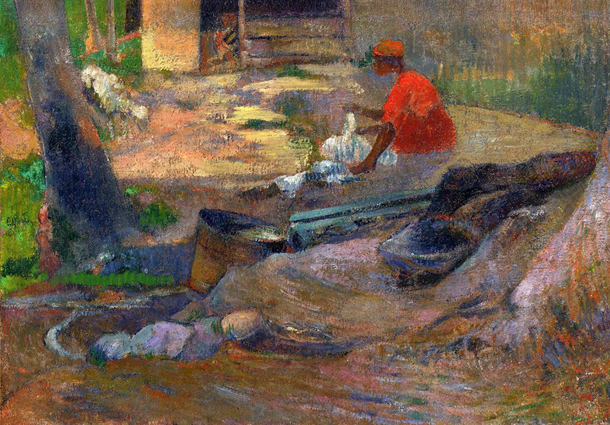
A Little Washerwoman: ca 1887
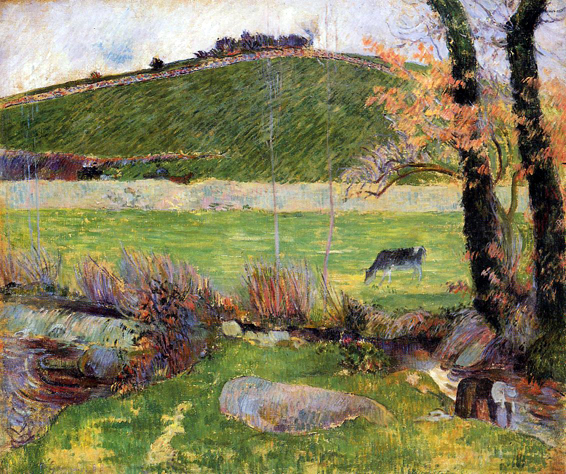
A Meadow on the Banks of the Aven: ca 1888

A Tahitian Woman with a Flower in Her Hair: Date Unknown
_Date_Unknown.jpg)
Aarearea-II
(aka Joyousness-II): Date Unknown

Abandoned Garden, Rouen: ca 1884
_ca_1892.jpg)
Aha oe Feii
(aka What? Are You Jealous?): ca 1892
_ca_1893.jpg)
Aita Parari te Tamari Vahine Judith
(aka Portrait of Annah the Javanese): ca 1893
Annah the Javanese (born 1880/81) was Gauguin's lover and model. She left him in 1894, and took all the valuables from his apartment. Later she was the model of the artist Alphonse Mucha.
Quoted From: Paul Gauguin - Aita Tamari vahina Judith te Parari - Annah the Javanese
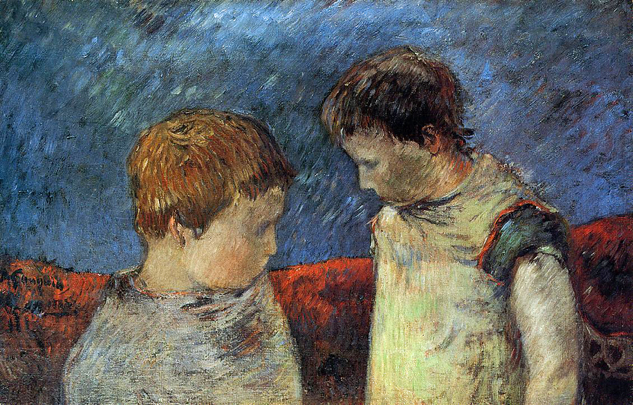
Aline Gauguin and One of Her Brothers: ca 1883
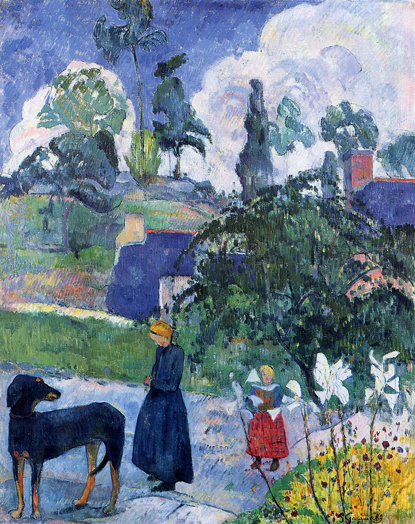
Among the Lillies: ca 1893
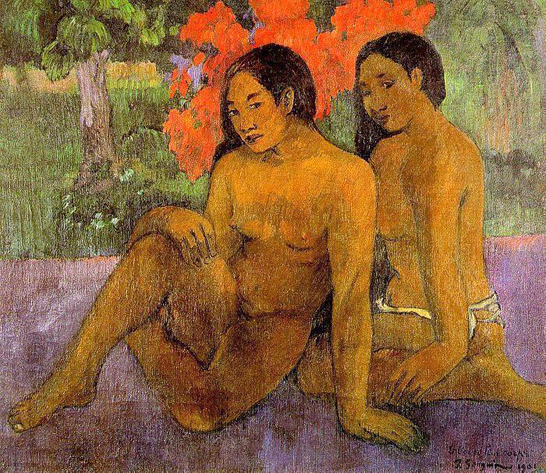
And the Gold of Their Bodies: 1901
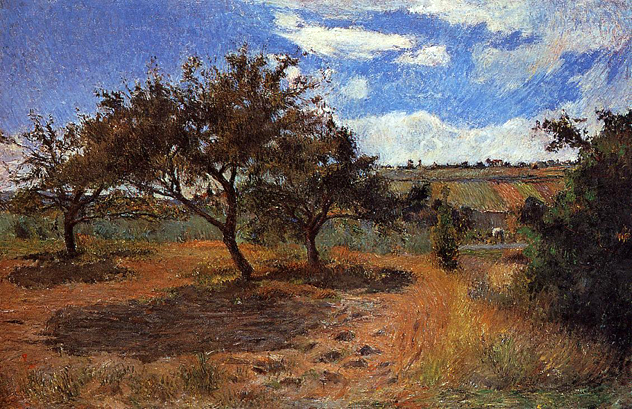
Apple Trees at l'Hermitage: 1879

_1892.jpg)
Arearea
(aka Joyousness): 1892
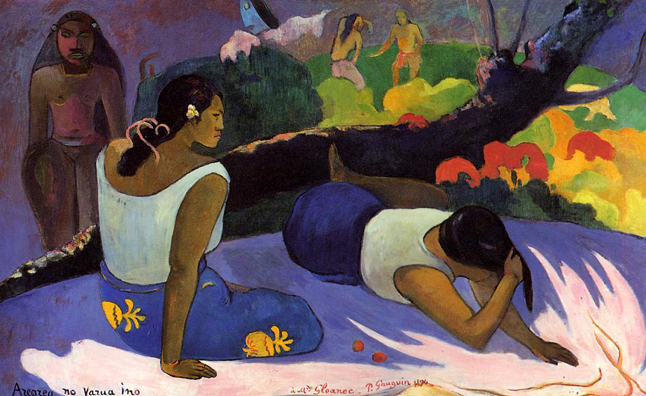
Arearea no varua ino: 1894
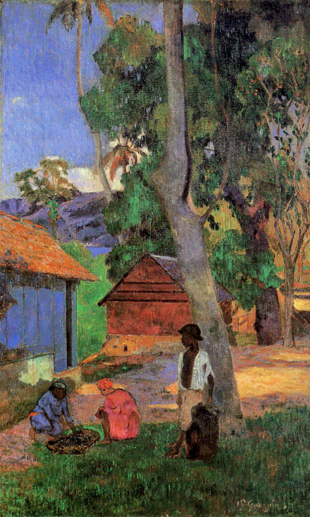
Around the Huts: 1887
_1889.jpg)
At the Black Rocks
(aka Rocks by the Sea): 1889

At the Foot of the Mountain: 1892

Atiti: 1891-92
_1877.jpg)
Autumn Landscape (aka Farm and Pond): 1877
_1896.jpg)
Baby
(aka The Nativity): 1896
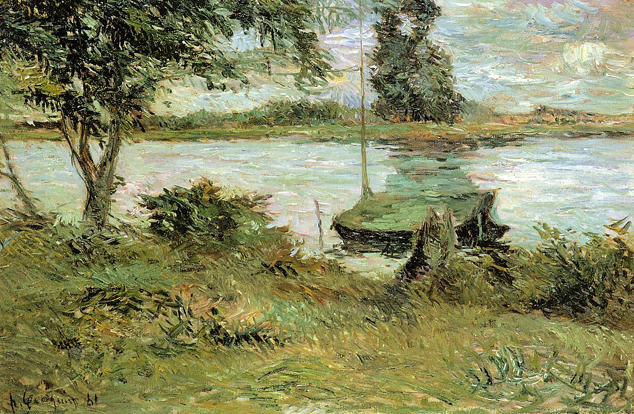
Banks of the Oise: 1881
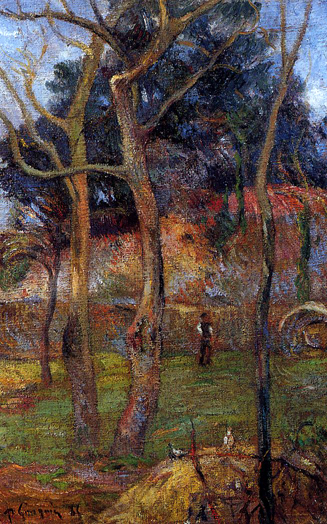
Bare Trees: 1885
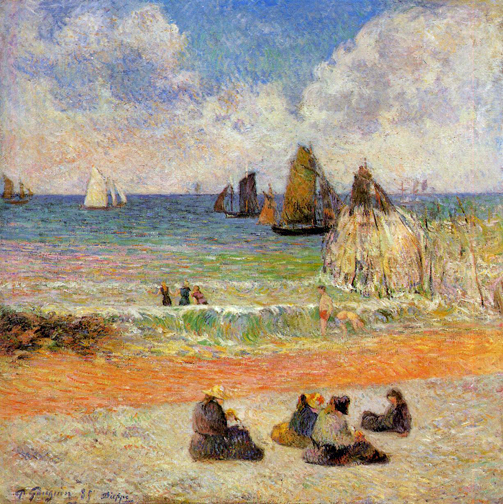
Bathing, Dieppe: 1885
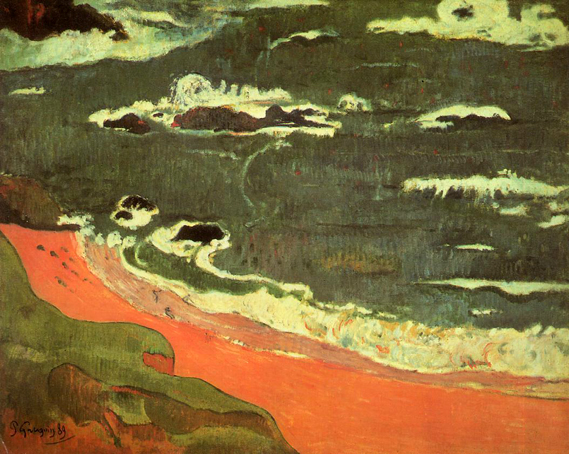
Beach at Le Pouldu: 1889
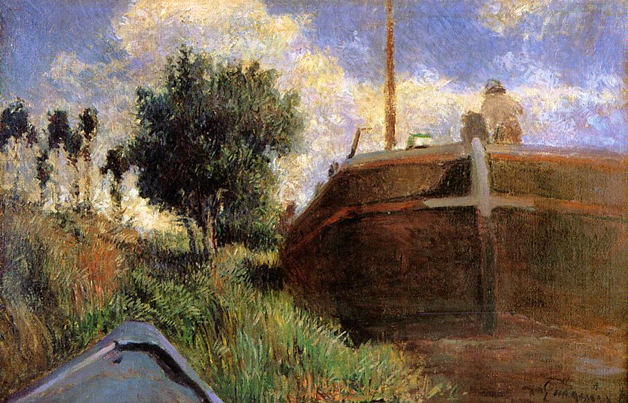
Blue Barge: 1882
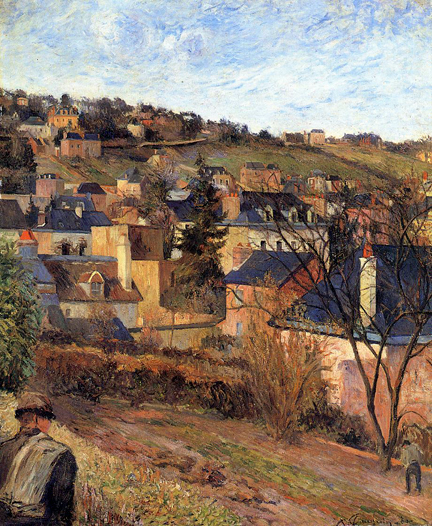
Blue Roofs, Rouen: 1884
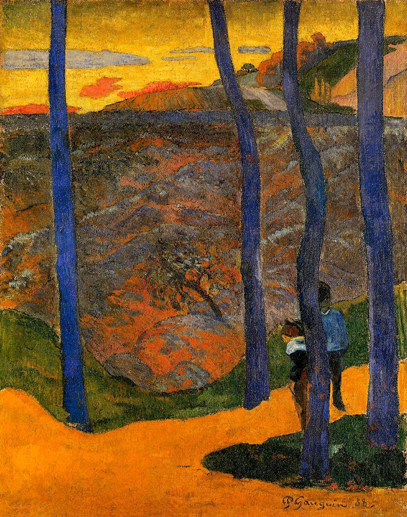
Blue Trees: 1888
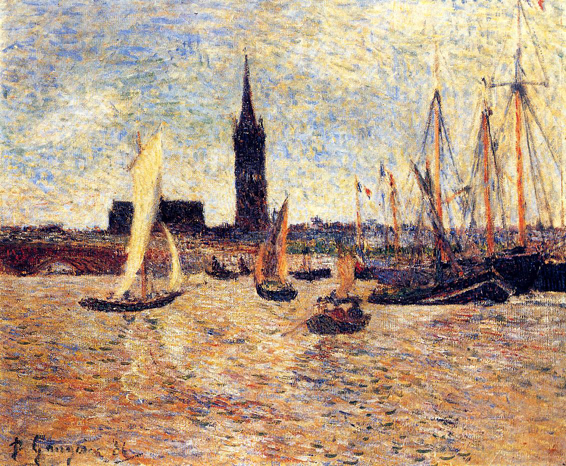
Bordeaux Harbor: 1886

Boy by the Water: 1885
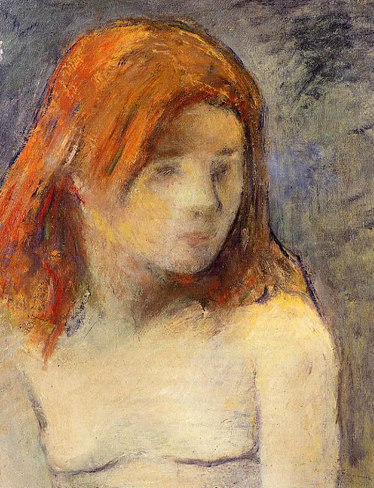
Bust of a Nude Girl: 1884
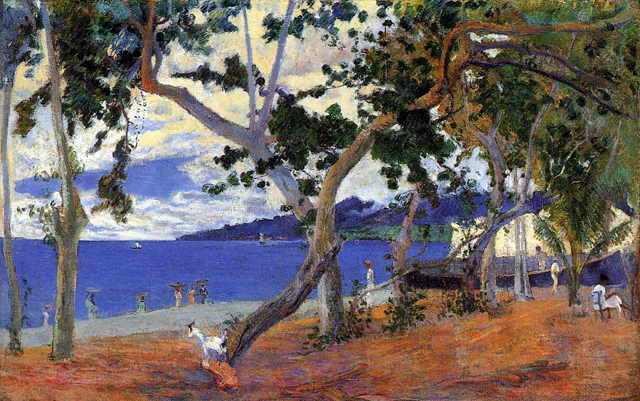
By the Seashore: 1887
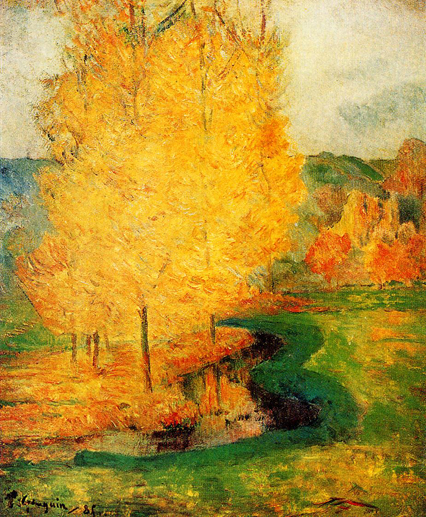
By the Stream, Autumn: 1885

Cabin under the Trees: 1892
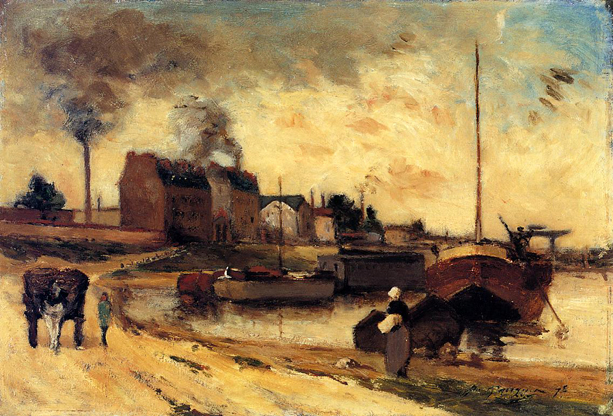
Cail Factories and Quai de Grenelle: 1875
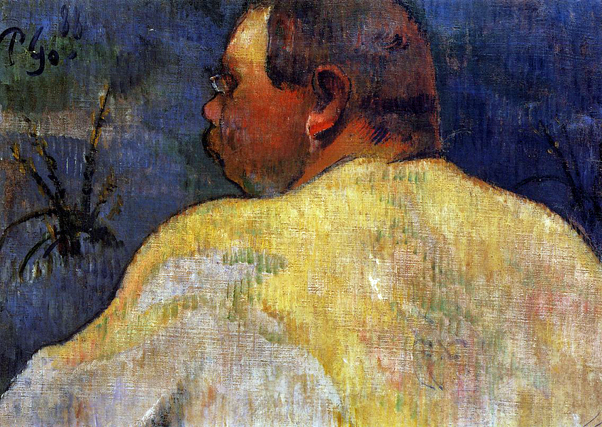
Captain Jacob: 1888
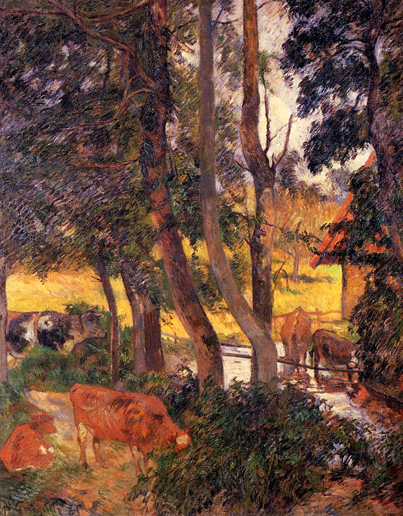
Cattle Drinking
(aka Edge of the Pond): 1885

Cavalier devant la case: 1902

Chicken Coup: 1873-78
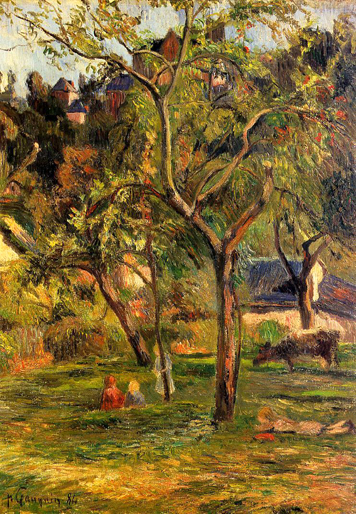
Children in the Pasture (aka Orchard below Bihorel Church): 1884
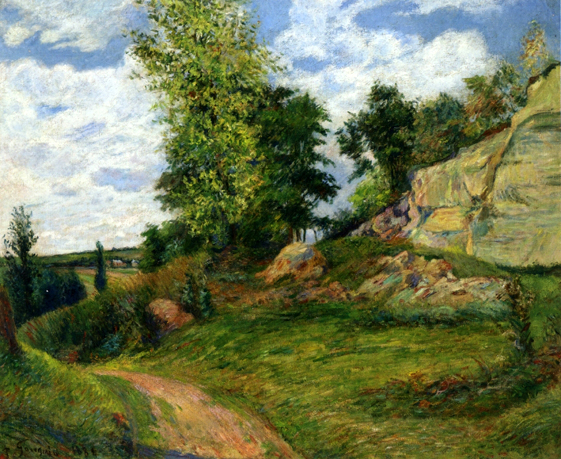
Chou Quarries at Pontoise I: 1882
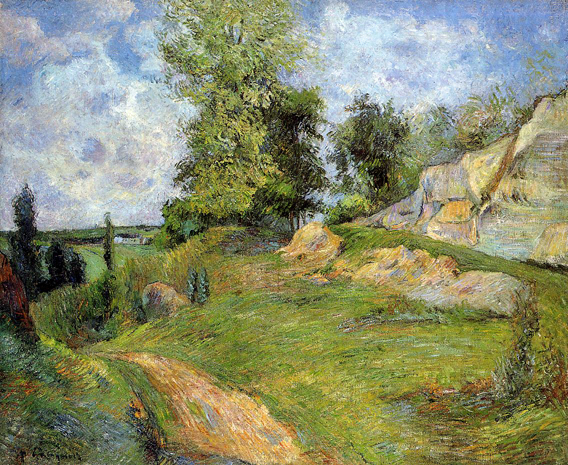
Chou Quarries at Pontoise II: 1882
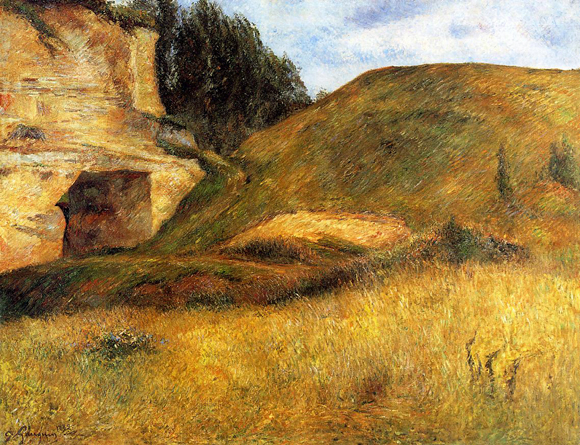
Chou Quarry, Hole in the Cliff: 1882
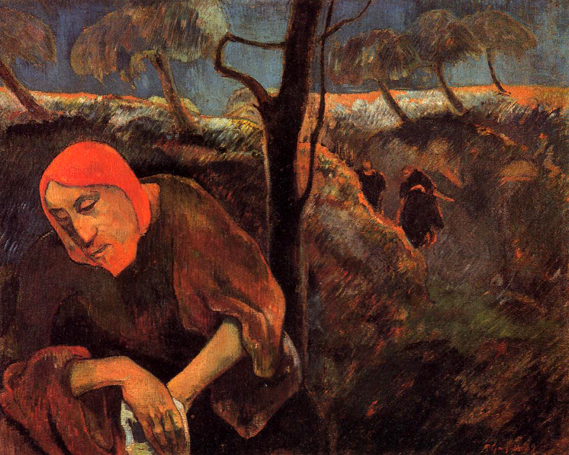
Christ in the Garden of Olives: 1889
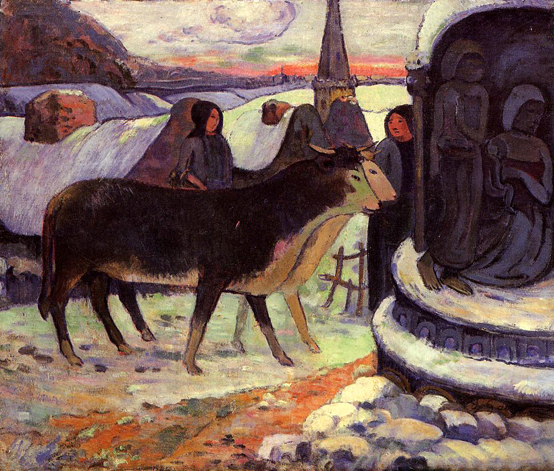
Christmas Night: 1896
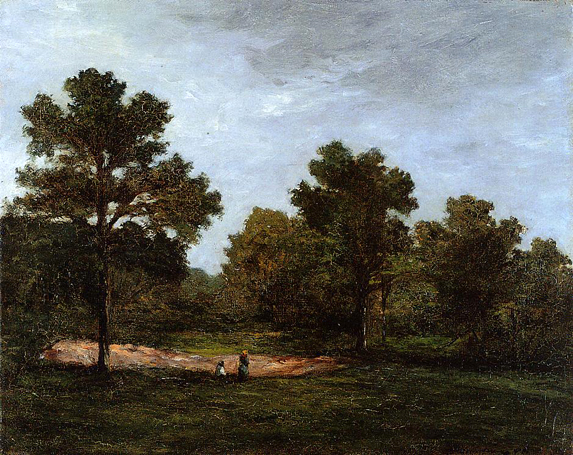
Clearing I: 1873-74
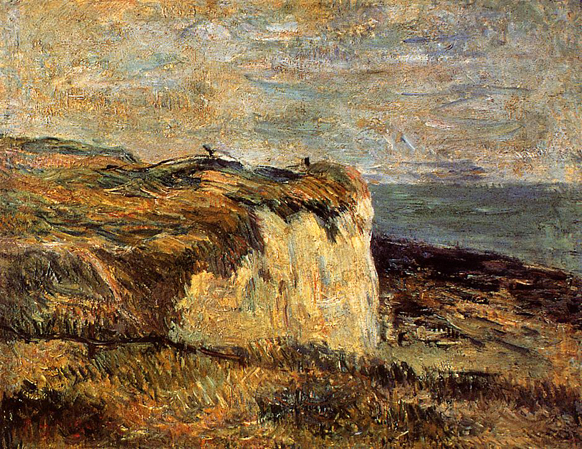
Cliff near Dieppe: 1885

Clovis: 1886
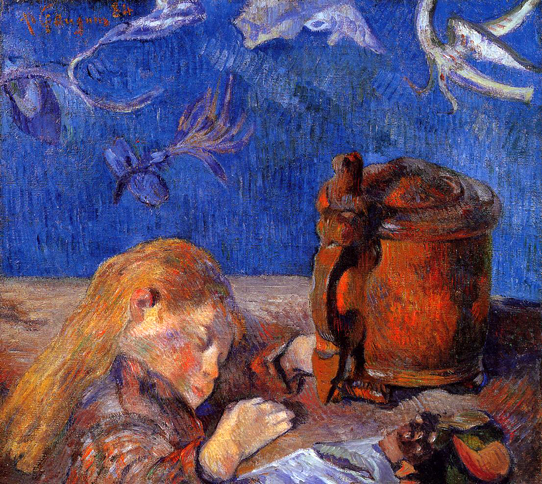
Clovis Gauguin Asleep: 1884
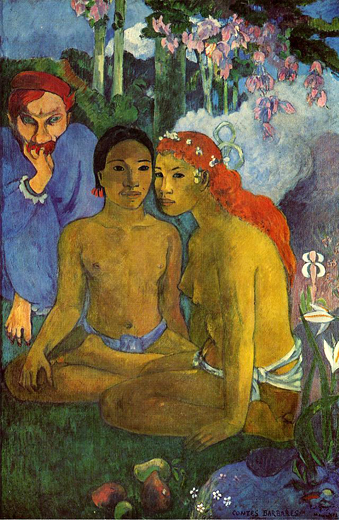
Contes Barbares
(aka Primitive Tales): 1902
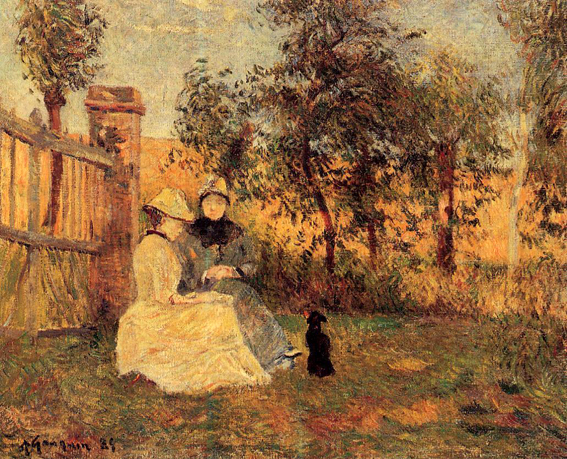
Conversation: 1885
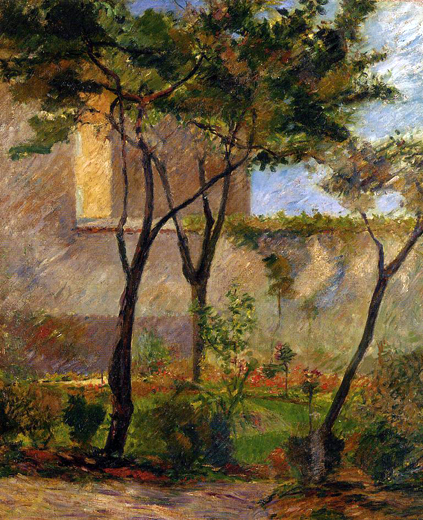
Corner of the Garden, rue Carcel: ca 1881-82
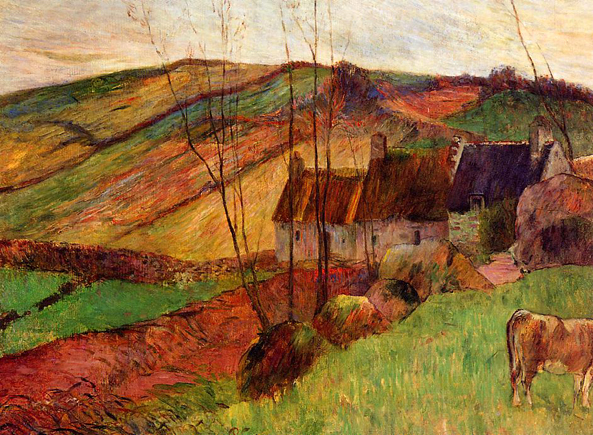
Cottages on Mount Sainte, Marguerite: 1888
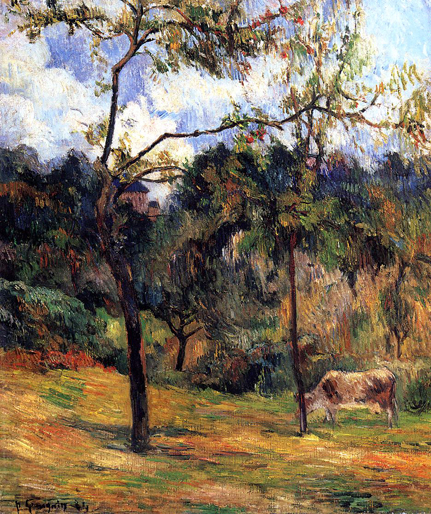
Cow in a Meadow, Rouen: 1884
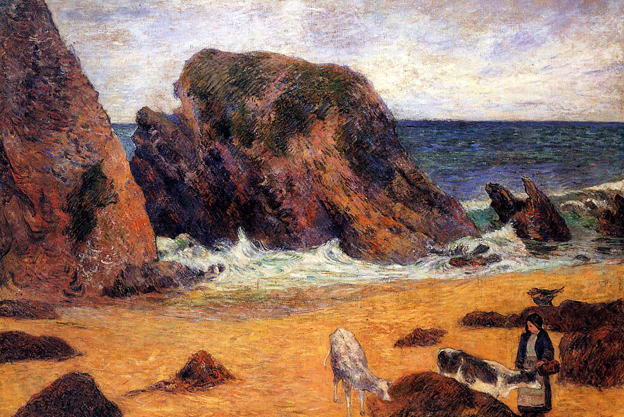
Cows by the Sea: 1886

Crouching Marquesan Woman Seen from the Back: ca 1902
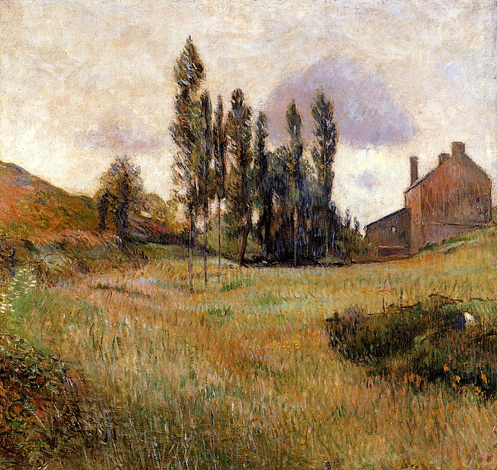
Dogs Running through a Field: 1888
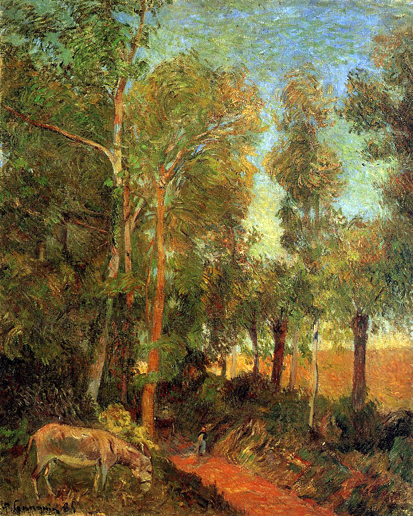
Donkey by the Lane: 1885
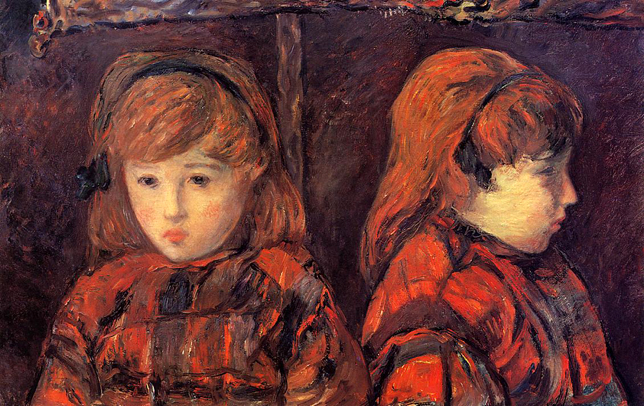
Double Portrait of a Young Girl: 1883
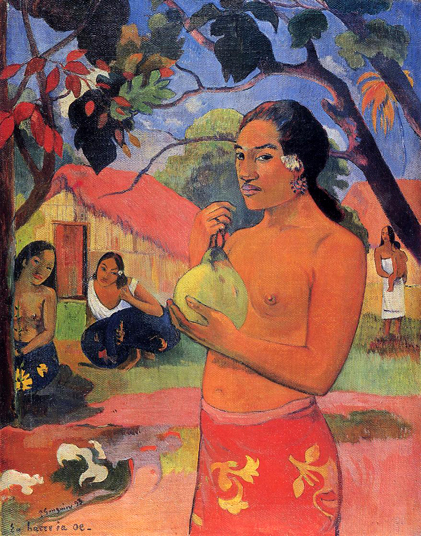
Ea haere la oe
(aka Where are You Going?): 1893

Eilaha Ohipa
(aka Not Working): 1896

Faa Iheihe: 1898
In 1891 Gauguin travelled to the South Pacific islands, where he stayed for nearly the rest of his life, mostly on the island of Tahiti. The title of this painting is almost certainly a misunderstanding on the artist's part of the Tahitian word 'fa`ai`ei`e' which means "to beautify, adorn, embellish", in the sense of making oneself beautiful for a special occasion.
In common with many of his other paintings of the period, for example 'Where Do We Come From? What are We? Where are We Going?' of 1897 (Boston, Museum of Fine Arts), Gauguin has used a horizontal format inspired by Javanese sculptured friezes. Some of the individual figures, such as the central woman, are also taken from such friezes. The three women on the left and the horseman reappear in 'Rupe Rupe (Luxury)' of 1899 (Moscow, Pushkin State Museum of Fine Arts).
Quoted From: (NGA), London, - Faa Iheihe, 1898

Faa Iheihe (Detail)
(aka Tahitian Pastoral): 1898
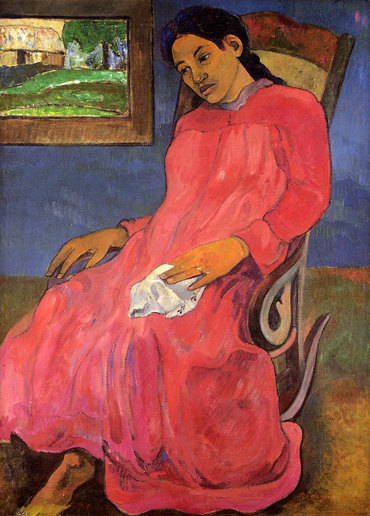
Faaturuma
(aka Melancholy): 1891

Farm in Osny: 1883
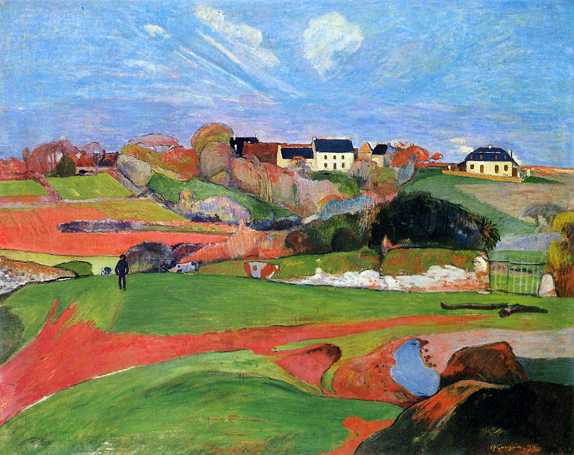
Fields at le Pouldu: 1890
After his first stay in Brittany, Gauguin returned to Paris in time for the 1889 international exposition marking the centennial of the French Revolution. Refused space at the official art exhibition, he mounted an independent show with several colleagues near the entrance to the huge fair, billing their work "impressioniste et synthétiste," but it was not a success. He decided to escape Paris and its scornful critics. Among the most popular attractions at the exposition, and Gauguin's personal favorites, had been performances by Buffalo Bill's Wild West Show and a troupe of Javanese dancers-Gauguin began to talk of emigrating to the more exotic lands of Tonkin (Vietnam), Madagascar, or Tahiti. But he returned instead to Brittany.
In 1889 he found the village of Pont-Aven crowded with artists. Seeking a more isolated-and less expensive-environment, he and several colleagues took up residence in Le Pouldu, a small hamlet nine kilometers distant. From there they made many expeditions to the countryside, but their landscapes, like this one, were painted primarily from memory and sketches. "Don't copy nature too literally," Gauguin advised. "Art is abstraction; draw art as you dream in nature's presence, and think more about the act of creation than about the final result."
Quoted From: (NGA) - Landscape at Le Pouldu, 1890
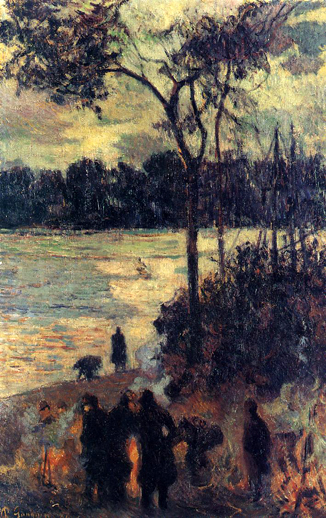
Fire by the Water: 1886
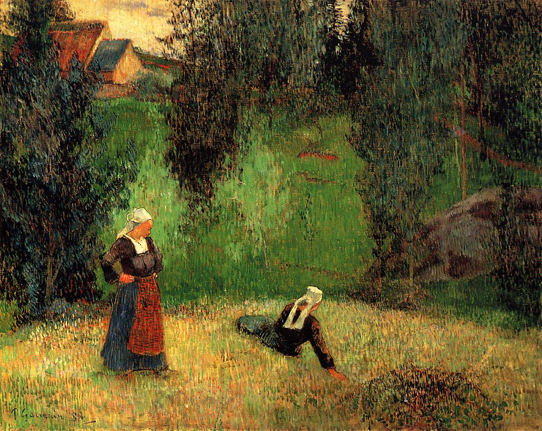
First Spring Flowers: 1888

Flutist on the Cliffs: 1889
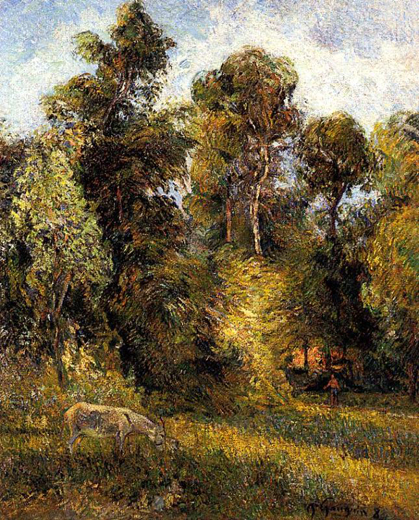
Forest Edge: 1885
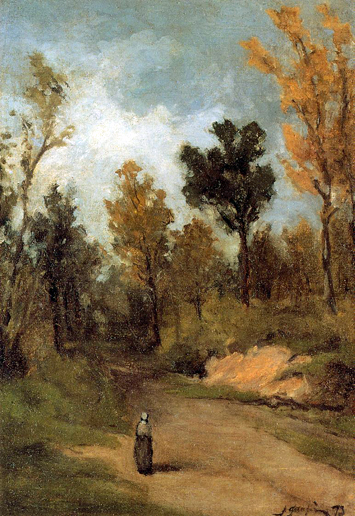
Forest Path: 1873
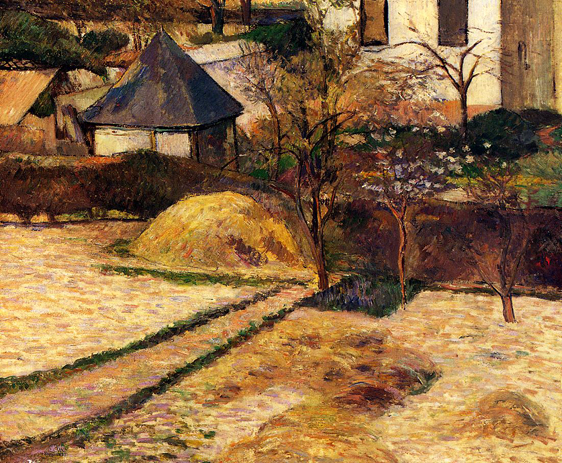
Garden View, Rouen: 1884
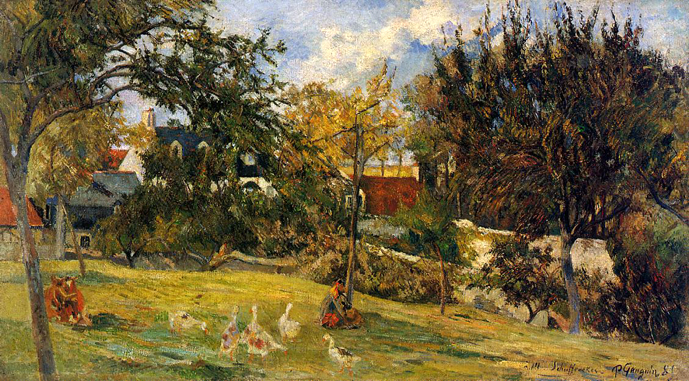
Geese in the Meadow: 1885
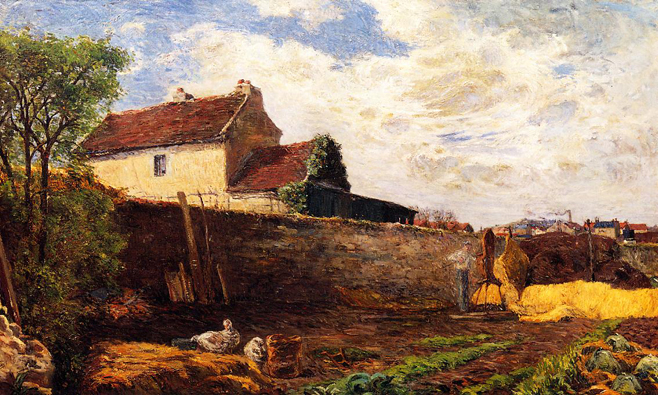
Geese on the Farm: 1879
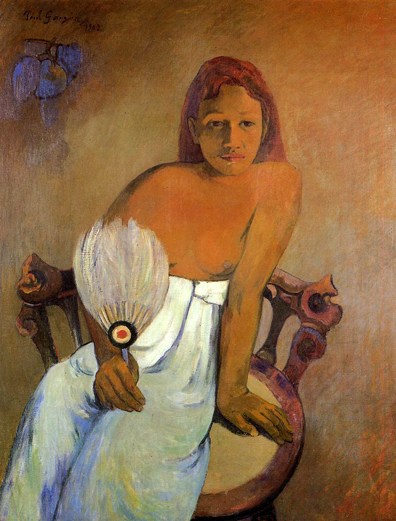
Girl with a Fan: 1902
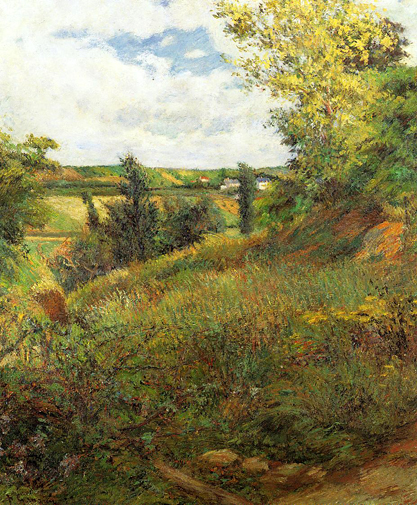
Gratte Coqs Path: 1882
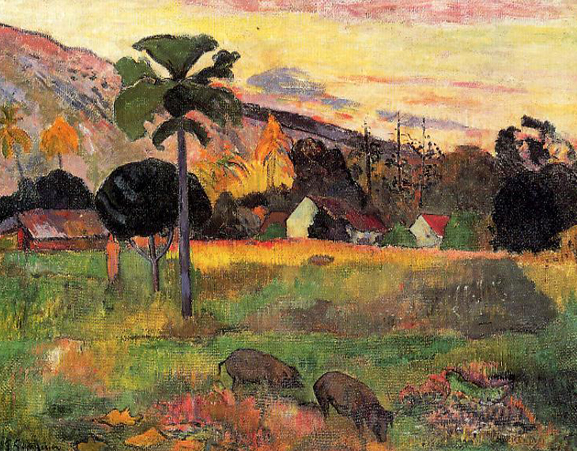
Haere mai venezi
(aka Come Here: 1891
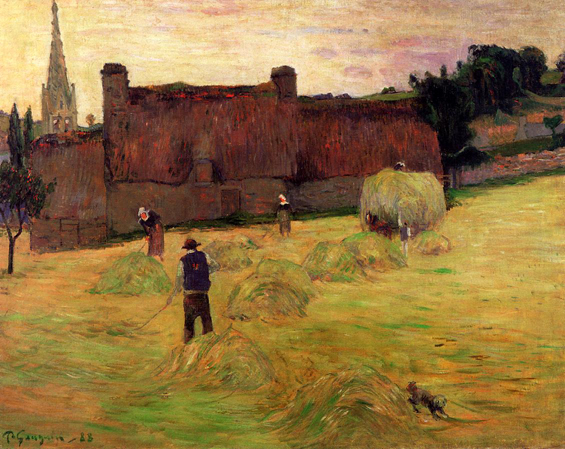
Haymaking: 1888

Haymaking near Dieppe: 1885
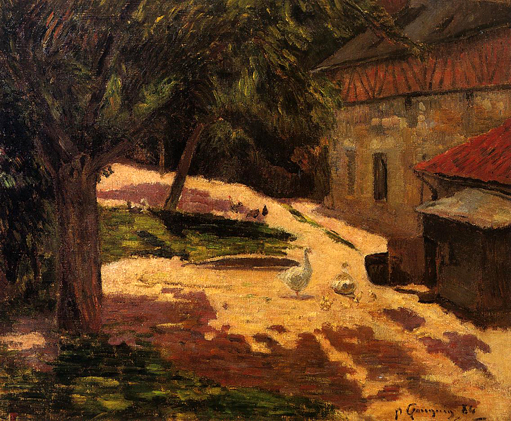
Henhouse: 1884
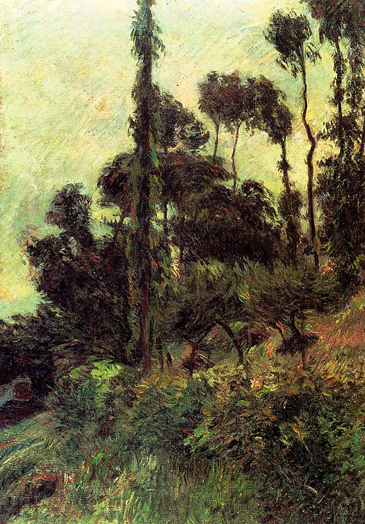
Hillside: 1884

Hina tefatou
(aka The Moon and the Earth): 1893
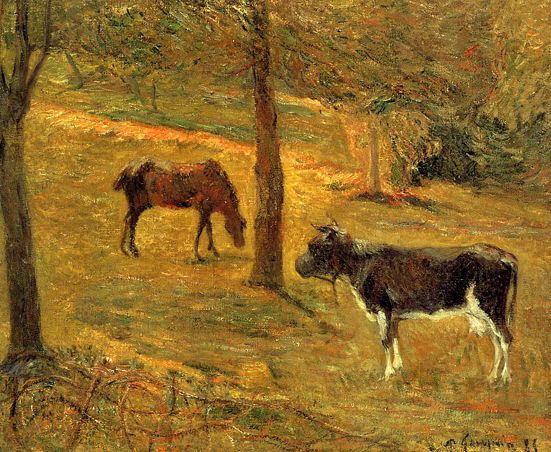
Horse and Cow in a Field: 1885
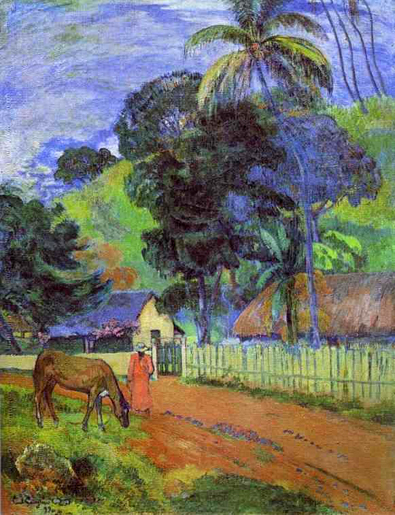
Horse on Road, Tahitian Landscape: 1899
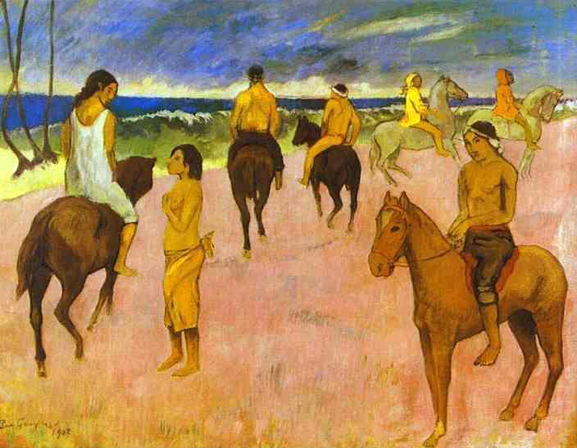
Horsemen on the Beach: 1902
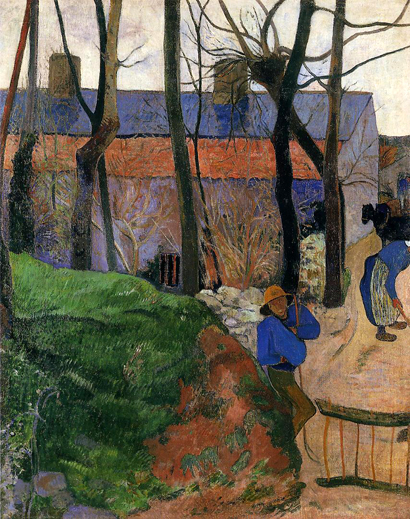
Houses in le Pouldu: 1890
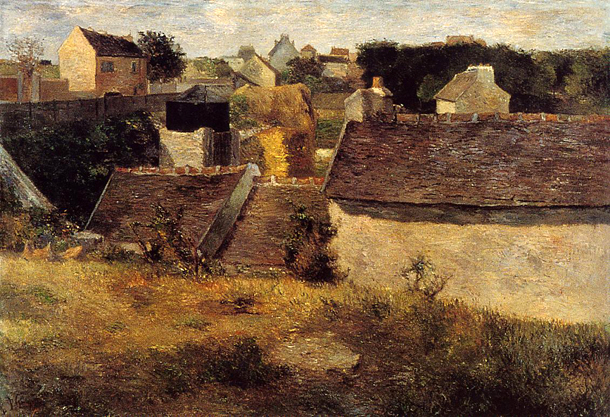
Houses, Vaugirard: 1880

Human Misery: 1889

Huts under the Trees: 1887

I rara te oviri
(aka Beneath the Pandanus Tree): 1891
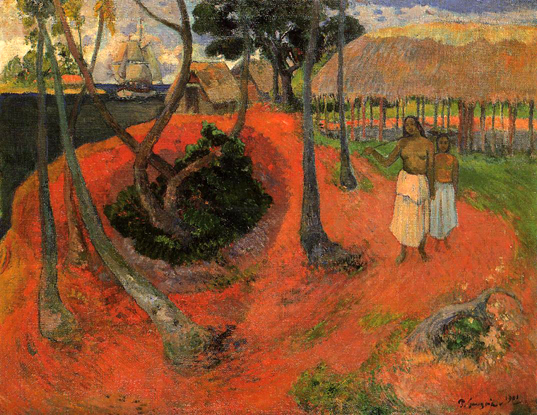
Idyll in Tahitgi: 1901
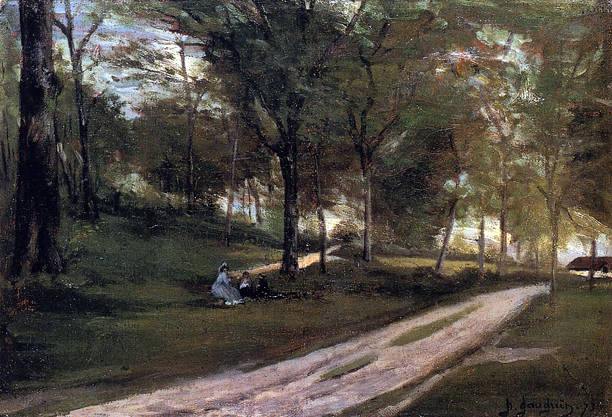
In the Forest, Saint Cloud II: 1873
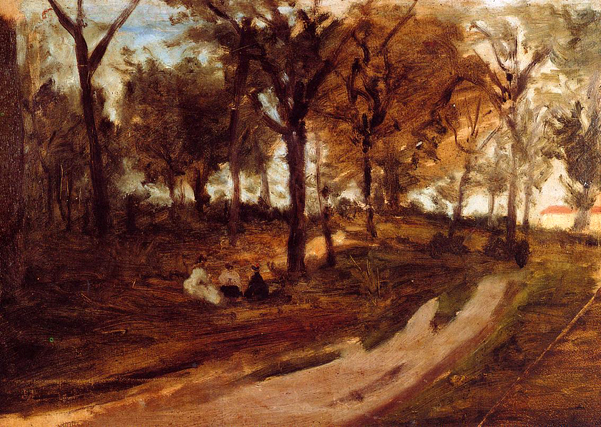
In the Forest, Saint-Cloud (sketch): 1873
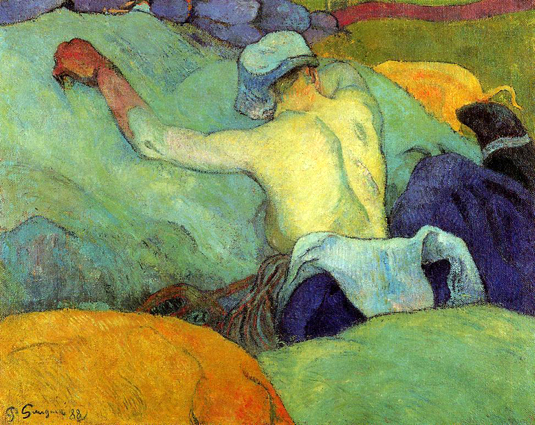
In the Heat of the Day: 1888
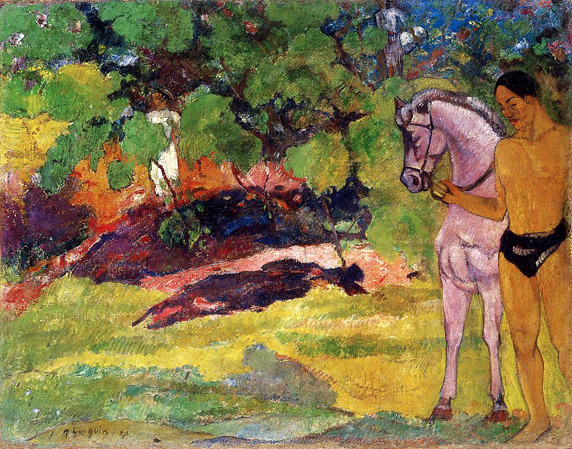
In the Vanilla Grove, Man and Horse
(aka The Rendezvous): 1891
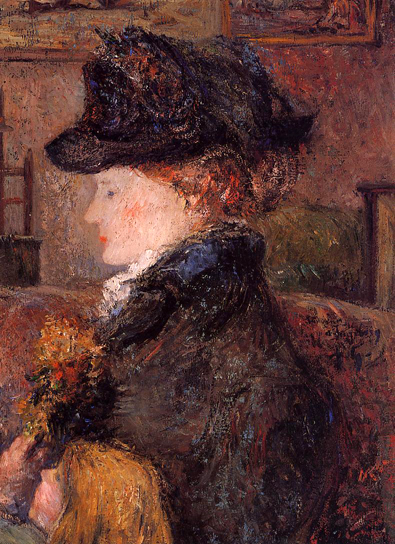
Ingeborg Thaulow: ca 1883
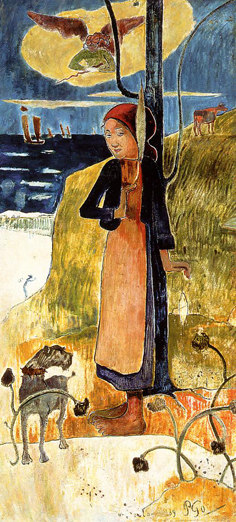
Joan of Arc: 1889
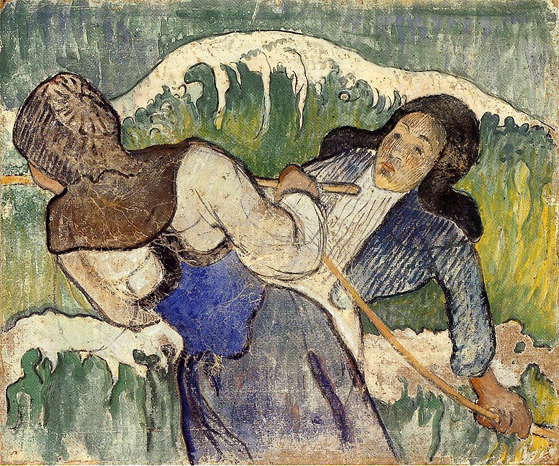
Kelp Gatherers: 1889-90

Kneeling Cow: 1888

La Groue Farm, Osny: 1883

Landscape: 1885
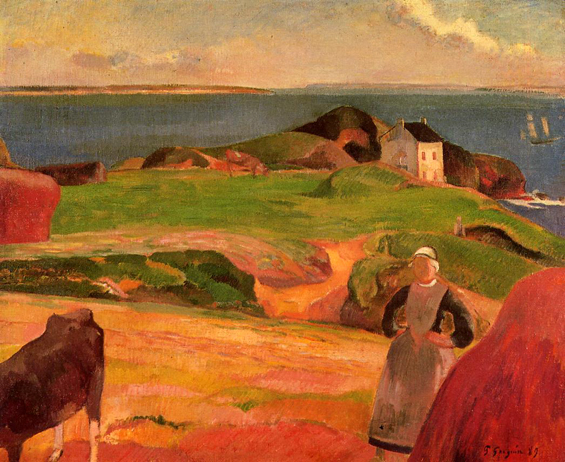
Landscape at le Pouldu, the Isolated House: 1889

Landscape with Black Pigs and a Crouching Tahitian: 1891

Landscape with Cows in an Orchard: 1885
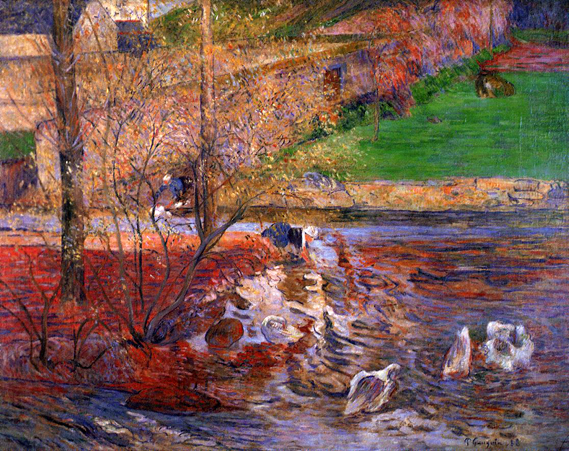
Landscape with Geese: 1888

Landscape with Poplars: 1875

Landscape with Three Figures: 1901
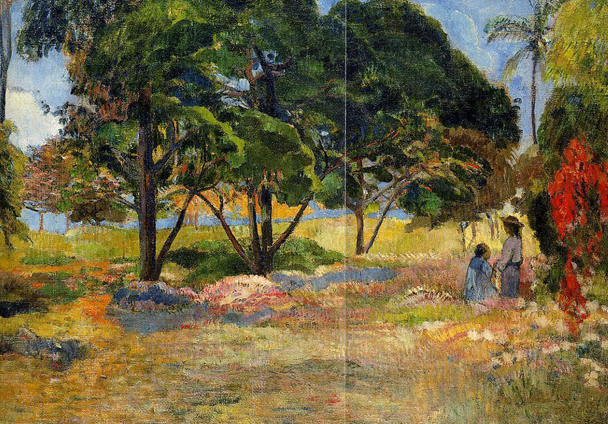
Landscape with Three Trees: 1892

Landscape with Two Goats: 1897
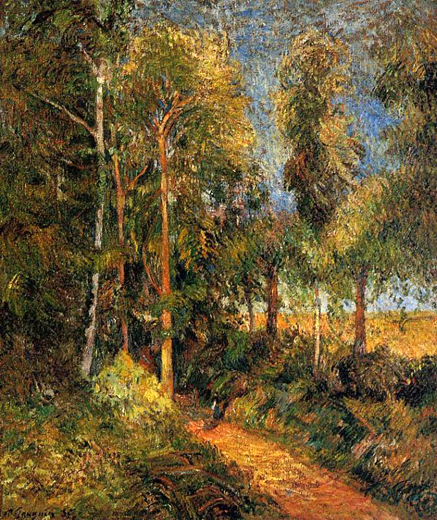
Lane through the Beaches: 1885
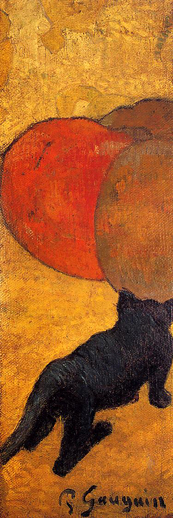
Little Cat: 1888

Lollichon Field: 1886
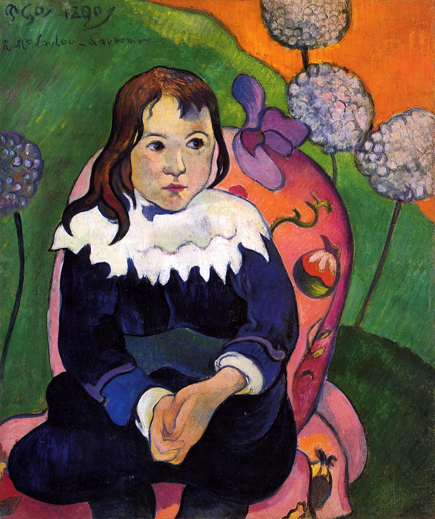
M. Loulou: 1890
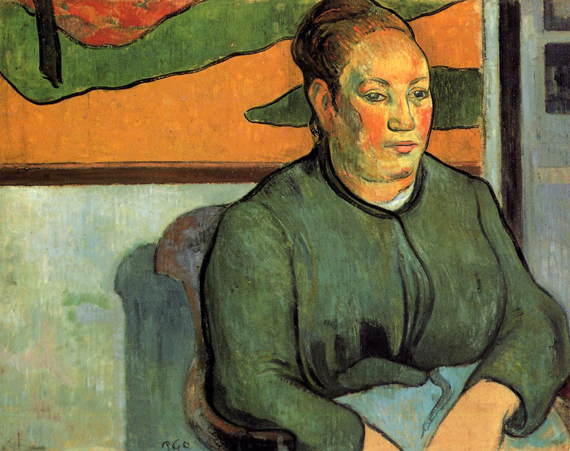
Madame Roulin: 1888
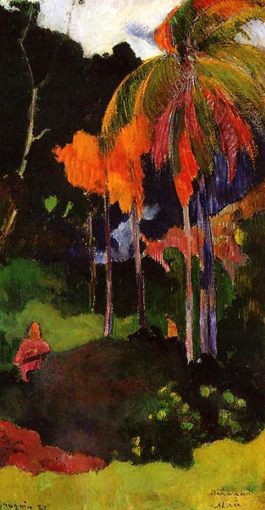
Mahana maa I
(aka The Moment of Truth I): 1892
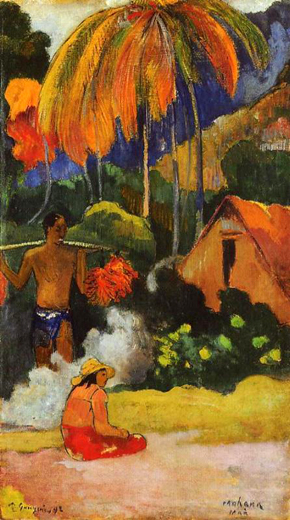
Mahana maa II
(aka The Moment of Truth II): 1892
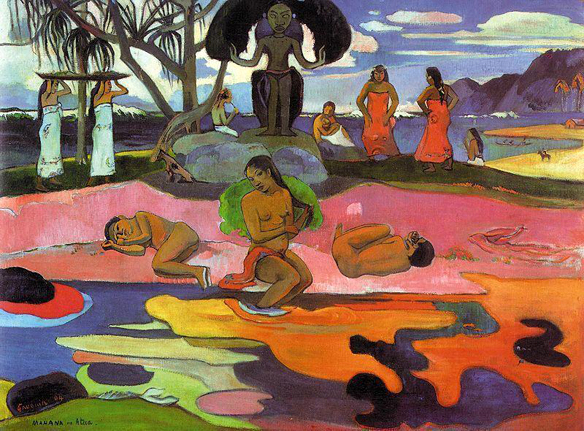
Mahana no atua (aka Day of the Gods): 1894
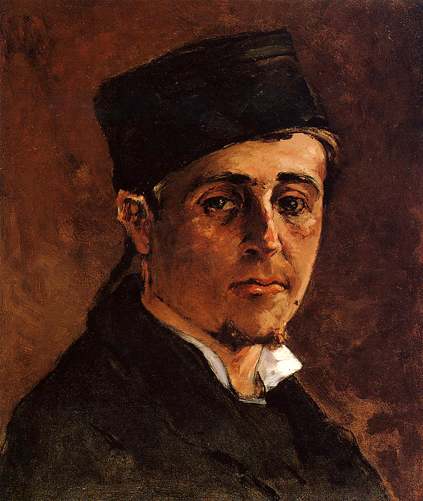
Man with a Toque: 1875-77
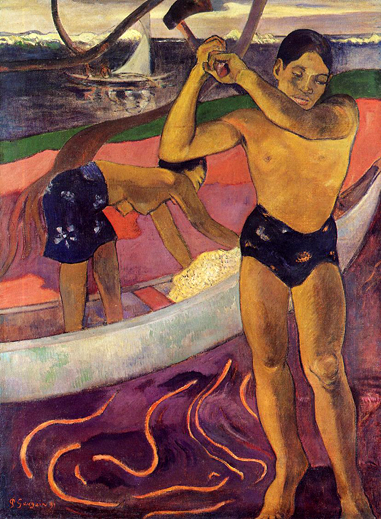
Man with an Ax: 1891
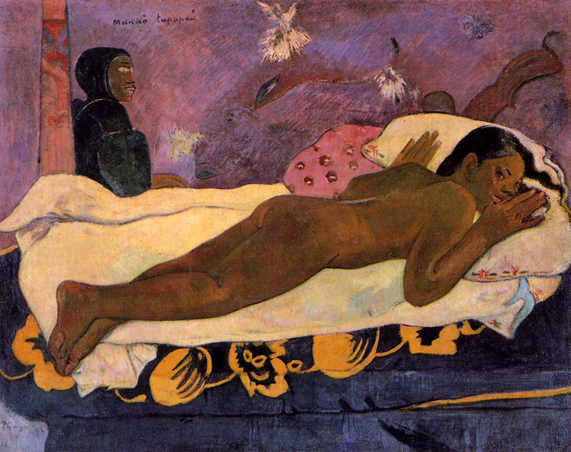
Manao Tupapau (aka Spirit of the Dead Watching): 1892
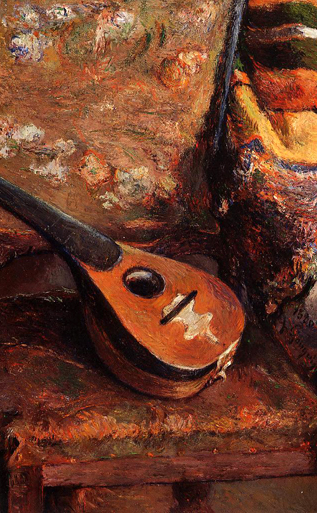
Mandolin on a Chair: 1880
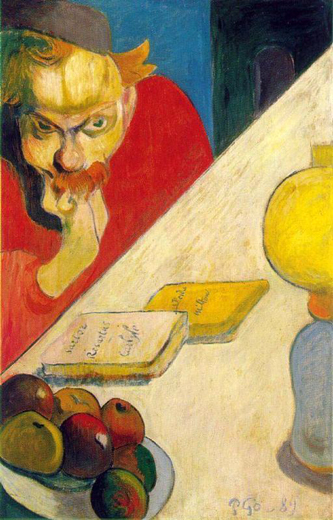
Meyer de Haan: 1889
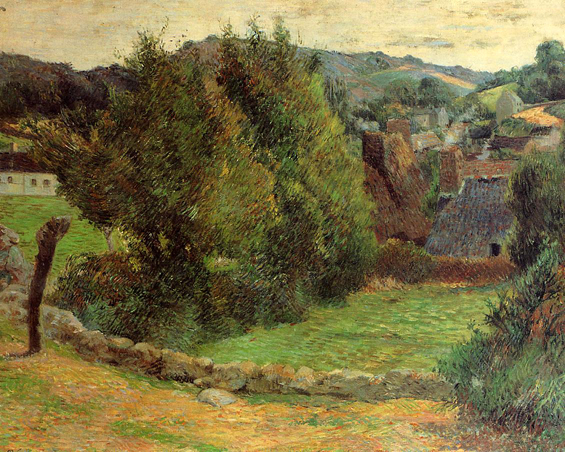
Mount Sainte-Marguerite from near the Presbytery: 1886

Mountain Landscape: 1882
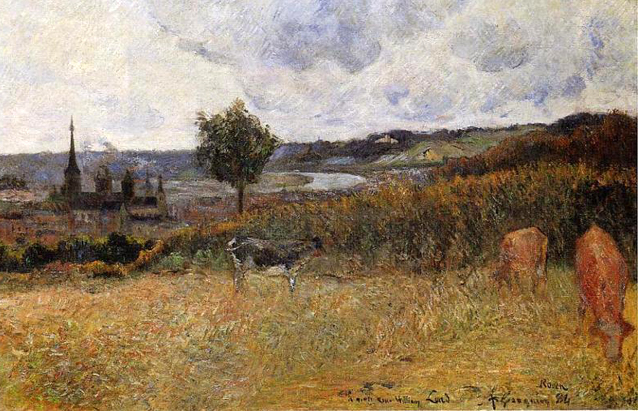
Near Rouen: 1884

Near Rouen, II: 1884

Nostalgic Promenade: 1889
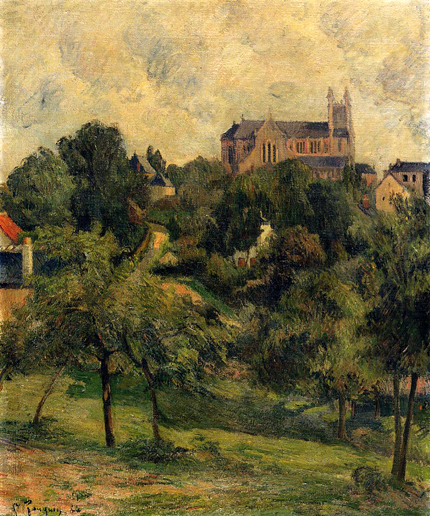
Notre Dame des Agnes, Rouen: 1884
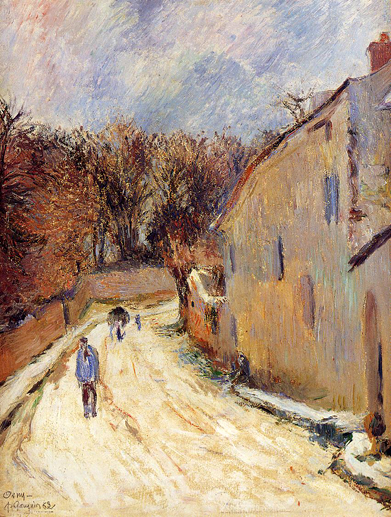
Osny, rue de Pontoise, Winter: 1883
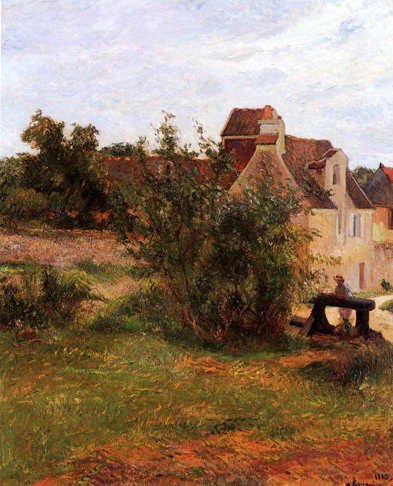
Osny, the Gate, Busagny Farm: 1883
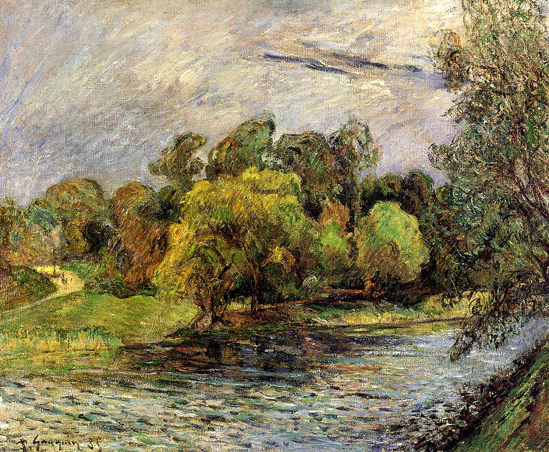
Ostervold Park, Copenhagen: 1885
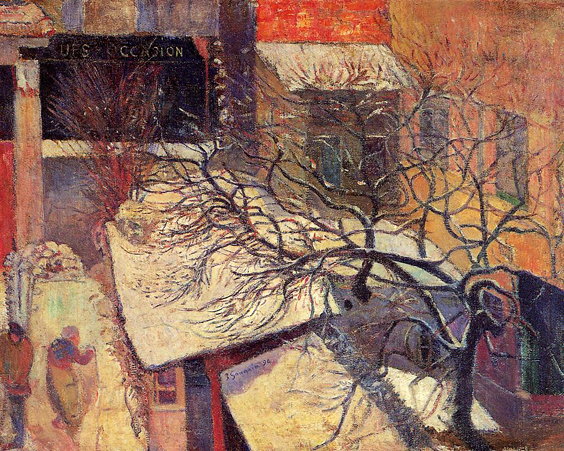
Paris in the Snow: 1894
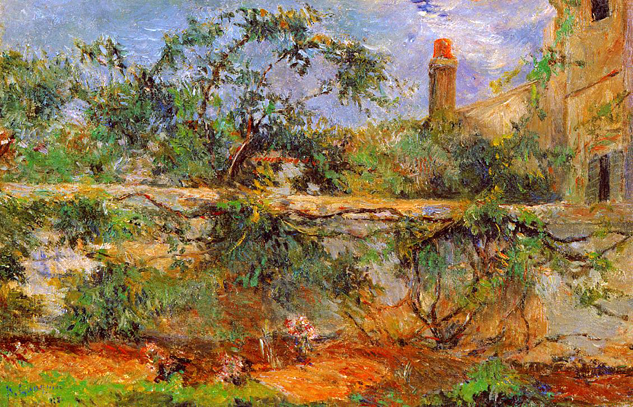
Party Wall: 1881
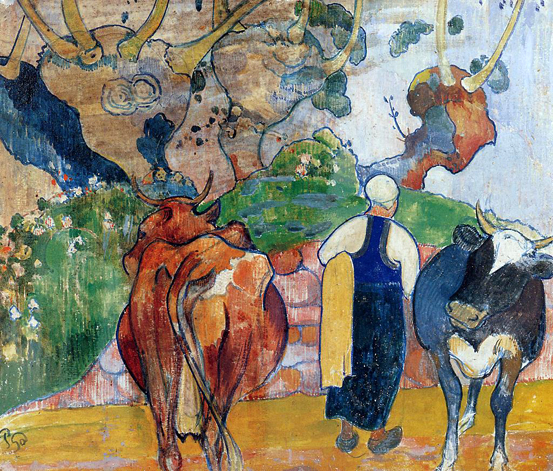
Peasant Woman and Cows in a Landscape: 1889-90
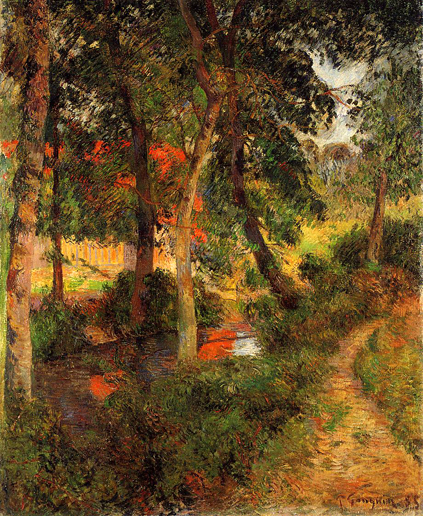
Pere Jean's Path: 1885
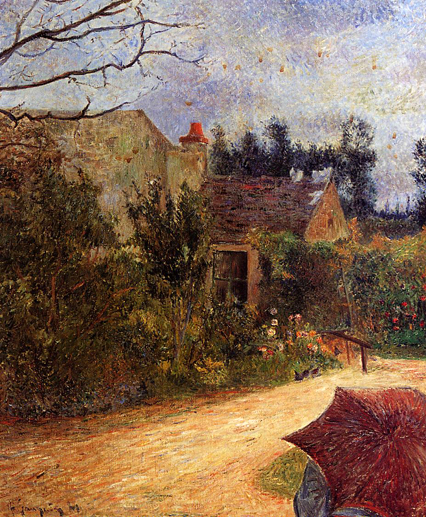
Pissarro's Garden, Quai du Pothuis, Pontoise: 1881

Pond with Ducks
(aka Girl Amusing Herself): 1881
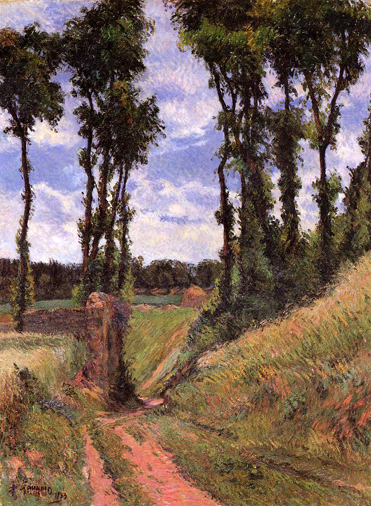
Poplars, Osny: 1883
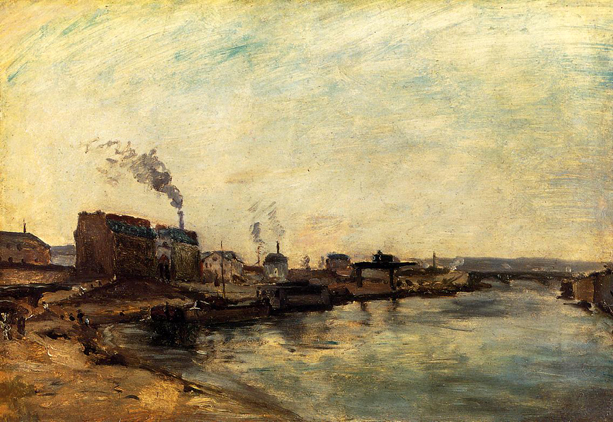
Port de Grenelle: 1875
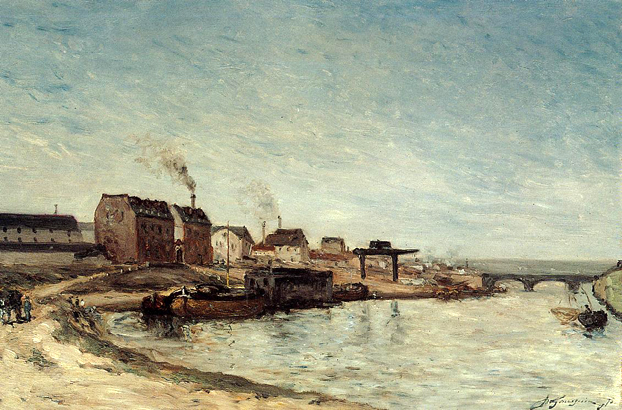
Port de Grenelle II: 1875
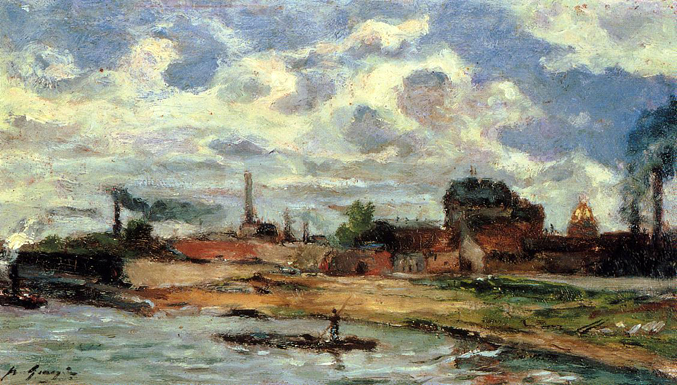
Port de Javel: 1876
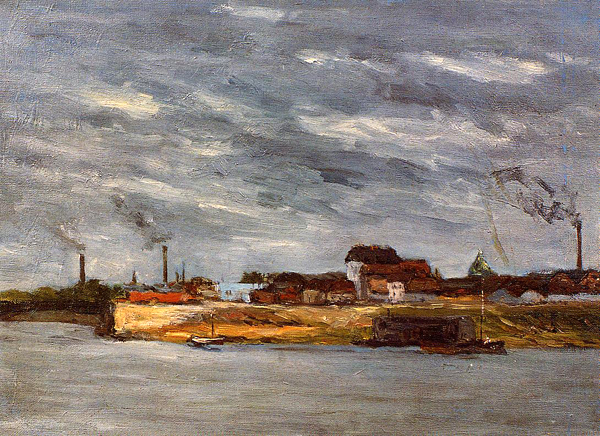
Port de Javel II: 1876
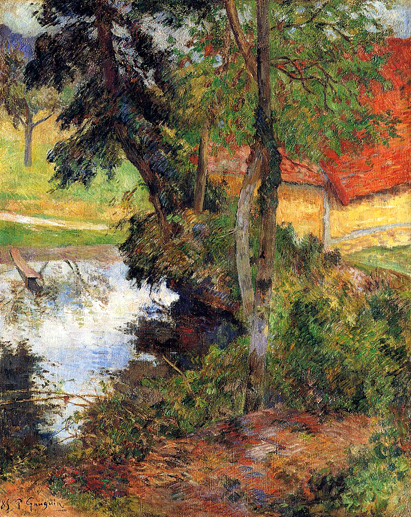
Red Roof by the Water: 1885

Redheaded Woman and Sunflowers: 1890-91
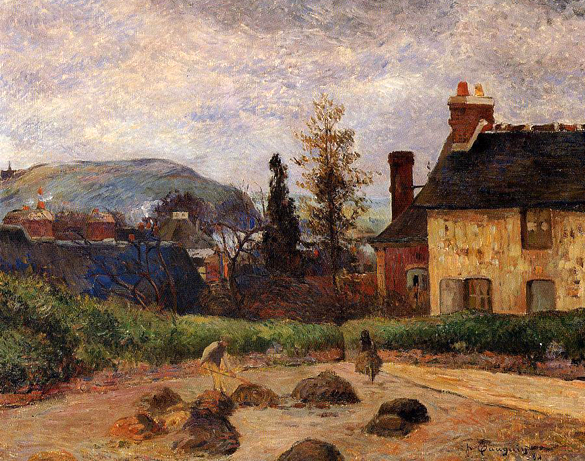
Returning from the Harvest
(aka Manuring): 1884
_1881_82.jpg)
River Bank in Winter (study): 1881-82
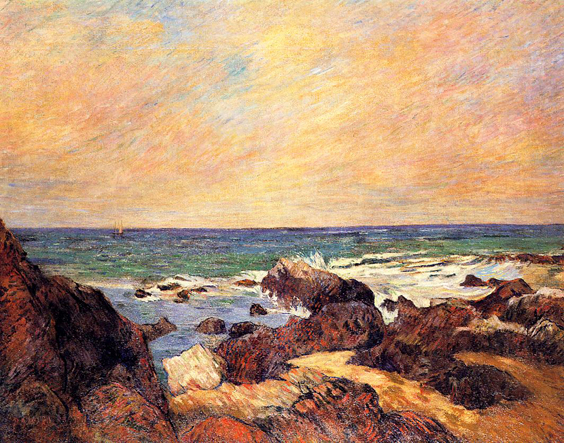
Rocks and Sea: 1886
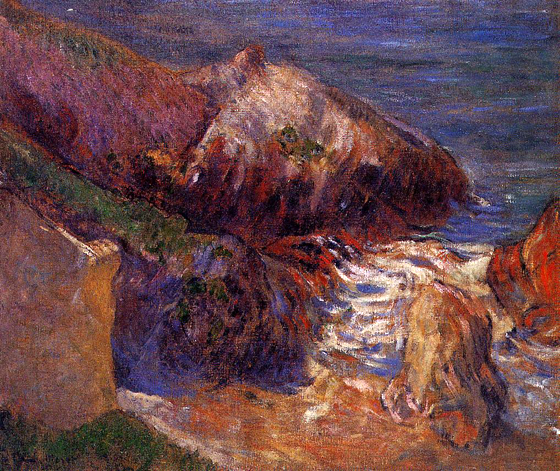
Rocks on the Coast: 1888
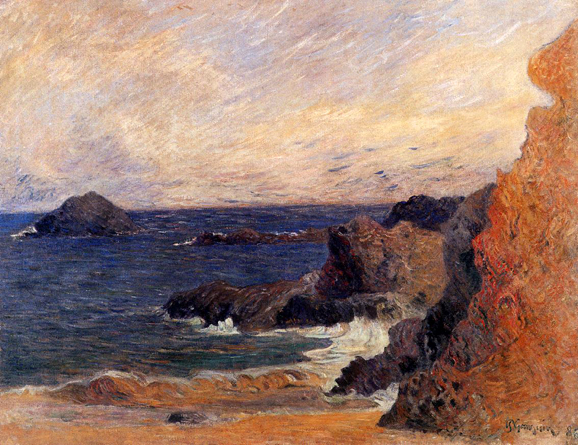
Rocky Coast: 1886
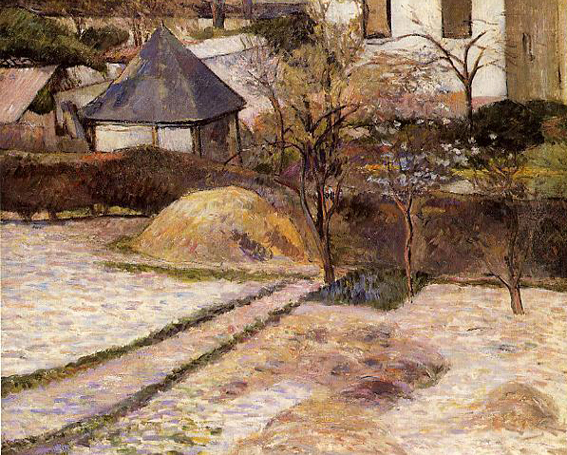
Rouen Landscape: ca 1884
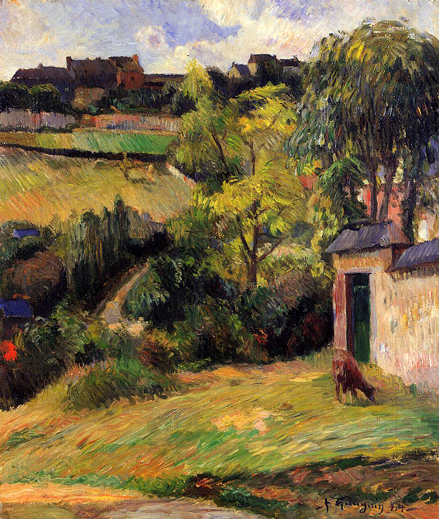
Rouen Suburb: 1884
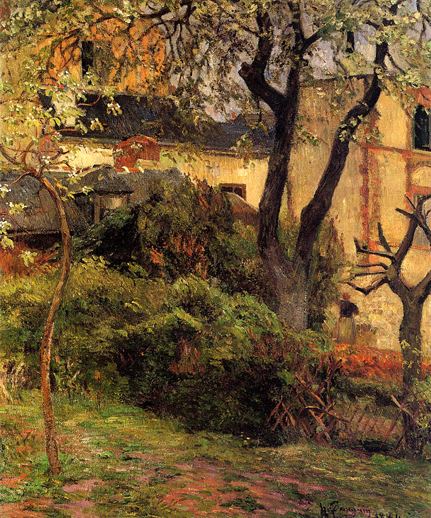
Rouen, Spring: 1884
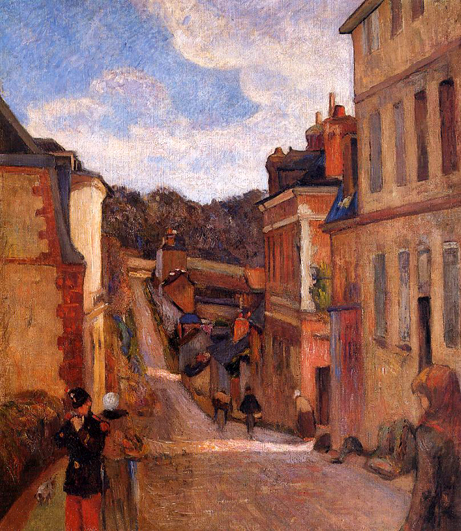
Rue Jouvenet, Rouen: 1884
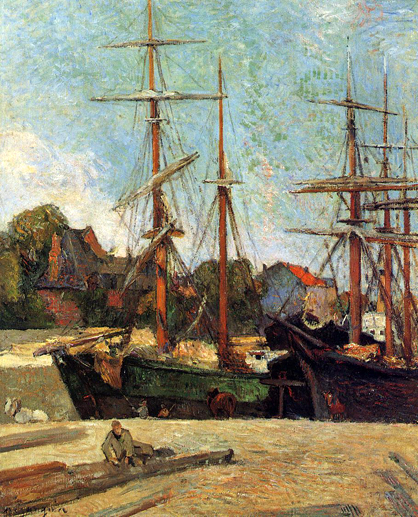
Schooner and Three-Master: 1886
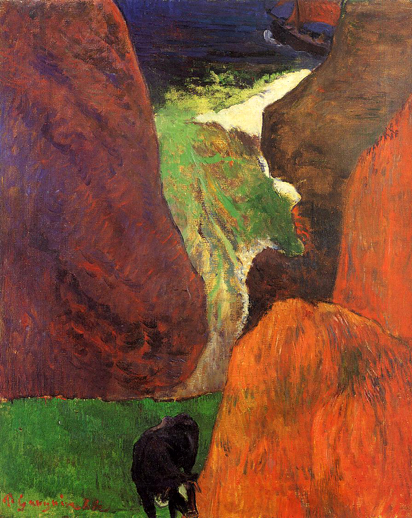
Seascape with Cow on the Edge of a Cliff: 1888
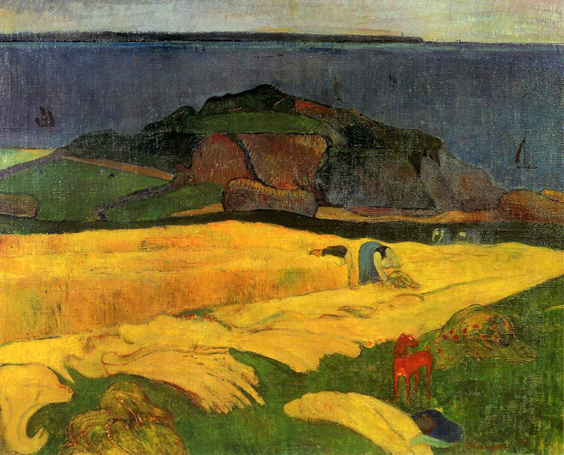
Seaside Harvest, le Pouldu: 1890
Harvest: Le Pouldu
In 1890 Gauguin was staying at Marie Henry's boarding house in Le Pouldu, Brittany. The headland in this painting is at the western end of the beach, about a mile from the village itself.
Gauguin painted other versions of this landscape, all of which are characterized by the strongly defined forms and flat areas of colour of his Synthetist style. He also used it in a simplified form for the background of his Symbolist work, 'The Loss of Virginity', painted in Paris in the winter of 1890-91 (Norfolk, Virginia, The Chrysler Museum).
Quoted From: (NGA), London, - Harvest: Le Pouldu, 1890

Seaweed Gatherers: 1899
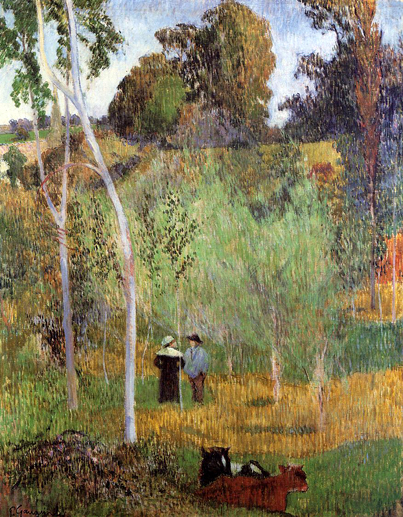
Shepherd and Shepherdess in a Meadow: 1888
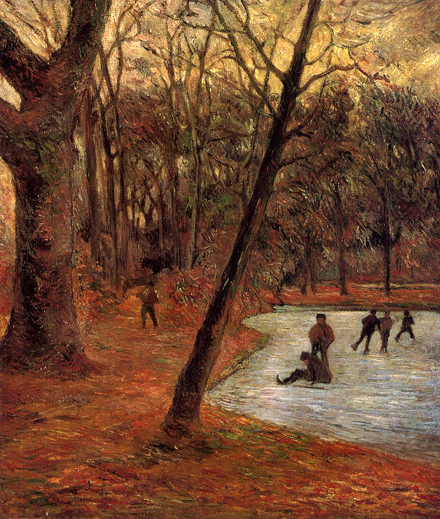
Skaters in Fredericksberg Park: 1884-85
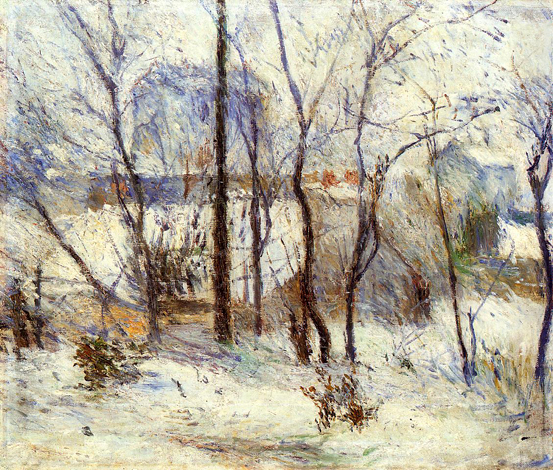
Snow at Vaugirard: 1879
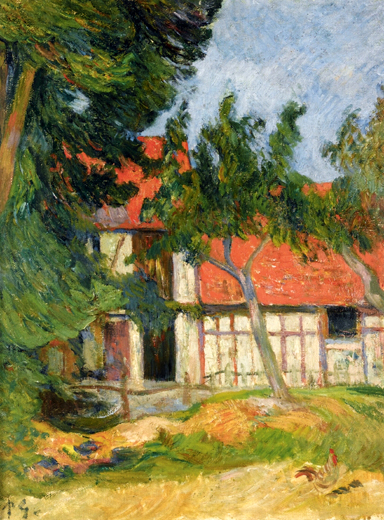
Stable near Dieppe: 1885
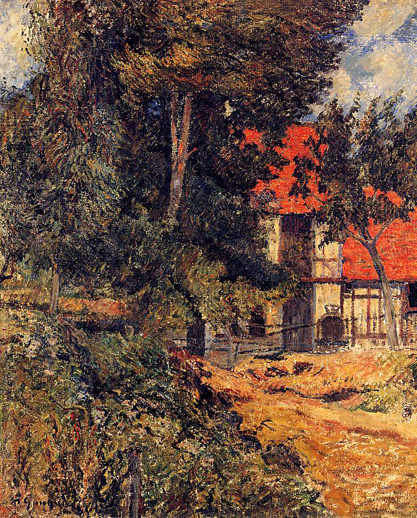
Stable near Dieppe: ca 1885
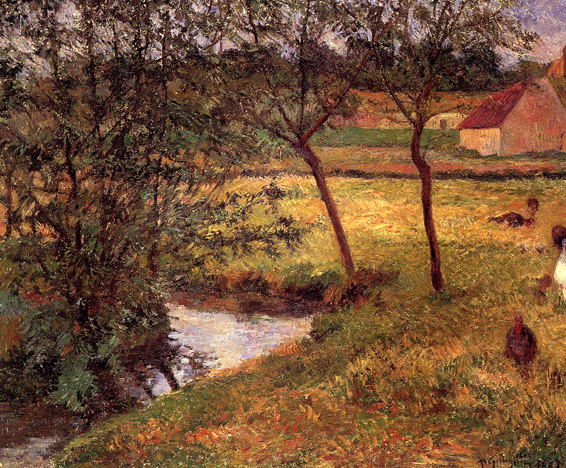
Stream, Osny: 1883

Street, Rouen: 1884
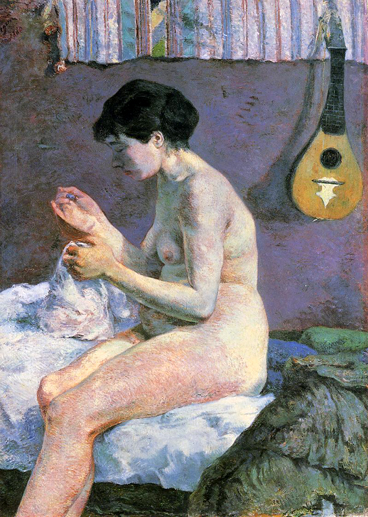
Study of a Nude, Suzanne Sewing: 1880
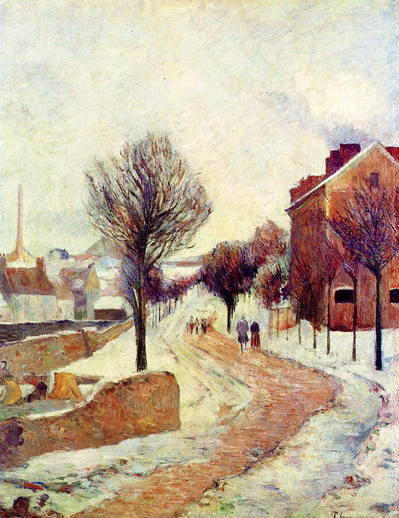
Suburb under Snow: 1886
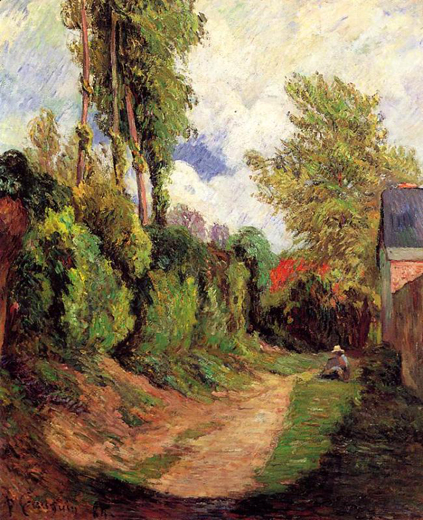
Sunken Lane: 1884
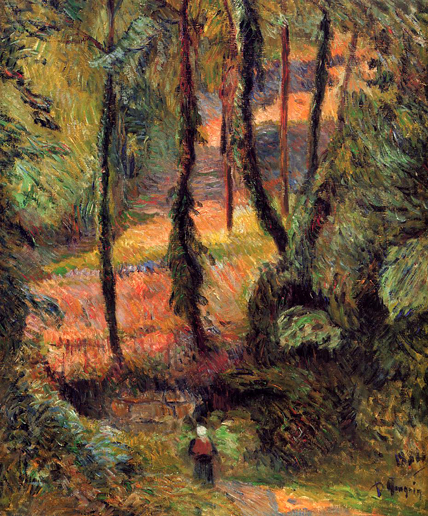
Sunken Path, Wooded Rose: 1884
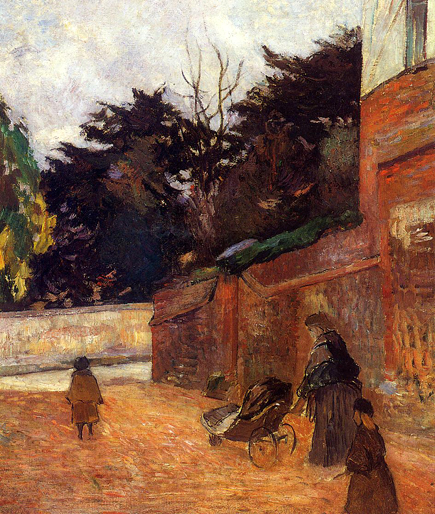
The Artist's Children, Impasse Malherne: 1884
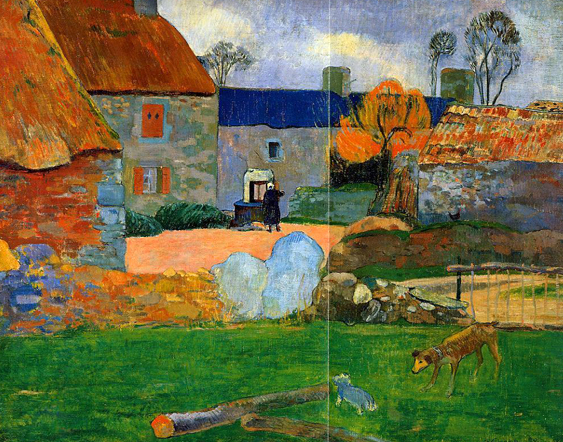
The Blue Roof: 1890
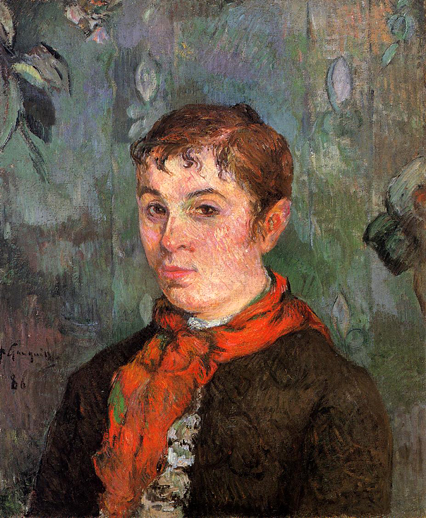
The Boss's Daughter: 1886

The Cellist
(aka Portrait of Fritz Scheklud): 1894
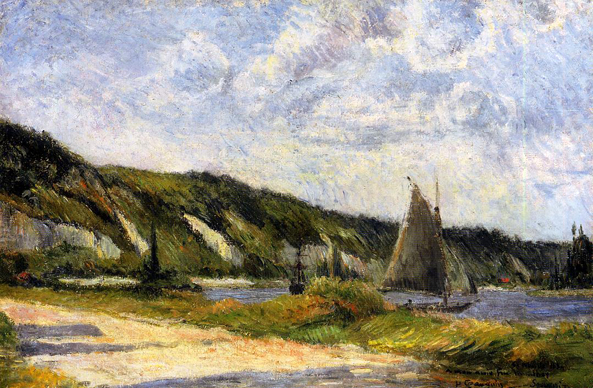
The Cliffs of Le Bouille: 1884
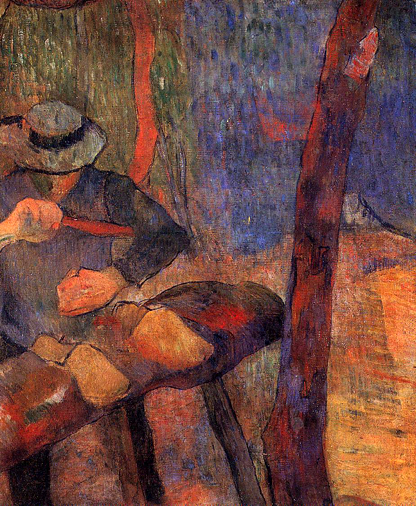
The Clog Maker: 1888
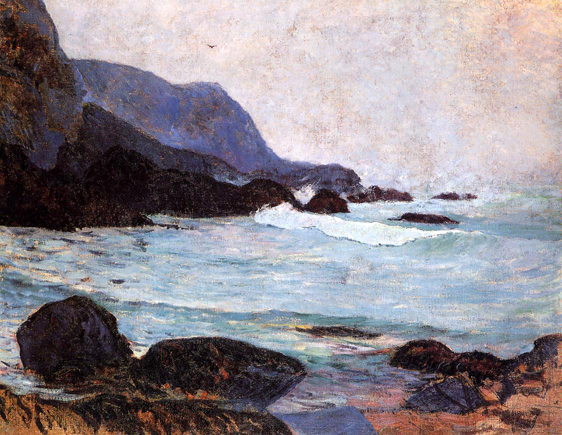
The Coast of Bellangenay: ca 1890
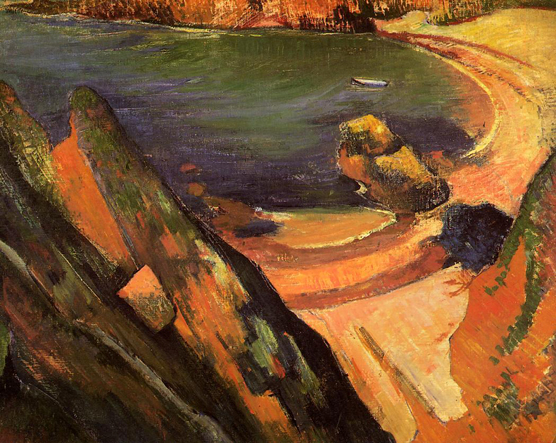
The Creek 'Le Pouldu: 1889-90
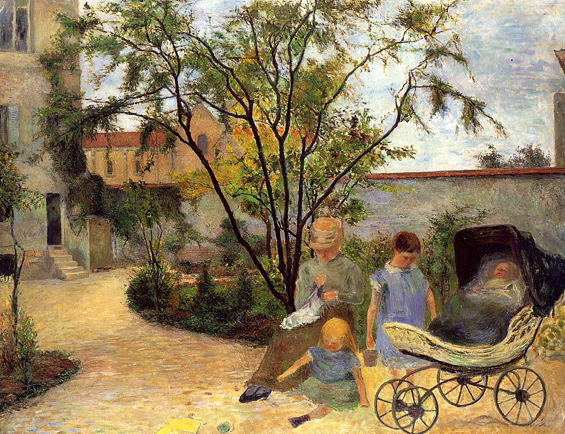
The Family in the Garden, rue Carcel: 1881
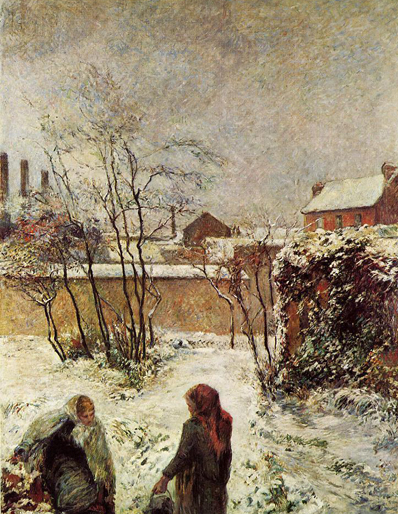
The Garden in Winter, rue Carcel: 1883
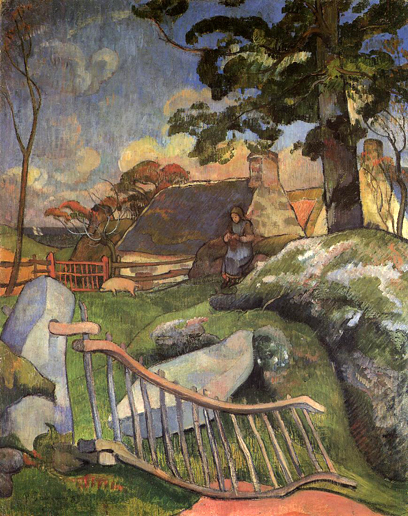
The Gate (aka The Swineherd): 1889
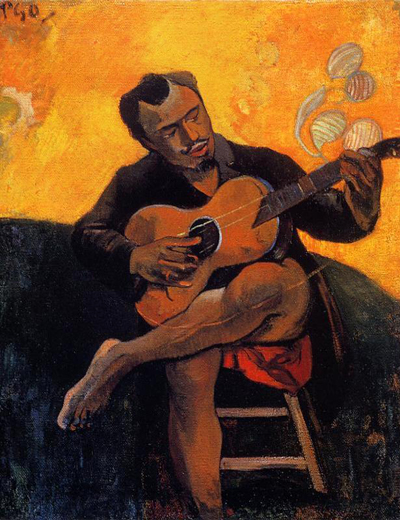
The Guitar Player: ca 1894
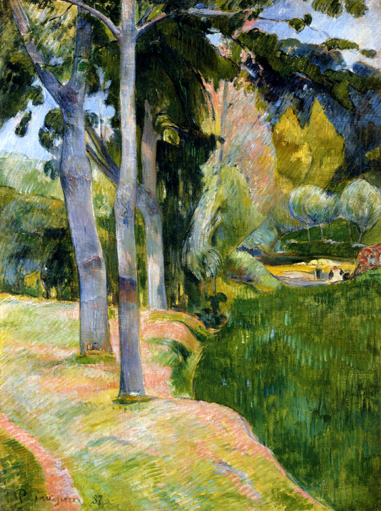
The Large Trees: 1889
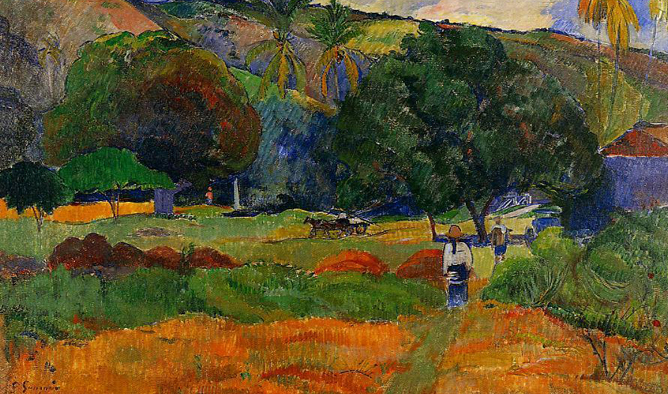
The Little Valley: 1891-92

The Market Gardens of Vaugirard: 1879
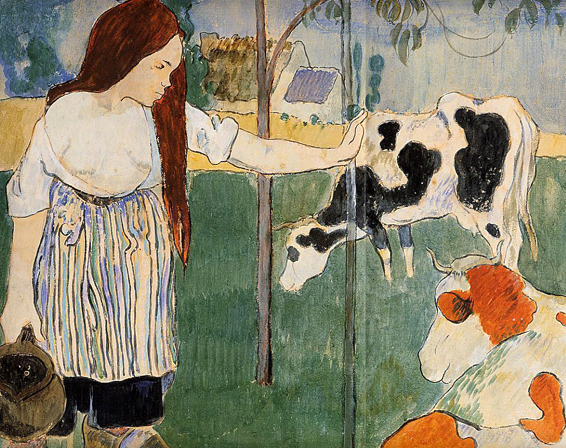
The Milkmaid: 1889
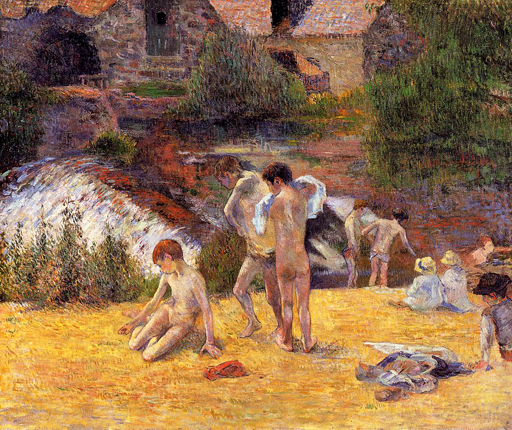
The Moulin du Bois d'Amour Bathing Place: 1886

The Port of Rouen: 1884
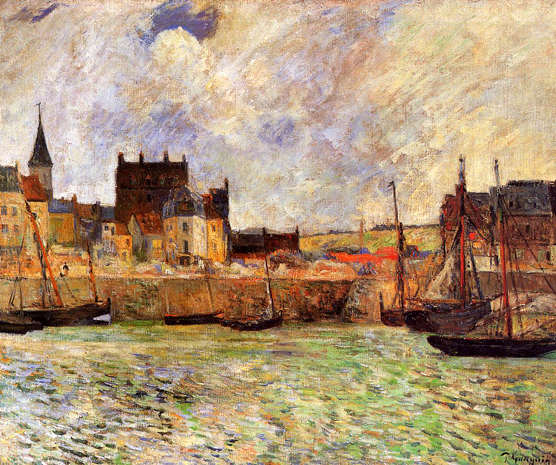
The Port of Dieppe: 1885
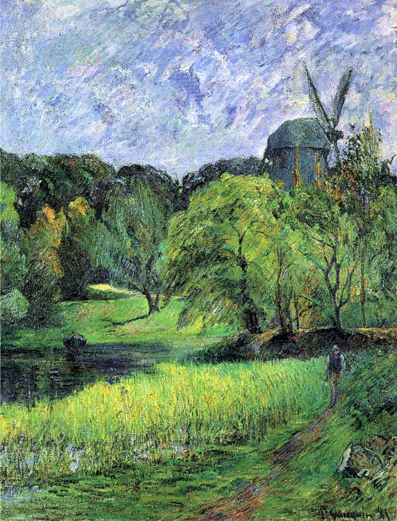
The Queen's Mill, Ostervold: 1885
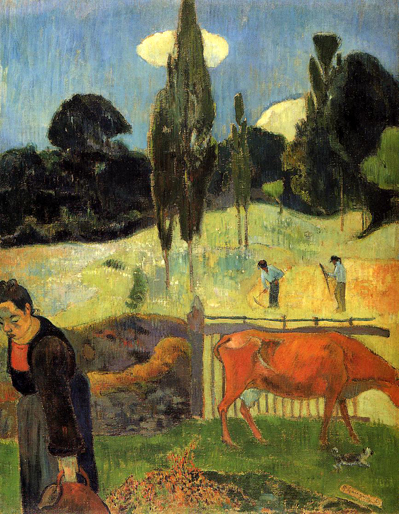
The Red Cow: 1889
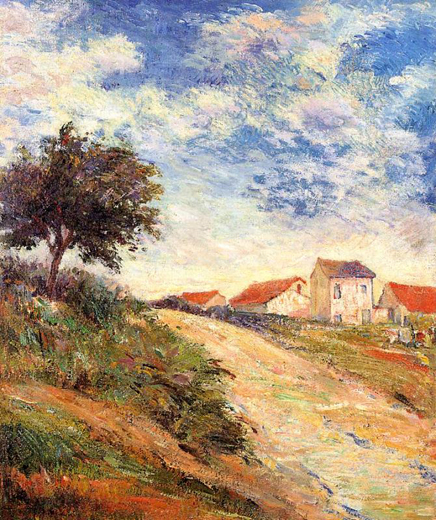
The Road Up: 1884
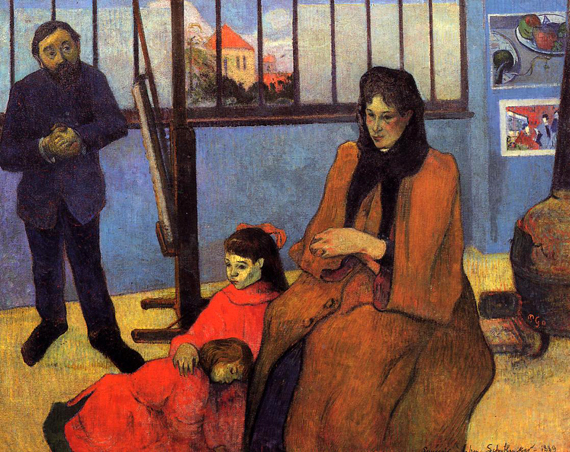
The Schuffenecker Family: 1889
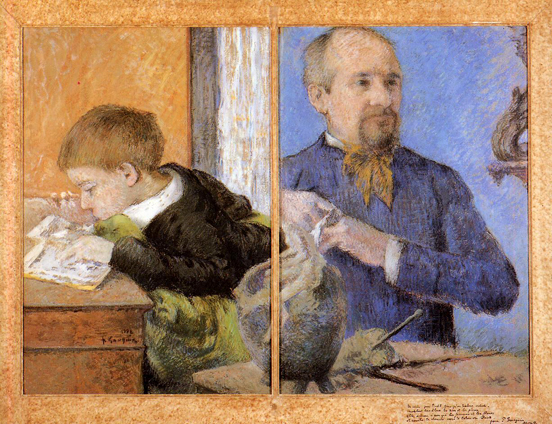
The Sculptor Aube and His Son: 1882

The Seine Opposite the Quai de Passy: 1875
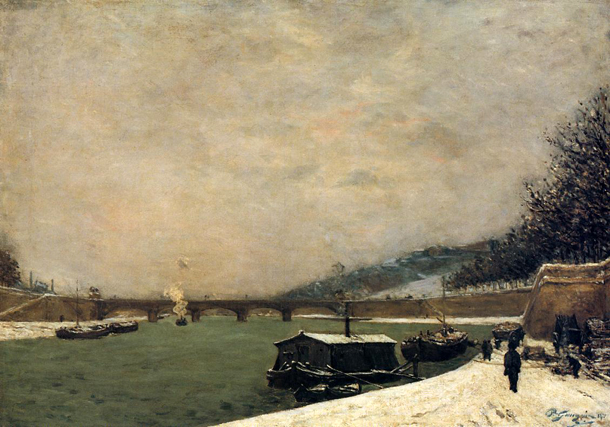
The Seine, Pont d' Iena, Snowing: 1875

The Square Basin
(aka Pond): 1884
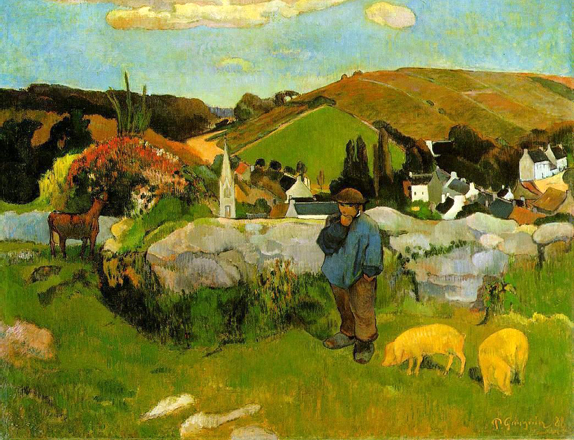
The Swineheard: 1888
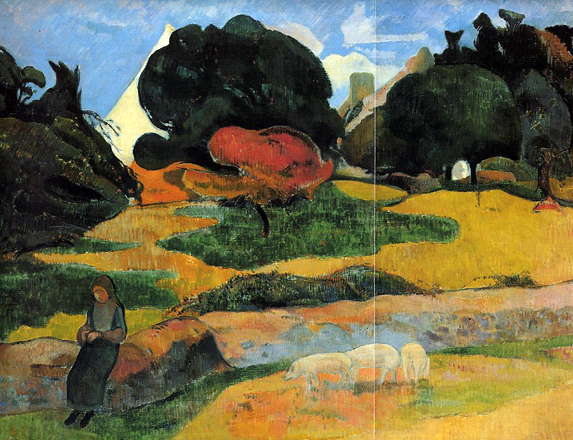
The Swineherd: 1889
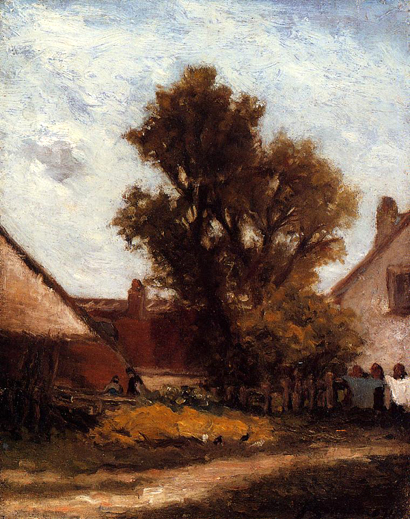
The Tree in the Farm Yard: 1874
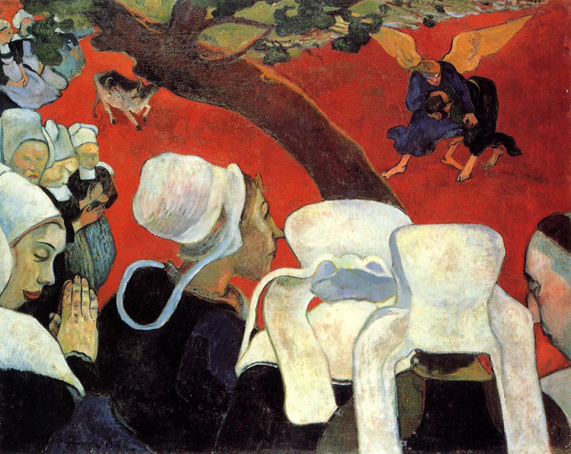
The Vision after the Sermon
(aka Jacob Wrestling the Angel): 1888
As its name suggests, Gauguin's work was concerned with inner rather than external truth. He combined stylized images of Breton figures in a shallow pictorial space with a 'vision' in the top right corner. Thus the 'real' and imagined worlds depicted, are separated by the strong, diagonal of the tree, which was inspired by Japanese prints. Like the Impressionists, Gauguin studied Japanese prints and even adopted their use of bold, flat areas of solid color. The figures are distributed unconventionally, cut off and framing the canvas edge at the left and in the foreground. No identifiable source of light is used, a device which looks forward to developments in Fauvism.
Quoted From: WebMuseum - Vision After the Sermon, Jacob Wrestling with the Angel
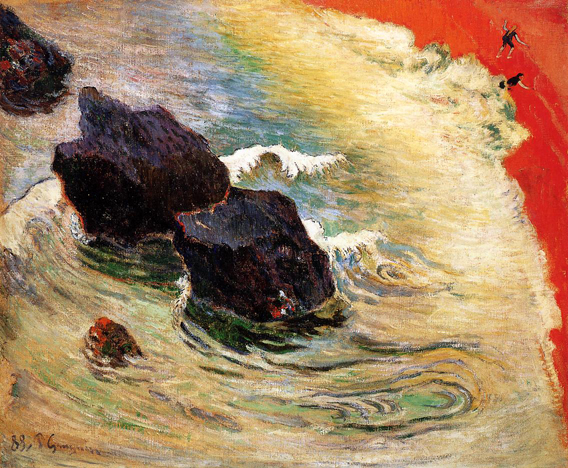
The Wave: 1888
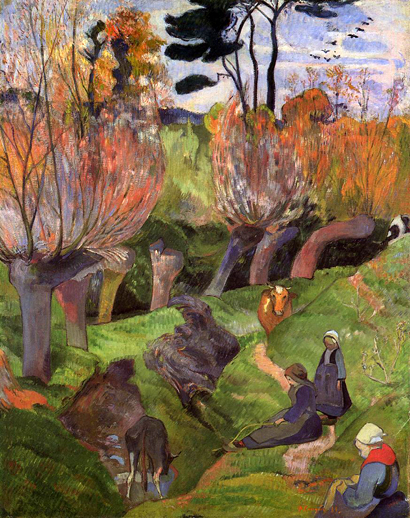
The Willows: 1889
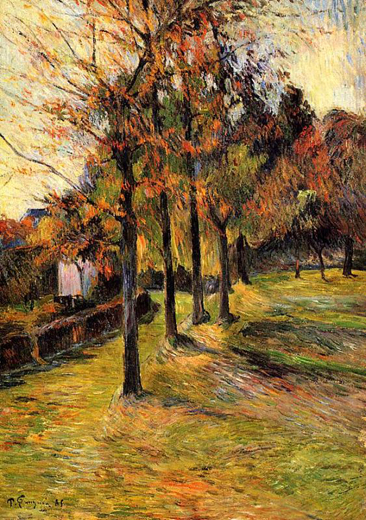
Tree Lined Road, Rouen: 1885
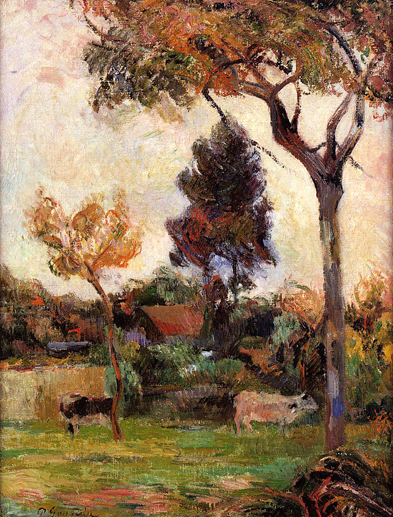
Two Cows in the Meadow: 1884
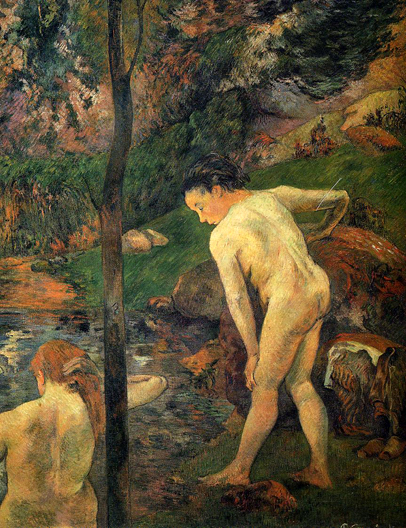
Two Girls Bathing: 1887

Vaugirard Church: 1879
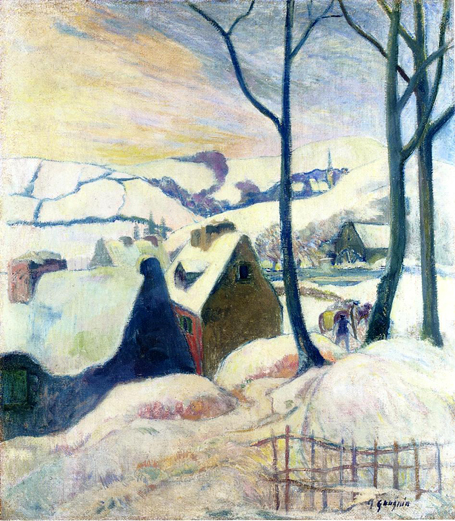
Village in the Snow: 1894
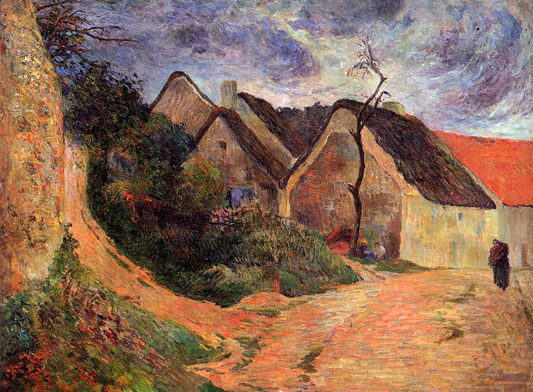
Village Street Osny: 1883
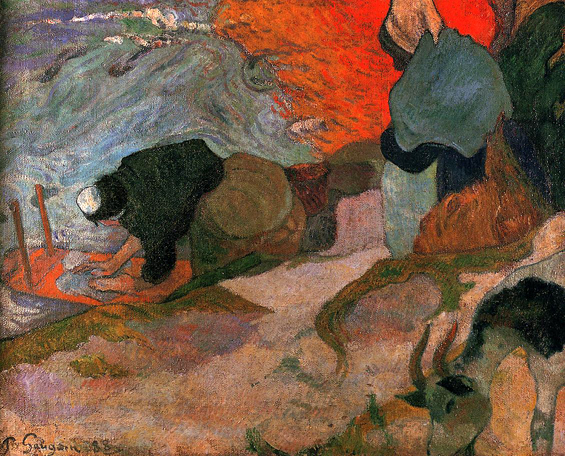
Washerwomen: 1888
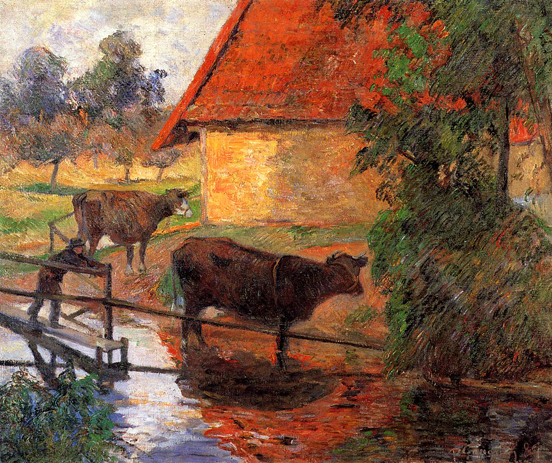
Watering Place: 1885

White House: 1885
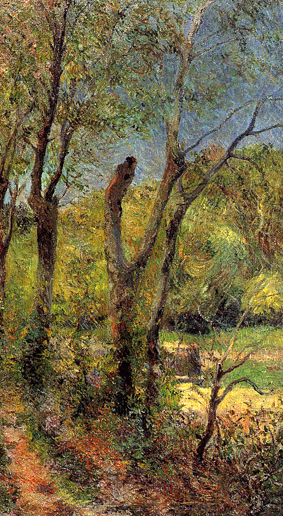
Willows: 1885

Windmil, Ostervold Park: 1885

Winter Landscape, Effect of Snow
(aka Snow at Vaugirard II): 1879

Winter's End: 1885
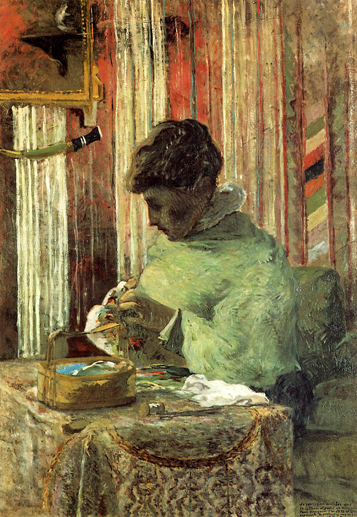
Woman Embroidering: 1878
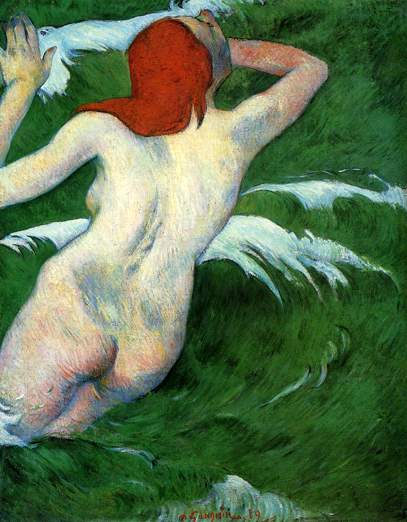
Woman in the Waves
(aka Ondine I): 1889
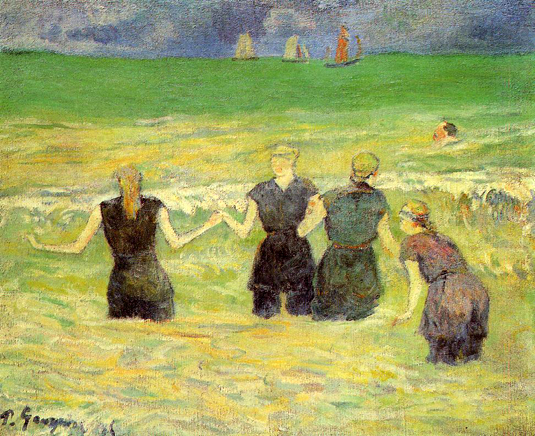
Women Bathing, Dieppe: 1885
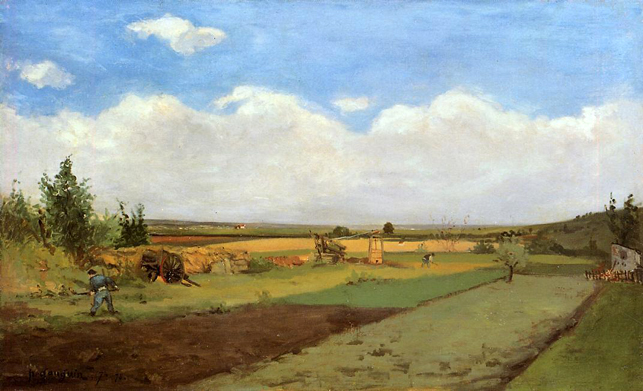
Working the land: 1873
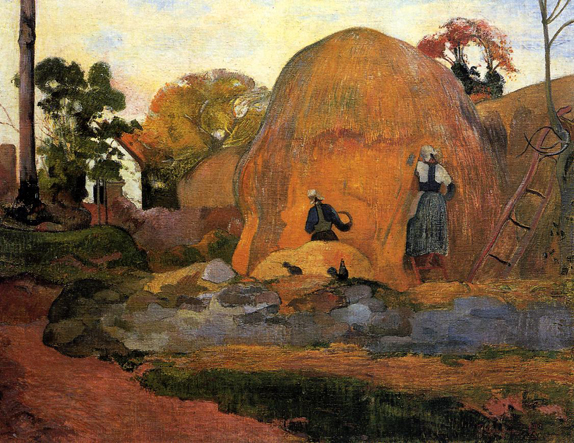
Yellow Haystacks
(aka Golden Harvest): 1889
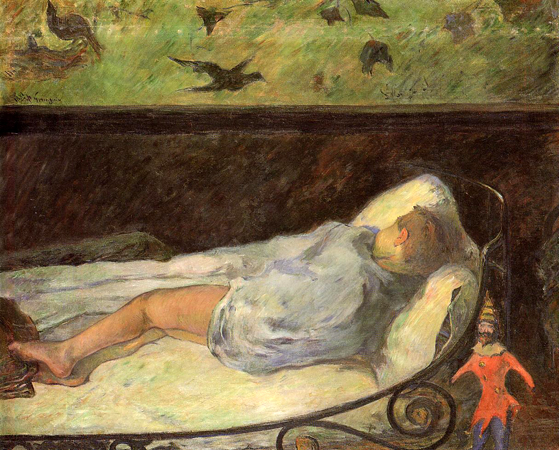
Young Girl Dreaming
(aka Study of a Child Asleep, the Painter's Daughter, line, rue Carcel: 1881
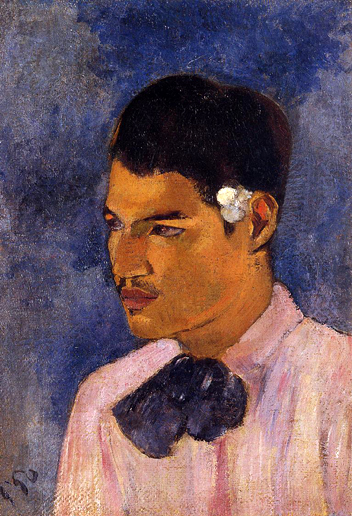
Young Man with a Flower: 1891

Young Woman at a Window: 1888
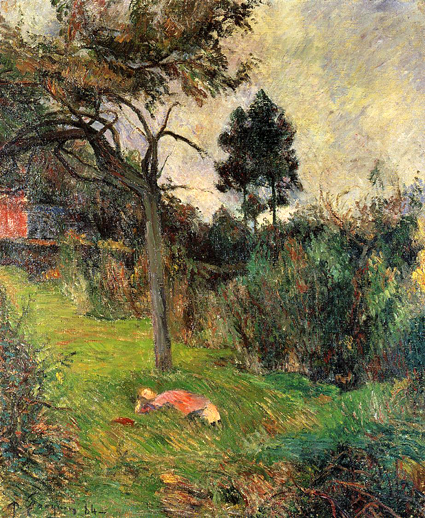
Young Woman Lying in the Grass: 1884
Portraits of Various Individuals

Portrait of a Child, Aline Gauguin: 1877-78
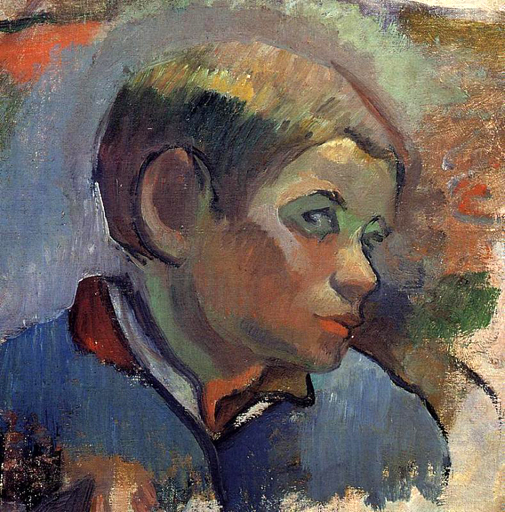
Portrait of a Little Boy: 1888
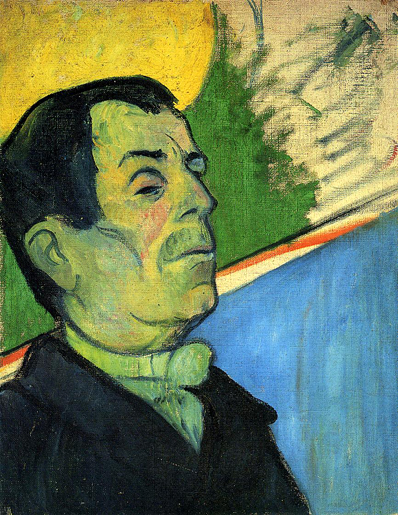
Portrait of a Man Wearing a Lavalliere: 1888

Portrait of a Pont-Aven Woman, Marie Louarn: 1888
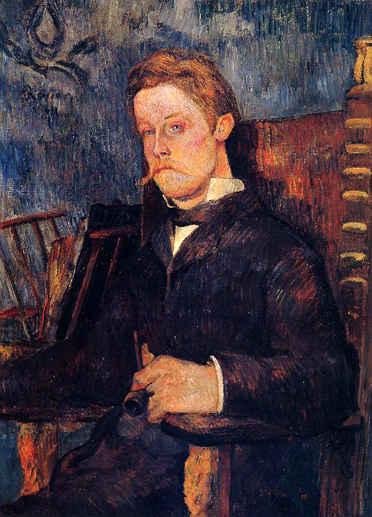
Portrait of a Seated Man: 1884
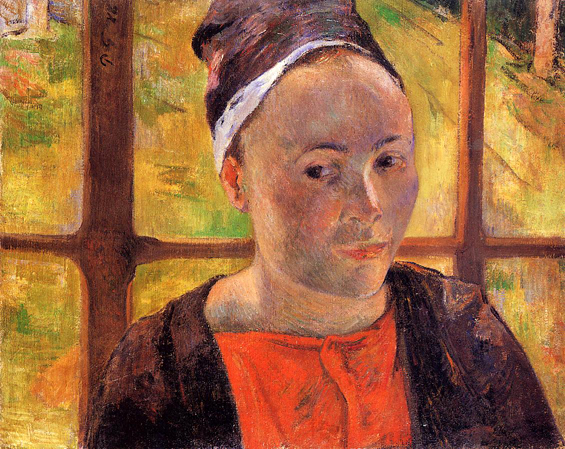
Portrait of a Woman Marie Lagadu: 1888
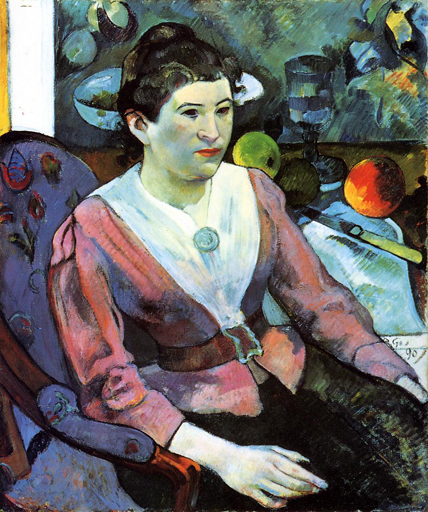
Portrait of a Woman with Cezanne Still Life: 1890
_Goupil_1896.jpg)
Portrait of a Young Woman, Vaite (Jeanne) Goupil: 1896
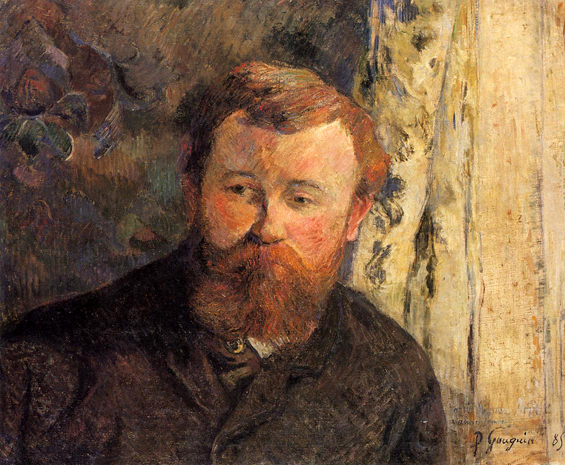
Portrait of Achille Granchi-Taylor: 1885
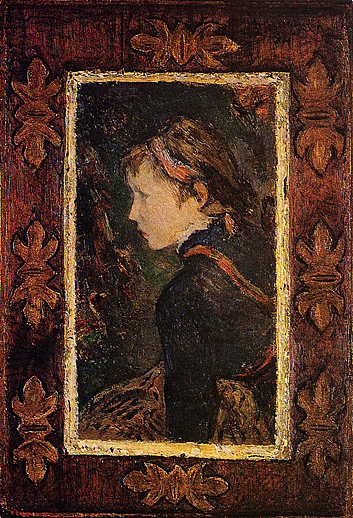
Portrait of Aline: 1884
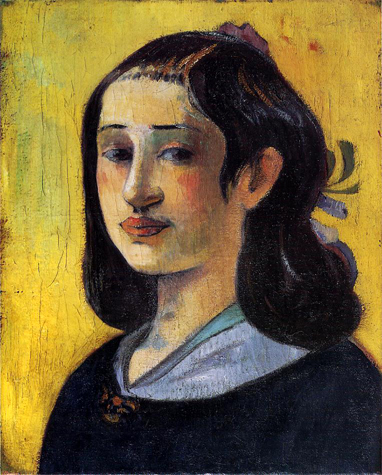
Portrait of Aline Gauguin: 1890
Portrait of Mother: This portrait of his mother, Gauguin painted by a photograph and from memory.
Quoted From: Paul Gauguin - Portrait of Mother
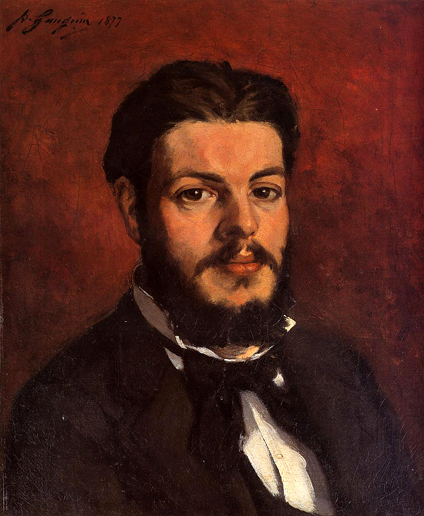
Portrait of Claude Antoine Charles Favre: 1877
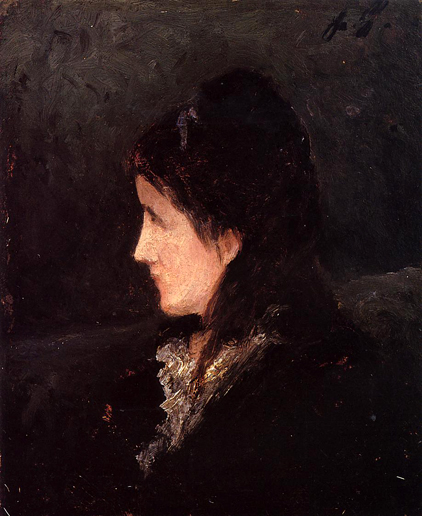
Portrait of Ingeborg Thaulow: 1877
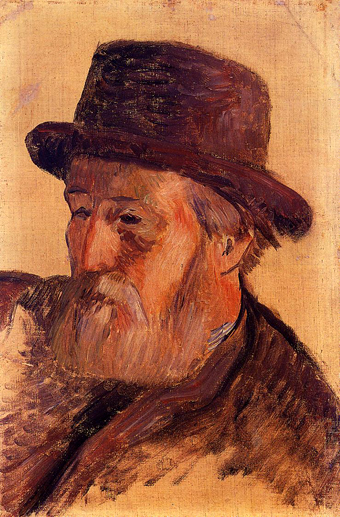
Portrait of Isidore Gauguin: ca 1884
This small portrait head has been identified by Paul Gauguin's son, Pola, as a portrait of the painters' paternal uncle, Henri. Although Pola dated the portrait to 1879 in his certificate of authentication, subsequent scholars have given it a later date of about 1884, presumably on the grounds of style. In fact, neither the identity of the sitter nor the date of the painting can be corroborated with other evidence, and in spite of Pola's certainty of tone, it must be remembered that many of his attributions and dates have not held up to modern scrutiny. Whatever the identity of the sitter, the painting has almost no qualities of a portrait. The man's featureless black eyes project no character and allow the viewer no access. Neither is the figure given any telling details of costume or props that would help us establish his profession or interests. Only his unfashionable hat and simple coat give the portrait character, and that character is generic rather than individual in nature. The slightly hooked nose of the sitter is similar to Gauguin's own, allowing us to infer that the painting represents a member of the family, as Pola asserted. But that is all. The painting appears to be unfinished. It was painted directly on a primed canvas, which Gauguin used almost as a sheet of paper, allowing it to remain as the background. The unusual size and folded corners of the canvas indicate that it may even be a fragment of a larger composition, cut down later to become a portrait. "Impressionist Paintings, Drawings, and Sculpture from the Wendy and Emery Reves Collection," page 72
Quoted From: Dallas Museum of Art - Collections

Portrait of Louis Roy: 1893
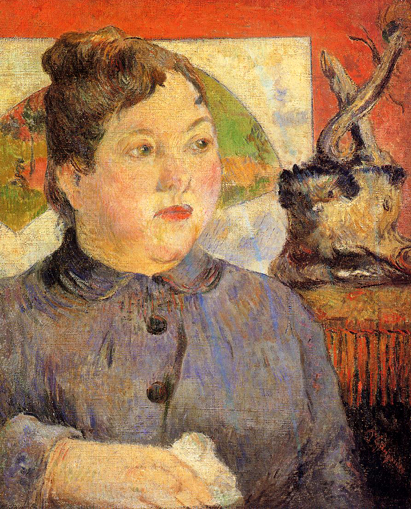
Portrait of Madame Alexander Kholer: 1887
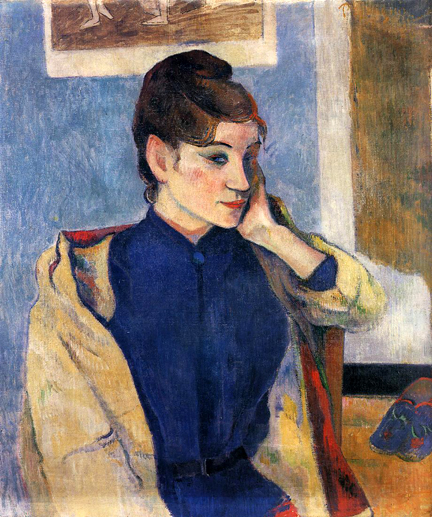
Portrait of Madeline Bernard: 1888
Madeleine Bernard was the sister of the artist Emile Bernard (1868-1941), who first was a friend of Gauguin, then his passionate enemy. Emile Bernard and Paul Gauguin are considered to be the founders of the new post-Impressionist style of "synthetic symbolism".
Quoted From: Paul Gauguin - Madeleine Bernard

Portrait of Philibert Favre: 1885
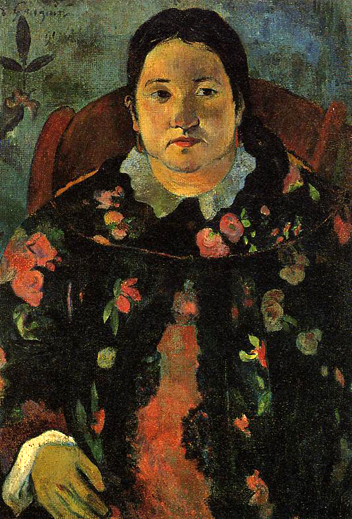
Portrait of Suzanne Bambridge: 1891
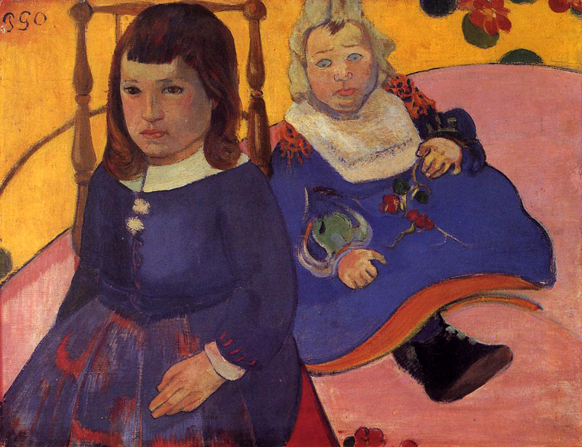
Portrait of Two Children
(aka Paul and Jean Schuffenecker): 1889

Portrait of Vincent van Gogh Painting Sunflowers
(aka Villa Rotunda by Emma Ciardi): 1888

Portrait of William Molard: 1893-94
William Molard, a musician, neighbor of Gauguin in Paris in 1893-94, his admirer and supporter.
Quoted From: Paul Gauguin. Portrait of William Molard
Still Life Paintings

Apples and Bowl: 1888
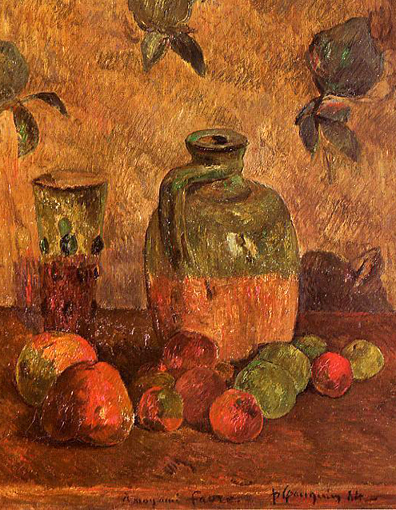
Apples-Jug, Iridescent Glass: 1884
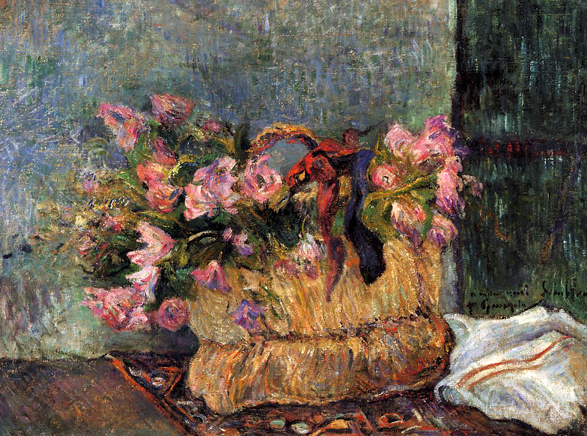
Basket of Flowers: 1884

Bouquet of Flowers: 1882
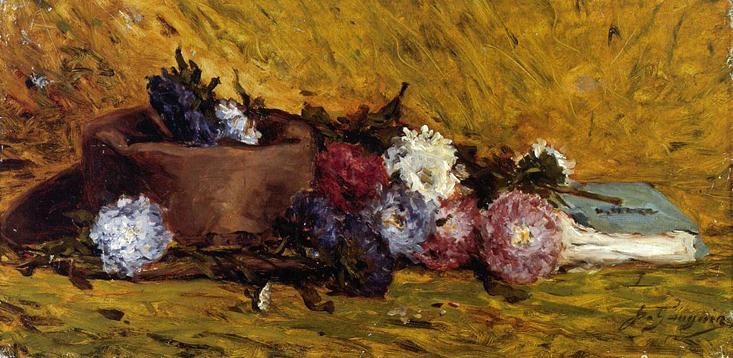
China Asters, Hat and Book: ca 1876

Evening Primroses in a Vase: 1885
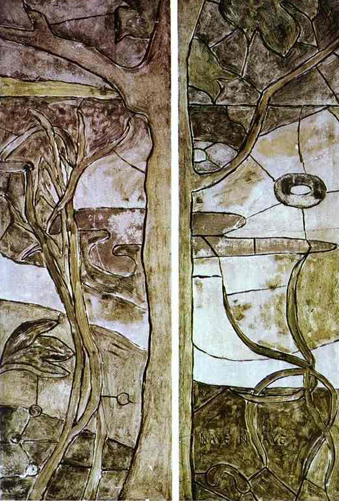
Floral and Vegetable Motifs: 1893

Flower Piece: 1896
A Vase of Flowers
This painting was produced in Tahiti after Gauguin's final move there from France. It was sold by his friend Daniel de Monfried in 1898 to Degas, who was an early admirer of Gauguin's art. Flower paintings were common among the painters of this period; Degas and Van Gogh are among the greatest exponents of the type.
The vase is decorated with only a pattern of gold lines and placed virtually in the centre of the painting, on a wooden ledge where pink and red blooms have fallen. The flowers form a relatively symmetrical pattern with broad blue leaves to each side of cream and red flowers. The muted colors of the background wall and the shelf act as a foil to the exotic flowers that are the central subject of the painting.
Quoted From: (NGA), London, Paul Gauguin - A Vase of Flowers

Flowers and a Bird: 1884-86
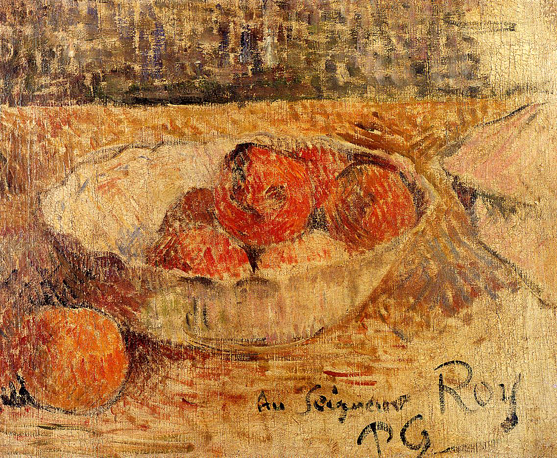
Fruit in a Bowl: 1886
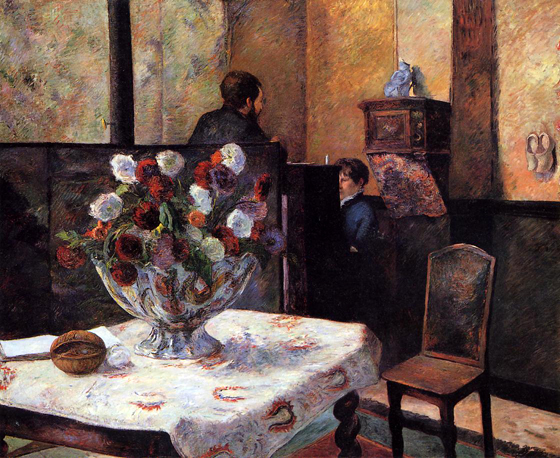
Interior of the Painter's House, rue Carcel: 1881

Lilac Bouquet: 1885

Nasturtiums and Dahlias in a Basket: 1884
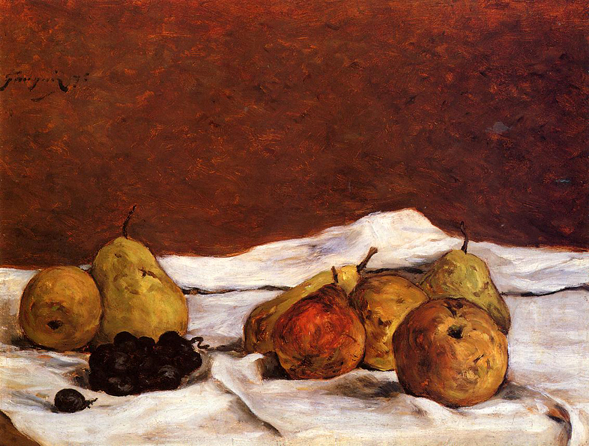
Pears and Grape: ca 1875
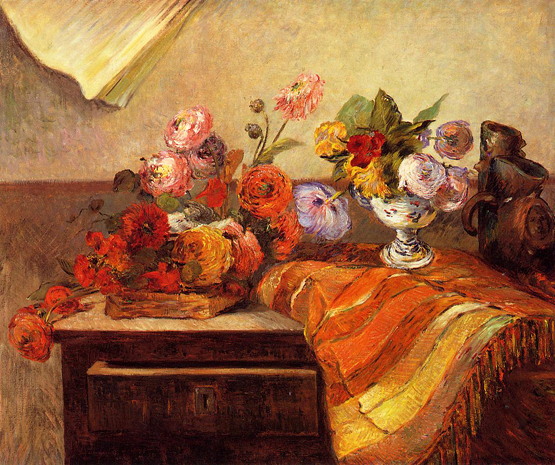
Pots and Bouquets: 1886
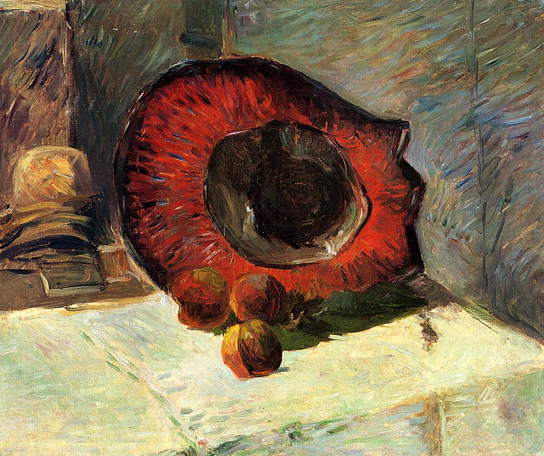
Red Hat: 1886
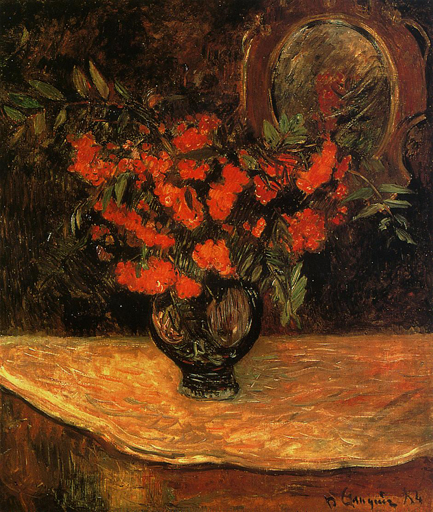
Rowan Bouquet: 1884
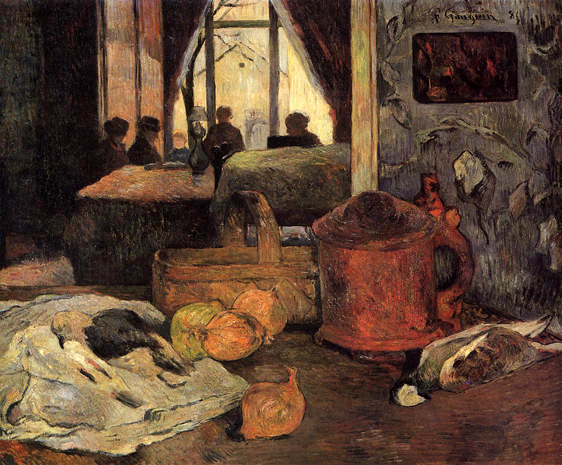
Still Life in an Interior, Copenhagen: 1885
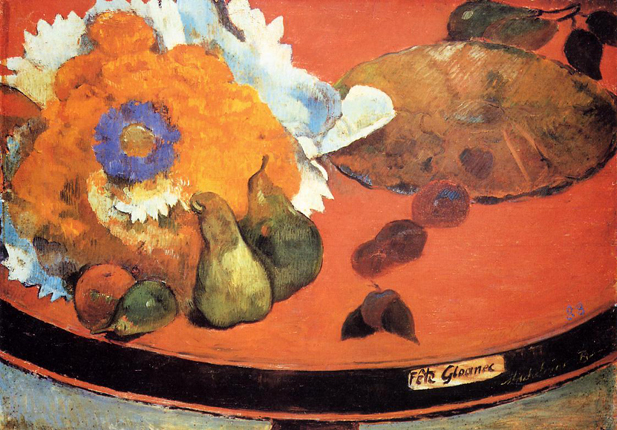
Still Life, Fete Gloanec: 1888

Still, Clay Jug and Iron Mug: 1880
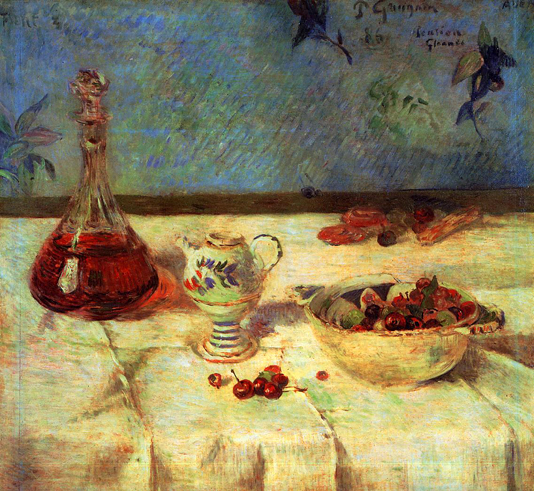
The White Tablecloth
(aka Still Life with Cherries): 1886
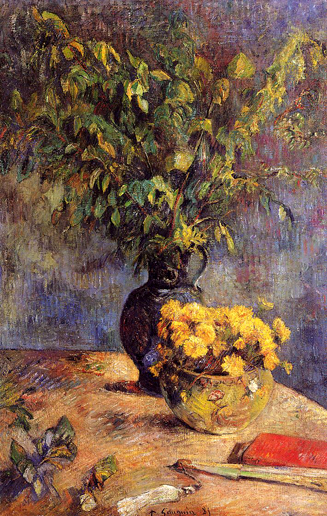
Two Vases of Flowers and a Fan: 1885
Self Portraits of Paul Gauguin

Caricature, Self Portrait: 1889
Gauguin painted many self-portraits, but few are as enigmatic as this one. It was among the work that Gauguin and his student Meyer Isaac de Haan created to decorate the dining room of the inn where they were staying in Le Pouldu, near Pont-Aven. In the six weeks after their arrival in late 1889, they made dozens of ceramic works, woodcarvings, and sculptures, and covered the walls with paintings. This self-portrait, and one Gauguin did of de Haan, were painted on a pair of cupboard doors.
At the time, Gauguin's likeness was described by friends as an "unkind character sketch"-a caricature. Today, it is the subject of intense analysis. Some see the artist casting himself in the role of Satan, others as Christ. What are we to make of the imagery-the apples that precipitate man's fall from grace; the halo over Gauguin's disembodied head; the snake that is both tempter of Eve and the embodiment of knowledge; the bold division into vivid yellow and red, evocative of both hellfire and the heat of creation? Perhaps it is most likely that Gauguin is revealing his conception of the artist as hero, and-almost to challenge his colleagues-of himself, particularly, as a kind of magus, a master who knows that he possesses the power of magic by virtue of talent and genius.
Quoted From: (NGA) - Self-Portrait, 1889
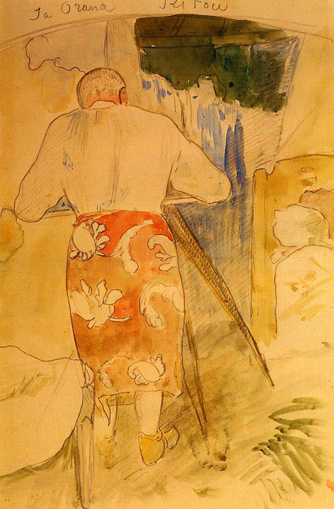
Ja Orana Ritou
(aka Self Portrait of the Artist at His Drawing Table, Tahiti): 1891-94
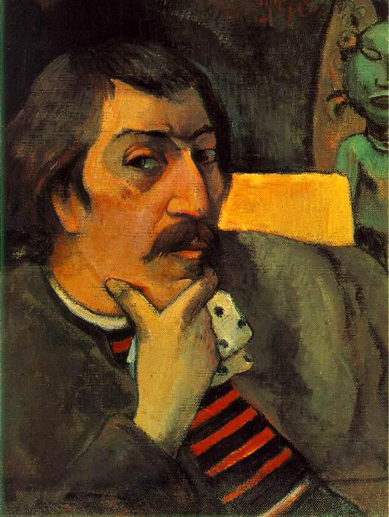
Portrait of the Artist with the Idol: ca 1893

Self Portrait: 1890-99

Self Portrait: 1896

Self Portrait at Lezaven: 1888
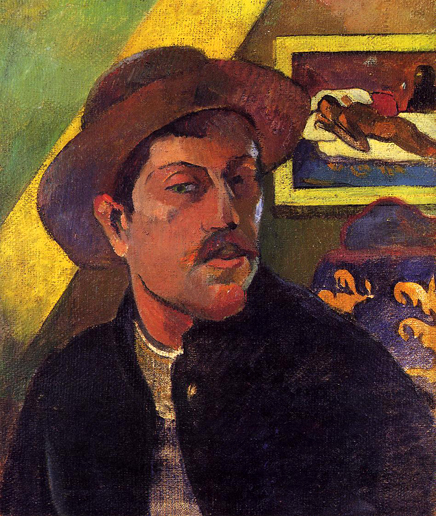
Self Portrait with Hat: 1893-94
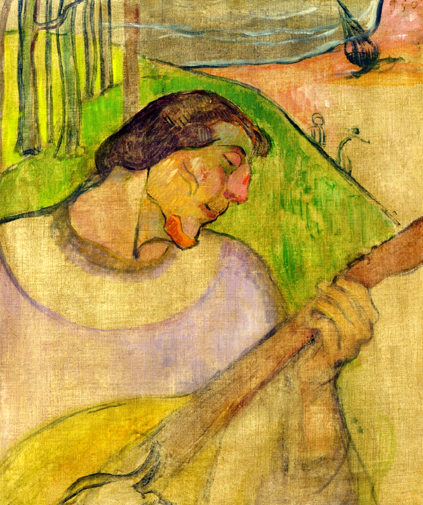
Self Portrait with Mandolin: ca 1889
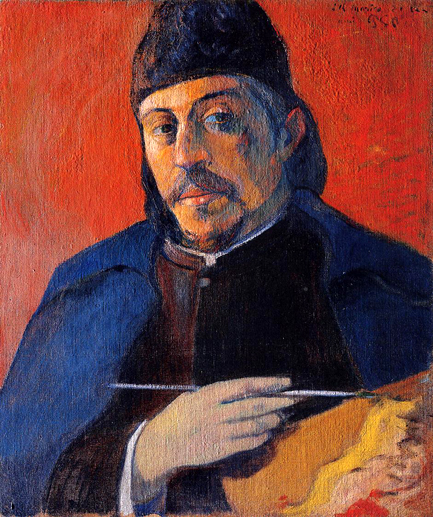
Self Portrait with Palette: ca 1894

Self Portrait with Spectacles: 1903

Self Portrait with Yellow Christ: 1889

Self Portrait, Les Miserables: 1888
Additional Sources:
The Athenaeum - Displaying artworks for Paul Gauguin
WebMuseum: Paul Eugène-Henri Gauguin
NGA, Wasgington DC - Paul Gauguin
National Gallery of Art: London
WebMuseum: Gauguin, (Eugène-Henri-) Paul
Return to Pagina Artis
Return to Bruce and Bobbie's Main Page.